Sites: news | india | latam | brasil | indonesia
Feeds: news | india | latam | brasil | indonesia
topic: Fragmentation
Social media activity version | Lean version
As tree planting gathers pace in Bangkok, urban green spaces still under threat
- Bangkok lags behind global urban green space standards, sparking large-scale tree-planting initiatives across the city.
- Recent research warns that despite these efforts, the city continues to rapidly lose tree cover from its existing green spaces.
- The researchers urge city planners to focus on preserving existing green spaces and mature trees, while also ensuring big-budget tree-planting initiatives prioritize the ecosystem value and long-term survival of their plantings.
- Making such improvements will help the city address issues around access to green space, urban food security and climate resilience, the authors say.
Bangladesh protects sacred forests to strengthen biodiversity conservation
- Bangladesh is making a list of sacred forests, aged trees and other socially important flora in a bid to strengthen forest conservation.
- The need for conservation of these fragmented forest patches has been neglected for a long time despite being mentioned in the country’s 2012 Wildlife (Conservation and Protection) Law. However, the issue is now finally being looked into.
- Conservationists welcome the initiative and say they believe that the new measures will help protect the biodiversity and ecology that had been set aside in the past.
Concrete sprawl in Buddha’s birthplace in Nepal threatens sarus cranes
- Sarus cranes, once abundant in Lumbini, the birthplace of the Buddha, are rapidly declining due to unplanned urbanization, wetland loss and habitat degradation, with local elders recalling their disappearance from areas that were once full of ponds and farmland.
- A recent survey found that 59% of respondents believe the crane’s range has shrunk, citing habitat loss (44%), hunting (19%) and wetland degradation (16%) as key threats to the bird.
- Lumbini province hosts Nepal’s largest population of sarus cranes, but only four pairs remain within the 200-hectare (500-acre) Lumbini gardens that constitute a popular pilgrimage site and have seen a surge in the built-up area
In Cameroon’s forgotten forests, gorillas and chimps hang on
- Many forest reserves in southern Cameroon, despite being highly degraded and fragmented, harbor significant biodiversity.
- A recent study using camera traps in two such forest reserves captured the first evidence of great apes — a gorilla and several chimpanzees — foraging in and navigating the mosaic of fragmented landscapes.
- Some of the videos show apes and humans using the same parts of the forests at different times, highlighting the risk of human-ape conflicts that could impact the already threatened great apes.
- Conservationists say the presence of great apes outside protected areas indicates the need to protect these areas, and that further research is needed to understand how great apes use fragmented landscapes close to human communities.
Action plan aims to save Asia’s leaf-eating monkeys amid ‘alarming’ declines
- A new conservation plan aims to halt the decline of langur monkeys in Southeast Asia, where habitat loss and poaching have severely reduced their numbers.
- The 10-year Asian Langurs Conservation Action Plan focuses on the six countries in the Sundaland biodiversity hotspot, a region known for its astonishing range of habitats and species.
- Based on insights from leading primatologists, the plan prioritizes measures needed to safeguard 28 species and subspecies of langurs.
- Key goals include strengthening and enforcing existing wildlife laws, reducing demand for langurs and their body parts, and raising awareness about their protected status and cultural and ecological importance.
‘Shocking’ mortality of infant macaques points to dangers of oil palm plantations
- As oil palm plantations encroach on rainforests, wild primates increasingly enter them to forage, where they face the threat of being eaten by feral dogs, killed for raiding crops, or caught by traffickers for the pet trade.
- A new study from Peninsular Malaysia finds that exposure to oil plantations also significantly increases the risk of death among infant southern pig-tailed macaques.
- In addition to known threats, researchers speculate common pesticides used in oil palm plantations might play a role in the increased death risks for infant macaques, but their study stops short of providing direct evidence implicating any specific toxic chemical in these deaths.
- Conservationists call for using environmentally safe and wildlife-friendly agricultural practices in oil plantations to minimize risks and establishing wildlife corridors and tree islands so that endangered primates, like southern pig-tailed macaques, can move freely without being exposed to threats.
Study: Indonesia’s new capital city threatens stable proboscis monkey population
- A recent study warns that the ongoing construction of Indonesia’s new capital city on the island of Borneo could destabilize the population of endangered proboscis monkeys currently thriving in the area.
- President Joko Widodo has characterized the development as green and with a minimal environmental impact, but concerns have arisen over the potential threat to the nearby Balikpapan Bay mangrove ecosystem that’s home to proboscis monkeys and other threatened wildlife.
- Scientists have advocated for sustainable development practices and emphasized the importance of respecting local biodiversity while constructing the new city, Nusantara.
- Their recommendations include legal protection for affected areas, habitat restoration, and collaboration with local stakeholders to mitigate the environmental impact.
Oil palms may be magnet for macaques, boars, at expense of other biodiversity
- A new study documents the “hyperabundance” of two generalist mammals around oil palm plantations in Southeast Asia, highlighting the indirect ecological impacts of oil palm expansion across the region.
- The research team found local numbers of wild pigs and macaques “exploded” in proximity to oil palm plantations, where they believe the animals derive enormous fitness benefits by consuming high-calorie palm fruit.
- Scientists caution that while these species can aggregate in some areas, their overall numbers are in decline due to a wide range of threats, including habitat loss, environmental degradation, disease outbreak, and poaching for the pet trade and biomedical research.
- The researchers call for the establishment of buffer zones around oil palm plantations and avoiding encroachment into intact forest as a way to address any problems arising from negative human-wildlife interactions and ecological impacts.
Flooding for hydropower dams hits forest-reliant bats hard, study shows
- Researchers have found that bats specialized to feed on insects within the dense canopy of tropical forests are disproportionately affected by hydropower development.
- The study in Peninsular Malaysia adds to a growing body of evidence demonstrating how hydropower developments impoverish tropical ecosystems.
- Although forest-specialist bats were lost from the flooded landscape, bats that forage along forest edges and in open space were still present.
- To minimize localized extinctions, the researchers advocate a preventive rather than mitigative approach to hydropower planning that prioritizes habitat connectivity and avoids creating isolated forest patches.
Lack of large prey may be feeding rise in Nepal’s human-tiger conflicts
- Nepal has been lauded for its success in nearly tripling its wild tiger population in the past 12 years, but a consequence of that has been an increase in human-tiger conflicts.
- One factor for this is the lack of large-sized prey for the big cats in Bardiya National Park, home to a third of Nepal’s 355 tigers.
- Tigers here frequently prey on livestock in nearby human settlements, unlike the tigers in Parsa National Park, where large prey abound.
- Conservationists have called for efforts to reintroduce or boost large prey populations in tiger habitats, including through translocation programs — although previous attempts at these haven’t proved successful.
Indonesia’s new capital ‘won’t sacrifice the environment’: Q&A with Nusantara’s Myrna Asnawati Safitri
- The ongoing development of an entirely new capital city from the ground up in Indonesia has alarmed environmental and Indigenous rights activists, who have warned of both deep ecosystem and social impacts.
- The government has justified the plan to move the nation’s capital from Jakarta, on the island of Java, to Indonesia Borneo as a way of ensuring a greater share of development beyond the country’s western islands.
- Mongabay has already reported on the risks to the wider Bornean region and the additional pressures on marine ecosystems that are a biodiversity haven.
- In response, Myrna Asnawati Safitri, the deputy for environment and natural resources at the government agency overseeing the development, reached out for an exclusive interview where these and other thorny questions were addressed.
To build its ‘green’ capital city, Indonesia runs a road through a biodiverse forest
- A new toll road in Indonesia’s East Kalimantan province is under construction to improve access to the interior of Borneo, including to the nation’s new capital city, Nusantara.
- Construction of the road, however, poses immediate environmental risks, as the route cuts through a forested area with high conservation value that connects the Sungai Wain protected forest, coastal mangroves, and Balikpapan Bay.
- Prior to road construction, the integrated forest and coastal ecosystem supported populations of orangutans, sun bears, proboscis monkeys and Irrawaddy dolphins.
- Conservationists say the construction of this toll road belies the Indonesian government’s claims that the development of the new capital will be green and sustainable.
As Indonesia’s new capital takes shape, risks to wider Borneo come into focus
- Indonesia’s plan to build its new capital city on an expiring logging concession in eastern Borneo has sparked concerns among environmental and human rights observers about the larger eco-social impacts to the rest of the island.
- The administration of President Joko Widodo, who made the decision and will leave office next year, has made glowing promises of a green and sustainable development: claiming minimal forest clearance, respect for Indigenous and local communities’ rights, and a net-zero carbon emission design.
- Mongabay visited the site of the project last October to see its progress, observe firsthand some of the earliest impacts from the construction of the city and supporting infrastructure, and speak with the people most likely to be affected.
- Clearing of mangroves and high-conservation forest areas, land conflicts with Indigenous communities, and potentially large-scale displacements are already happening, calling into question whether the $34 billion project’s benefits will outweigh its downsides.
Deforestation threatens local populations in Republic of Congo’s Sangha
- Between May 2021 and November 2022, more than 200,000 deforestation alerts were recorded around Ouesso, in the northwestern Republic of the Congo.
- Logging has drastically impacted the country’s forest cover.
- In 2016, the Congolese authorities awarded 2 million hectares (4.9 million acres) of logging concessions to businesses, the majority of which had broken environmental and social standards.
- More recently, mining by Chinese companies (the land in north-west Congo is rich in iron and gold) has accelerated the destruction of ecosystems.
Mangroves and wildlife in Bornean bay at risk from Indonesia’s new capital
- Experts and activists say the construction of Indonesia’s new capital city upstream of Balikpapan Bay on the island of Borneo fails to mitigate against damage to the marine ecosystem.
- The stretch of coast between the bay and the mouth of the Mahakam River is packed with mangroves, which host a rich diversity of marine and terrestrial life, including proboscis monkeys and Irrawaddy dolphins.
- The government has said the construction of the new capital, Nusantara, will include retaining a large swath of mangrove forest, but zoning details show most of it won’t be protected against development.
- The $33 billion planned city will in 2024 take over as the Indonesian capital from Jakarta, and its full construction will be completed by 2045, according to the government’s plans.
Small mammals stranded by hydropower dams die out surprisingly fast: Study
- Forest fragmentation has long been known to impact species survival: small, isolated populations with access to limited resources are at greater risk of extinction.
- In 1987, the Chiew Larn reservoir was formed in southern Thailand as part of a hydropower scheme, creating more than 100 forested islands inhabited by newly stranded animals.
- A new study documents the alarmingly quick collapse of the reservoir archipelago’s small mammal communities, resulting in the loss of nearly every species and dominance by one invasive rodent.
- Tropical biologists warn the study reflects the global trend of fragmentation in tropical forests, which is ravaging both species diversity and ecosystem resilience.
End old-growth logging in carbon-rich ‘crown jewel’ of U.S. forests: Study
- A recent study of the Tongass National Forest, the largest in the United States, found that it contains 20% of the carbon held in the entire national forest system.
- In addition to keeping the equivalent of about a year and a half of the U.S.’s greenhouse gas emissions out of the atmosphere, the forest is also home to an array of wildlife, including bald eagles, brown bears and six species of salmon and trout.
- Scientists and conservationists argue that the forest’s old-growth trees that are hundreds of years old should be protected from logging.
- They are also hoping that efforts by the administration of President Joe Biden are successful in banning the construction of new roads in the Tongass.
Trees and soil at the forest’s edge store more carbon than we thought, studies reveal
- Scientists investigated the differences in carbon storage of trees and soils along forest edges versus the interiors of temperate forests in the northeastern United States.
- They found that trees within 30 meters (100 feet) of the forest edge grow almost twice as fast as trees deeper in the forest interior, meaning the edge trees are pulling carbon from the atmosphere and storing it in their tissues at a faster rate.
- In urban areas, soil released 25% less carbon on the forest edge relative to the interior. Worldwide, more carbon is stored in the soil than in all aboveground plants, animals, and the atmosphere combined, so understanding the soil is an important part of the carbon equation.
- While this spells good news for the potential of forest fragments to combat climate change, the researchers made it clear that this is not an argument in favor of creating more fragments as a way to sequester more carbon, stating that “forest that is lost will always outweigh gains made from growth increases in the new edges.”
Malaysia’s white-handed gibbons may be two subspecies, not one, study shows
- Scientists sequencing the genes of white-handed gibbons of the Malaysian subspecies (Hylobates lar lar) have discovered unusual mutations that hint at the existence of a separately evolving population in the peninsula.
- This particular population is so genetically different, it could potentially qualify as a new and distinct subspecies, the researchers said.
- For scientists looking to translocate and reintroduce captive gibbons into the forest, knowing the finer details like which subspecies and population a particular animal originated from can help reduce interbreeding and ensure the gibbons stay healthy in the long run.
- For researchers looking to differentiate between gibbons of the same subspecies, focusing on a particular segment of mitochondrial DNA can be a powerful method for pinpointing the population an animal originated from.
Greater Mekong primates struggle to cling on amid persistent threats: Report
- The Greater Mekong region is home to 44 species of non-human primates, including gibbons, lorises, langurs, macaques and snub-nosed monkeys, several of which were first described within the last few years.
- Habitat loss and hunting driven by the wildlife trade and consumption have driven many of the region’s primates to the brink of extinction, with many species now only existing as tiny populations in isolated, fragmented pockets of habitat.
- Experts say controlling the illegal wildlife trade is complicated by the presence of legal markets for primates, often for use in biomedical research.
- Despite the challenges, conservation action at local levels is achieving results for some primate species in the region while also enhancing livelihoods and ecosystem services for local communities.
E.O. Wilson’s last dream
- On December 26, 2021, biologist and author Edward O. Wilson died in Burlington, Massachusetts at the age of 92.
- Routinely compared to Darwin E.O. Wilson is renowned for his work on evolution, biogeography, sociobiology and myrmecology—the study of ants.
- Wilson devoted the last few years of this life to the concept of “Half-Earth”, which he saw as a way to stave off mass extinction, ecological collapse, and create a panacea for climate change.
- In this piece, author Jeremy Hance recounts a 2017 conversation with Wilson and what could be his greatest legacy: the idea of protecting half the planet in a natural or regenerating state for the benefit of people and nature.
‘Thousands of trees’ burned and logged in Cambodia: Q&A with filmmaker Sean Gallagher
- In 2020, filmmaker Sean Gallagher released a short film titled “Cambodia Burning,” which looks at the burning and logging of Cambodia’s forests to make way for agricultural development.
- The Cambodian government has claimed that no large-scale deforestation is happening in the country’s protected areas, but Gallagher says he filmed illegal logging taking place directly inside the confines of Prey Lang Wildlife Sanctuary.
- Cambodia lost an estimated 2.7 million hectares (6.7 million acres) of forest between 2001 and 2019, accounting for 26.4% of the forest cover that existed in 2000, according to a new report.
- Activists working to protect Cambodia’s remaining forests have faced threats, intimidation and incarceration.
Tigers, jaguars under threat from tropical hydropower projects: Study
- A new study reveals that more than one-fifth of the world’s tigers and one in 200 jaguars have been affected by habitat loss linked to hydropower projects.
- Land flooded for hydroelectric reservoirs has resulted in the substantial loss of habitat for both top predators, and future hydropower projects planned within the species’ ranges fail to consider the big cats’ long-term survival, the study says.
- Scientists struggle to track the fate of tigers and jaguars displaced by hydropower reservoirs, but their chances of survival are very low, according to the study’s authors.
- The researchers recommend that policymakers minimize the impacts of future hydropower projects by avoiding landscapes deemed high priority for conservation.
Starving and injured Sumatran tiger dies in captivity, Indonesian officials report
- A severely injured and emaciated Sumatran tiger has died in captivity after being captured from the wild, Indonesian conservation authorities reported.
- The adult female tiger was caught following a series of deadly tiger attacks on villagers living near Kerinci Seblat National Park.
- Conservation authorities speculate an outbreak of African swine fever that has affected the area’s population of wild boars likely forced the tigers to roam farther from the forests and into human settlements in search of food.
- Fewer than 400 Sumatran tigers remain in the wild, with the big cat’s population plunging in line with widespread destruction of its forest habitat, primarily due to logging and expanding oil palm and pulpwood plantations.
Infrastructure projects in Congo Basin need greater oversight, report says
- A new report by Rainforest Foundation UK says that new transport and energy infrastructure projects in the Congo Basin do not adequately account for their full environmental and social impact and may lead to irreversible degradation of this vital forest region.
- RFUK is calling for regional governments and international lenders to take a more robust and transparent approach to managing the environmental impacts of infrastructure projects to ensure that needed development takes place in a sustainable way.
- The report says infrastructure projects often conflict with the goals of REDD+ projects, and their negative impacts are not properly accounted for.
- Denis Sonwa from the Center for International Forestry Research (CIFOR), who is unaffiliated with the RFUK report, says the REDD+ schemes add weight and legitimacy to the forest sector in negotiations over infrastructure projects.
A bridge of trees reunites gibbons separated by a railway line in India
- For the hoolock gibbons of India’s Hoollongapar Gibbon Sanctuary, a rail line bisecting the forest has for decades proved an impassable barrier, dividing the animals into two separate areas.
- In 2006, conservationists, the local forest department and communities began planting thousands of trees along the tracks in an effort to create a natural canopy bridge.
- The tree-planting effort finally bore fruit in 2019, when the first gibbons were observed crossing over the tracks.
- This year, an entire family has been observed making use of the bridge.
On islands that inspired theory of evolution, deforestation cuts uneven path
- The Wallacea region spans Indonesia’s central islands where the biota of Asia and Australasia meet, making it one of the world’s most valuable centers of endemism, home to scores of species found nowhere else on Earth.
- With development pressure expected to escalate over the coming decades, identifying which of the region’s tracts of forest are most at risk is key to preserving its unique biodiversity.
- A new study that models future deforestation risk across the region has found that coastal, small and unprotected biodiversity sites are most at risk, with North Maluku and Central Sulawesi projected to lose significant tracts of forest by 2053.
- The researchers say their results can be used to target programs, such as social forestry, to sites where they will have optimal impact for biodiversity and communities.
Maleos bounce back in Sulawesi after villagers resolve to protect their eggs
- The maleo (Macrocephalon maleo), an endangered bird endemic to Sulawesi, Indonesia, lays a single gigantic egg in a hole that is then incubated solely by the geothermal heat in the sand or soil.
- Maleo eggs are prized as a high-status delicacy and are frequently dug up to be eaten or sold illegally online, consequently pushing maleo populations into rapid decline.
- Two community-led projects that protect maleo nesting grounds from poaching and ensure maleos can nest naturally have reported the first sustained increases in maleo numbers due to conservation efforts.
- The projects have quadrupled and tripled local maleo numbers over a 14-year and five-year period, respectively, and experts are calling for other maleo conservation projects across Sulawesi to adopt this community-led, low-intervention method.
There’s still room to save Asia’s hoolock gibbons, study says, but only just
- Hoolock gibbon habitat has declined in the past few decades, but enough suitable patches exist today to guarantee the long-term survival of the genus if properly conserved.
- Particular populations are at greater risk of local extinction and should be translocated, including scattered western hoolock populations in Bangladesh.
- Researchers have also identified strongholds where a relatively high number of hoolock gibbons have been estimated, and which are currently highly threatened, to be prioritized for conservation.
- Hoolock gibbons are particularly vulnerable to forest fragmentation and degradation due to certain behavioral traits, which makes protecting large patches of habitat much more effective than conserving many small and fragmented areas.
Philippines’ rich bird life is more threatened than we thought, study says
- The Philippines supports extraordinary avian diversity: 86 new endemic bird species have been described in the country in just the last decade.
- Nevertheless, the country’s currently known 594 bird species depend on forests, grasslands and wetlands that are rapidly disappearing.
- A new study suggests that even more species are at risk than previously thought, finding 84 species are at greater risk than indicated by their current IUCN Red List status.
- Results also indicate that endemism, narrower elevational range, high forest dependency, and larger body size make it likelier that a species will go extinct.
In the Colombian Andes, a forest corridor staves off species extinction
- Recognized as one of the world’s most biodiverse regions, the tropical Andes host more than 10% of the planet’s biodiversity — roughly two million species of plants, animals, fungi and microorganisms — of which only 10% have been identified.
- This precious ecosystem is in peril because, in the past few decades, 75% of natural habitat has been lost largely to agricultural expansion.
- La Mesenia-Paramillo Nature Reserve in the Colombian Andes is attempting to stave off the threat by restoring 3,500 hectares (8,650 acres) of degraded land and connecting about 100,000 hectares (247,000 acres) of intact forest with the main Andean chain as a habitat corridor.
Protected areas now cover nearly 17% of Earth’s surface: U.N. report
- A new report from the United Nations Environment Programme and the International Union for Conservation of Nature reveals that countries are closing in on the target set in 2010 of protecting or conserving 17% of the Earth’s surface.
- Since 2010, the area of the marine environment that’s under protection has more than tripled, although global coverage is less than 8%, falling short of the 10% goal set in Aichi Target 11.
- While there has been some success, international leaders agree there should be more focus on quality as well as quantity in designating protected and conservation areas.
- As the U.N. Biodiversity Conference scheduled for October 2021 in Kunming, China, approaches, the report calls for a stronger emphasis on the contributions of Indigenous and local communities, while also ensuring that the world’s poorest don’t shoulder an outsize burden from these efforts.
Smallholder agriculture cuts into key Sumatran tiger habitat
- Satellite data show several surges in deforestation in Kerinci Seblat National Park in 2020.
- Kerinci Seblat provides vital habitat for critically endangered Sumatran tigers, as well as many other species.
- The primary driver of this deforestation appears to be the expansion of small farms.
- Initiatives in the area are attempting to reduce smallholder expansion by encouraging the adoption of more sustainable farming practices.
Forest degradation outpaces deforestation in the Brazilian Amazon: Study
- Brazilian Amazon deforestation rates have declined from, and stayed below, their 2003 peak, despite recent increases. However, this decline was offset by a trend of increased forest degradation, according to an analysis of 23 years of satellite data. By 2014, the rate of degradation overtook deforestation, driven by increases in logging and understory burning.
- During the 1992-2014 study period, 337,427 square kilometers suffered a loss of vegetation, compared to 308,311 square kilometers completely cleared, a finding that has serious implications for global greenhouse gas emissions and biodiversity loss.
- Forest degradation has been connected to outbreaks of infectious diseases as a result of increased contact between humans and displaced wildlife. Degradation can also facilitate the emergence of new diseases and some experts warn that the Amazon could be the source of the next pandemic.
- These findings could have major implications for Brazilian national commitments to the Paris Climate Agreement, as well as international agreements and initiatives such as the Aichi Biodiversity Targets and REDD+, which rely on forest degradation monitoring.
Study revealing New Guinea’s plant life ‘first step’ toward protection
- A recent study in the journal Nature found that New Guinea has more plant species than any other island on Earth.
- The island has more than 13,000 species of plants, more than two-thirds of which live only in New Guinea.
- The island’s forests are relatively intact, and researchers say the list of species is a step toward protecting them from the looming threats of large-scale agriculture, logging and road building.
Turtles and tortoises in trouble: More than half of all species face extinction
- More than half of the world’s turtle and tortoise species are now threatened with extinction, according to a new study published by a group of 51 global turtle and tortoise experts.
- Loss of habitat is the biggest threat to turtles and tortoises globally. Other threats include the pet trade, overconsumption for food and medicine, pollution, invasive species, and climate change.
- Preventing turtle extinctions this century requires protecting their remaining habitat, the authors write, particularly limited nesting habitats.
- Individuals also have a role to play in safeguarding turtle and tortoise survival worldwide by being aware of the risks involved in the pet, food and medicine trades, keeping dogs under control in important turtle habitats, and keeping off-road vehicles away from sensitive beaches and desert areas where turtles roam and nest.
Experts see environmental, social fallout in Indonesia’s infrastructure push
- The Indonesian government has announced a list of 89 priority projects, tagged at $100 billion, to jump-start the economy out of the current COVID-19-induced slump.
- To speed up the projects, the government has issued a new regulation on eminent domain that will make it easier to take over community lands, including those of indigenous groups, and degazette forests to allow them to be cleared, experts warn.
- The new regulation is the latest in a slate of deregulatory policies that conservationists, environmental activists and indigenous rights defenders say will harm the country’s biodiversity, its climate commitments, and its most vulnerable communities.
- Among the projects are nickel smelters that are applying to dump their toxic waste into the sea; a high-speed railway line that’s part of the China-backed Belt and Road Initiative; and a rice estate spanning 900,000 hectares (2.2 million acres) on carbon-dense peatlands.
Road project in economically deprived Indonesian region threatens wildlife habitat
- A road project at the northwestern tip of Sumatra poses the threats of deforestation and habitat fragmentation for a lowland forest that is home to critically endangered tigers, elephants and orangutans.
- Officials say the project is necessary to boost connectivity and local livelihoods in this remote part of Indonesia’s Aceh province.
- But conservationists say they fear the project will carve up important wildlife habitat and lead to greater human encroachment into this wilderness area.
- They have called on the government to review the project in light of the potential for environmental damage.
Indonesian activists denounce a road being built illegally in leopard habitat
- Environmental activists and residents have demanded a road project in Indonesia’s West Java province be scrapped because it lacks the required permits and could exacerbate floods and landslides.
- The road will cut through a protected forest on Mount Cikuray, home to Javan leopards and other threatened wildlife.
- District authorities have admitted they began clearing forest for the project before obtaining the necessary permits from the central government.
- The national parliament and the environment ministry have also weighed in on the issue, with the latter saying it will investigate and may order the project stopped.
Smaller fragments of forest at risk of greater levels of deforestation, study finds
- Tropical forest areas made smaller by land use and roads lost more than 11% tree cover every year over an 18-year period
- Larger blocks of forest lost about 2% of their trees per year over the same time period
- Researchers fear further losses are likely unless efforts are made to reforest larger areas and limit future fragmentation
Tiger on the highway: Sighting in Sumatra causes a stir, but is no surprise
- A picture of a tiger near an under-construction highway in Sumatra’s Riau province has gone viral on the messaging application WhatsApp.
- The toll road is part of a longer highway project running the length of Sumatra that conservationists have warned to poses threat to the island’s dwindling forests and endangered wildlife species such as tigers.
- Wildlife experts are calling on authorities to improve protection for the endangered animals, particularly those that live near the highway project.
Some lions adapted to hunting in water, and that’s important for conservationists to understand (commentary)
- A discovery of two genetically distinct African lion populations adapted to habitat, not humans.
- Sometimes the patterns we see in populations of conservation concern may not be caused by people. Instead, they may in fact be a result of evolutionary adaptation helping one group of animals improve their chances of survival in a particular habitat type. It is crucial that we are aware of such adaptations.
- If we dilute this unique adaptation through haphazardly moving animals to mitigate what we erroneously think is human-caused fragmentation, we may inadvertently reduce a species ability to survive in a changing climate.
- This post is a commentary. The views expressed are those of the author, not necessarily Mongabay.
Two identical road trips, a year apart, highlight PNG’s infrastructure woes
- Papua New Guinea’s government plans to build more than 3,000 kilometers (1,900 miles) of road in the five-year period leading up to 2022.
- Two Mongabay reporters traveled one such road-in-progress, from Kundiawa to Gembogl in the country’s mountainous interior, a year apart.
- In this interview, reporters John Cannon and Camilo Mejia Giraldo discuss what had changed, and what hadn’t, after a year of progress on the construction project.
Extinction of a megafish: Can this spark action to save other migratory freshwater species? (commentary)
- The Chinese paddlefish, recently declared extinct by researchers, was likely the world’s longest freshwater fish – as well as one of the oldest, swimming the earth’s rivers since the time of the dinosaurs.
- It’s too late for this species, but there’s still time to save many of the world’s remaining migratory fish.
- Parties to the Convention on Migratory Species – who will meet in Gandhinagar, India, from February 15 to 22 – must address the growing threats to migratory freshwater fish, argues William Darwall, Head of the Freshwater Biodiversity Unit, IUCN Global Species Programme.
- This post is a commentary. The views expressed are those of the author, not necessarily Mongabay.
Severe drought and other climate impacts are driving the platypus towards extinction
- According to a new study published in the journal Biological Conservation this month, severe drought conditions and heat, combined with habitat loss and other impacts of human activities, are pushing one of Australia’s most enigmatic and iconic endemic species, the duck-billed platypus, toward extinction.
- The study, led by researchers at the University of New South Wales (UNSW) Sydney, examines the potential impacts on platypus populations from the range of threats the animals are facing, including water resource development, fragmentation of river habitats by dams, land clearing for agriculture, invasive species, global climate change, and increasingly severe periods of drought.
- According to the research, current climatic conditions together with the impacts of human activities and other threats could lead to platypus abundance declining anywhere from 47% to 66% over the next 50 years and cause the extinction of local platypus populations across about 40% of the species’ range.
Habitat loss drives deadly conflict in Indonesia’s tiger country
- In separate incidents in November and December, tigers killed five people in Indonesia’s South Sumatra province.
- The recent increase in human-tiger conflict has surprised many people in the area, who say they have long had a harmonious relationship with the animals.
- Conservationists say a key driver of human-tiger conflicts is habitat degradation due development projects like roads, housing, plantations and mining.
2019: The year rainforests burned
- 2019 closed out a “lost decade” for the world’s tropical forests, with surging deforestation from Brazil to the Congo Basin, environmental policy roll-backs, assaults on environmental defenders, abandoned conservation commitments, and fires burning through rainforests on four continents.
- The following review covers some of the biggest rainforest storylines for the year.
Sumatra’s dwindling forests face extra pressure from a major highway project
- A major highway project in Indonesia’s Sumatra island is poised to further fragment and degrade the remaining prime forests there, researchers say.
- Between 1990 and 2010, Sumatra lost 40 percent of its old-growth forest.
- The researchers also note the increase of land disputes arising from the project, given that much of land needed for the highway has yet to be acquired due to conflicts with local communities.
- The researchers have called on the government to issue more stringent regulations to protect the remnant forests, and to significantly reroute the roads to avoid the conservation areas.
In Indonesia, a project meant to boost livelihoods has left locals behind
- In Indonesia’s North Sulawesi province, work is underway to develop a special economic zone (SEZ) that will connect this remote region to the global economy.
- Plans for the SEZ include a highway linking the port of Bitung to the provincial capital, Manado; a seaport expansion to rival Jakarta’s; an industrial zone; and an airport.
- The development risks fragmenting the habitat of endangered and endemic species like the black macaque. Hundreds of families have also been relocated without compensation to make way for the project.
What makes community ecotourism succeed? In Madagascar, location, location, location
- For the past two decades, donors and international NGOs have worked with the Malagasy government to create thousands of local associations to manage and conserve parcels of forest.
- Ecotourism ventures, along with farming support, are often presented as an important way to overcome the loss of income that usually accompanies new restrictions on how local people can use their land.
- Successful ecotourism ventures are few and far between, but a common factor is also something that’s hard to replicate: proximity to highways and other tourist destinations.
New flowerpecker species discovered in imperiled lowland forests of Borneo
- The Spectacled Flowerpecker wasn’t entirely unknown up until now. Scientists and birdwatchers have spotted the small, gray bird in the lowland tropical forests of Borneo in the past, with the first sighting appearing to have occurred in Sabah, Malaysia’s Danum Valley in 2009.
- A team led by scientists at the Smithsonian’s National Museum of Natural History in Washington, D.C. collected a specimen and studied the species for the first time earlier this year. The researchers formally described the Spectacled Flowerpecker to science in a study published in the journal Zootaxa yesterday.
- The researchers say that it’s likely the bird’s current distribution has “become increasingly fragmented and diminished” thanks to human impacts on Borneo’s forests. They hope that by formally describing the new species of flowerpecker, they can help call attention to the importance of Borneo’s lowland forests.
The sink and the safeguard: Benefits of protecting and restoring intact forests for people and planet (commentary)
- The need for protecting intact forests is pressing, and not just in the hotspots for rapid land use change like the Amazon or the Congo Basin.
- Forests in countries and regions experiencing relatively lower rates of deforestation, such as Suriname and Gabon, are also at risk of future degradation. Yet these High Forest Low Deforestation (HFLD) countries receive a relatively small portion of climate finance, challenging the ability to conserve and maintain many of the last intact forests.
- When it comes to climate action, we tend to think of adaptation and mitigation as distinct strategies: efforts either to cope with the impacts or to curtail them. But in fact, research indicates that a significant percentage of initiatives aimed at mitigation also have adaptation outcomes. This is particularly evident in the forest and agricultural sectors. The same holds true for intact forests. Including these forests in the country-level targets of the Paris Agreement is a win-win on both fronts.
- This post is a commentary. The views expressed are those of the author, not necessarily Mongabay.
The thinning fabric of Earth’s forest cover (commentary)
- The ever-smaller number of forests that remain truly intact and free from degradation are a precious resource, pivotal in addressing the twin challenges of climate change and biodiversity loss as well as offering many other benefits to people. But are we taking good care of them? Not yet.
- More and more of the world’s remaining forests are switching from healthy core to degraded, carbon-emitting edges, or isolated patches as intensive human use drives fragmentation, logging, over-hunting, fires, and a host of other pressures large and small.
- Decision makers mistakenly perceive that forest intactness is not as important or urgent as deforestation, or that it is too difficult to measure and monitor. We must lift these constraints, put better policies in place, and expend far more effort into halting the degradation of forests on the ground, in particular in those 20-30 countries where the most-intact forests are concentrated.
- This post is a commentary. The views expressed are those of the author, not necessarily Mongabay.
A remote Indonesian district juggles road building with nature conservation
- The Indonesian government plans to build or upgrade thousands of kilometers of roads in Kalimantan, the Indonesian portion of Borneo Island.
- Proponents of the project say infrastructure upgrades are necessary to support a growing population, will boost economic growth, and will provide better access to services.
- But conservationists are concerned these roads will fragment and degrade some of the island’s last remaining intact ecosystems.
- This summer, Mongabay traveled the length of one such project in East Kalimantan province, into a remote region already undergoing changes as a result of current and planned road upgrades.
The Pan Borneo Highway could divide threatened wildlife populations
- Crews are set to begin construction on a stretch of Malaysia’s Pan Borneo Highway in eastern Sabah state, involving the widening of the road from two lanes to four.
- The new divided highway will cross the Kinabatangan River and pass through a critical wildlife sanctuary that’s home to orangutans, elephants and proboscis monkeys, along with other wildlife species already hemmed in by the region’s oil palm plantations.
- Planners and politicians hope the road will stimulate local economies and bring in more tourists.
- Conservationists and scientists, however, are concerned that the highway could further section off animal populations and damage the current tourism infrastructure, unless certain mitigation measures are introduced.
The Pan Borneo Highway brings wildlife threats to nat’l park doorstep
- The southern terminus of the Pan Borneo Highway in Malaysia extends to the edge of Tanjung Datu National Park in Sarawak.
- The highway’s proponents say the road is already bringing more tourists who are eager to see the park’s wildlife to the adjacent communities, helping to boost the local economy.
- But one of the world’s rarest primates, the Bornean banded langur, resides in the park, raising concerns in the conservation community that increased access could bring poachers into the park.
Logging road construction has surged in the Congo Basin since 2003
- Logging road networks have expanded widely in the Congo Basin since 2003, according to a new study.
- The authors calculated that the length of logging roads doubled within concessions and rose by 40 percent outside of concessions in that time period, growing by 87,000 kilometers (54,000 miles).
- Combined with rising deforestation in the region since 2000, the increase in roads is concerning because road building is often followed by a pulse of settlement leading to deforestation, hunting and mining in forest ecosystems.
’Livestock revolution’ triggered decline in global pasture: Report
- Since 2000, the area of land dedicated for livestock pasture around the world has declined by 1.4 million square kilometers (540,500 square miles) — an area about the size of Peru.
- A new report attributes the contraction to more productive breeds, better animal health and higher densities of animals on similar amounts of land.
- The report’s authors say that technological solutions could help meet rising demand for meat and milk in developing countries, especially in sub-Saharan Africa, without reversing the downward trend.
Primates lose ground to surging commodity production in their habitats
- “Forest risk” commodities, such as beef, palm oil, and fossil fuels, led to a significant proportion of the 1.8 million square kilometers (695,000 square miles) of forest that was cleared between 2001 and 2017 — an area almost the size of Mexico.
- A previous study found that 60 percent of primates face extinction and 75 percent of species’ numbers are declining.
- The authors say that addressing the loss of primate habitat due to the production of commodities is possible, though it will require a global effort to “green” the international trade in these commodities.
Leopards get a $20m boost from Panthera pact with Saudi prince
- Big-cat conservation group Panthera has signed an agreement with Saudi prince and culture minister Bader bin Abdullah bin Mohammad bin Farhan Al Saud in which the latter’s royal commission has pledged $20 million to the protection of leopards around the world, including the Arabian leopard, over the next decade.
- The funds will support a survey of the animals in Saudi Arabia and a captive-breeding program.
- The coalition also hopes to reintroduce the Arabian leopard into the governorate of Al-Ula, which Bader heads and which the kingdom’s leaders believe could jump-start the local tourism sector.
Out on a limb: Unlikely collaboration boosts orangutans in Borneo
- Logging and hunting have decimated a population of Bornean orangutans in Bukit Baka Bukit Raya National Park in Indonesia.
- Help has recently come from a pair of unlikely allies: an animal welfare group and a human health care nonprofit.
- Cross-disciplinary collaboration to meet the needs of ecosystems and humans is becoming an important tool for overcoming seemingly intractable obstacles in conservation.
Altered forests threaten sustainability of subsistence hunting
- In a commentary, two conservation scientists say that changes to the forests of Central and South America may mean that subsistence hunting there is no longer sustainable.
- Habitat loss and commercial hunting have put increasing pressure on species, leading to the loss of both biodiversity and a critical source of protein for these communities.
- The authors suggest that allowing the hunting of only certain species, strengthening parks and reserves, and helping communities find alternative livelihoods and sources of food could help address the problem, though they acknowledge the difficult nature of these solutions.
The health of penguin chicks points scientists to changes in the ocean
- A recent closure of commercial fishing around South Africa’s Robben Island gave scientists the chance to understand how fluctuations in prey fish populations affect endangered African penguins (Spheniscus demersus) absent pressure from humans.
- The researchers found that the more fish were available, the better the condition of the penguin chicks that rely on their parents for food.
- This link between prey abundance in the sea and the condition of penguin chicks on land could serve as an indicator of changes in the ecosystem.
Interest in protecting environment up since Pope’s 2015 encyclical
- New research into the usage of environmentally related search terms on Google suggests that interest in the environment has risen since Pope Francis released Laudato Si’ in 2015.
- Laudato Si’, a papal encyclical, argues that it is a moral imperative for humans to look after the environment.
- Researchers and scholars believe that the pope’s support for protecting the environment could ripple well beyond the 16 percent of the world’s population that is Catholic.
’Unprecedented’ loss of biodiversity threatens humanity, report finds
- The U.N.’s Intergovernmental Science-Policy Platform on Biodiversity and Ecosystem Services released a summary of far-reaching research on the threats to biodiversity on May 6.
- The findings are dire, indicating that around 1 million species of plants and animals face extinction.
- The full 1,500-page report, to be released later this year, raises concerns about the impacts of collapsing biodiversity on human well-being.
Community buy-in stamps out elephant poaching in Zambian park
- No elephants were poached in Zambia’s North Luangwa National Park in 2018, and the surrounding area had a 50 percent decrease in poached carcasses found.
- The North Luangwa Conservation Programme, a partnership between the Frankfurt Zoological Society and the country’s Department of Parks and Wildlife, has been around since the late 1980s and has focused its efforts on community involvement in stopping poachers from going after elephants, rhinos and other wildlife in the park.
- Staff of the program say the participation of the communities living near the park’s borders is critical to protecting the elephants of North Luangwa.
- The broader Luangwa ecosystem is home to more than 63 percent of Zambia’s elephants.
Deforestation diminishes access to clean water, study finds
- A recent study compared deforestation data and information on household access to clean water in Malawi.
- The scientists found that the country lost 14 percent of its forest between 2000 and 2010, which had the same effect on access to safe drinking water as a 9 percent decrease in rainfall.
- With higher rainfall variability expected in today’s changing climate, the authors suggest that a larger area of forest in countries like Malawi could be a buffer against the impacts of climate change.
Scientists urge overhaul of the world’s parks to protect biodiversity
- A team of scientists argues that we should evaluate the effectiveness of protected areas based on the outcomes for biodiversity, not simple the area of land or ocean they protect.
- In a paper published April 11 in the journal Science, they outline the weaknesses of Aichi Biodiversity Target 11, which set goals of protecting 17 percent of the earth’s surface and 10 percent of its oceans by 2020.
- They propose monitoring the outcomes of protected areas that measure changes in biodiversity in comparison to agreed-upon “reference” levels and then using those figures to determine how well they are performing.
Debunking myths about sloths is crucial to stopping the sloth crisis
- On today’s episode, we talk with zoologist Rebecca Cliffe about why the popular perception of sloths as lazy creatures is completely unwarranted — and why debunking myths like this about the animals is especially important right now.
- The increasing global popularity sloths have enjoyed in recent years has not translated into an increase in protection. That’s why Cliffe sought to debunk some persistent myths about sloths in her 2017 book — myths that she says still need debunking today.
- Cliffe tells us all about how moving slow is actually a survival strategy that has been so successful that sloths are some of the oldest mammals on our planet, the current “sloth crisis” driven by forest fragmentation and people taking “sloth selfies,” and what you can do to help protect sloths.
Malaysian state chief: Highway construction must not destroy forest
- The chief minister of Sabah, one of two Malaysian states on the island of Borneo, said that the Pan Borneo Highway project should expand existing roads where possible to minimize environmental impact.
- A coalition of local NGOs and scientific organizations applauded the announcement, saying that it could usher in a new era of collaboration between the government and civil society to look out for Sabah’s people and forests.
- These groups have raised concerns about the impacts on wildlife and communities of the proposed path of the highway, which will cover some 5,300 kilometers (3,300 miles) in the states of Sabah and Sarawak.
Tapirs could be key in helping degraded rainforests bounce back
- A new study has found that lowland tapirs spend more time in degraded forests than in pristine Amazon rainforest.
- They also defecate and deposit three times more seeds in these degraded areas.
- The results indicate that tapirs may help human-affected forests recover and grow back.
Protecting small, old-growth forests fails to preserve bird diversity: Study
- Recent research suggests that designating small fragments of old-growth temperate forests as protected areas is not sufficient to halt loss of bird diversity, and that better monitoring and management of forests is required to achieve conservation goals.
- A research team led by Jeffrey Brown, a doctoral student at Rutgers University in the U.S., used data spanning a 40-year time period to study bird populations in Mettler’s Woods, a 64-acre old-growth forest within the Rutgers-owned William L. Hutcheson Memorial Forest in the state of New Jersey.
- Mettler’s Woods is one of the last uncut stands of oak-hickory forest to be found in the United States. It would, on its surface, appear to provide ideal habitat for many bird species. But nine birds known to historically inhabit the forest no longer nest there, and many other species have lower populations than expected.
New maps show where humans are pushing species closer to extinction
- A new study maps out how disruptive human changes to the environment affect the individual ranges of more than 5,400 mammal, bird and amphibian species around the world.
- Almost a quarter of the species are threatened by human impacts in more than 90 percent of their range, and at least one human impact occurred in an average of 38 percent of the range of a given species.
- The study also identified “cool” spots, where concentrations of species aren’t negatively impacted by humans.
- The researchers say these “refugia” are good targets for conservation efforts.
Combined effects of fire, fragmentation, and windstorms leave Amazonian trees particularly vulnerable
- Recent research finds that Amazonian trees in fragmented forest landscapes remain especially vulnerable to windstorms for several years after being impacted by fire — and that, in particular, larger trees that store more carbon are most at risk.
- The research, the results of which were detailed in the Journal of Ecology last September, builds on the findings of a 2014 study that was based on data gathered during a decade-long field experiment involving three 50-hectare rainforest plots on the edge of agricultural fields in southeastern Amazonia — one plot was burned every year, another was burned every three years, and one control site was left unburned.
- The researchers found that trees in the burned plots were not only more likely to be uprooted or to have snapped off, usually at the same height as the fire damage the tree had sustained in the past, but that those fire-and-windstorm-damaged trees were much more likely to die in ensuing years.
European Parliament to vote on timber legality agreement with Vietnam
- The European Parliament begins debate March 11 on a resolution to consent to the recently signed Voluntary Partnership Agreement (VPA) with Vietnam on the trade of timber and timber products from the Southeast Asian country.
- The VPA is the result of nearly eight years of negotiations aimed at stopping the flow of illegally harvested timber into the EU.
- Members of parliament are expected to vote in favor of the resolution on March 12, though officials in the EU and outside observers have voiced concerns about the legality of the wood imported into Vietnam from other countries, such as the Democratic Republic of Congo.
Proximity to towns stretches giraffe home ranges
- A recent study found that female giraffes that live close to towns have larger home ranges than those living further afield.
- The study’s authors believe that large human settlements reduce giraffes’ access to food and water.
- The team cites the importance of understanding the size of the area that giraffe populations need to survive to address the precipitous decline in the animal’s numbers across Africa in the past 30 years.
In the Congo Basin, a road cuts through once-untouched ape wilderness
- The TRIDOM landscape, encompassing forests in Cameroon, Gabon and the Republic of Congo, is home to more than 40,000 great apes as well as Central Africa’s largest elephant population.
- TRIDOM is in the path of a planned road link between Cameroon and Congo. Associated projects include a hydropower dam.
- While the project’s environmental impact assessment estimated only 750 hectares (1,850 acres) of woodland would be cleared for the road, on-the-ground observation of work in progress indicates the impact will be much greater.
- In addition to the direct impact of forest clearing, conservationists fear the road will increase habitat fragmentation, facilitate hunting and mining, and encourage human migration into the area — something that is already happening.
Indigenous hunters vital to robust food webs in Australia
- A new study has found that the removal of indigenous hunters from a food web in the Australian desert contributed to the local extinction of mammal species.
- The Martu people had subsisted in the deserts of western Australia for millennia before the government resettled them to make space for a missile test range in the 1950s.
- A team of researchers modeled the effects of this loss, revealing that the hunting fires used by the Martu helped maintain a diverse landscape that supported a variety of mammals and kept invasive species in check.
Illegal gold mining destroys wetland forest in Madagascar park
- Over the last two years, small crews of miners using rudimentary hand tools have made repeated incursions into Ranomafana National Park in southeastern Madagascar, to dig hundreds of shallow pit mines.
- The wave of mining coincides with a steadily worsening security situation in the area, complicating attempts at enforcement and limiting researchers’ ability to quantify the problem.
- In a new paper, authors used satellite imagery to analyze changes in forest cover and drone photography to survey the wetlands in the heart of Ranomafana.
- The area affected is still relatively small, but experts fear the problem could easily become much worse.
In Borneo, dwindling forests face further fragmentation as roads spread
- A study by Indonesian and Australian researchers warns of a drastic reduction in forest habitat accessible to wildlife in Indonesian Borneo if a spate of road projects is completed as planned.
- Wildlife would be able to access just 55 percent of the remaining forests in the region under this scenario, from 89 percent today, the researchers write.
- The road-building spree is part of an economic development program that proponents say is desperately needed to improve livelihoods and welfare across Indonesian Borneo.
- While conservationists agree that infrastructure access is essential, they have called for greater oversight to mitigate or minimize impacts to forests and wildlife corridors.
Critically endangered Philippine eagle hangs on despite horde of threats
- Once inhabiting every island in the Philippines, the Philippine eagle (Pithecophaga jefferyi) – the world’s longest eagle – now occupies a fraction of its former range and is listed as Critically Endangered by the IUCN.
- Habitat loss is the eagle’s biggest threat. More than 70 percent of the Philippine’s forests have been cleared since the 1970s to make room for urban and agricultural expansion, pushing the eagles higher into the mountains and fragmenting their available habitat.
- Satellite data show recent encroachment into primary forest in several areas of remaining eagle habitat. Conservationists say one of these areas – a protected watershed area on the island of Mindanao – is controlled by armed groups, which reap profits from illegal logging enterprises. Eagle habitat further north on the island of Luzon was recently affected a strong typhoon, which hit the east coast of the island in September and which the World Meteorological Association attributed to human-caused climate change.
- Conservationists worry a national ban on open-pit mining will be overturned, leading to more habitat loss as mining companies rush to exploit gold and copper deposits, and that hydroelectric projects will further reduce nesting sites for the eagles.
Invisible plant-enemy interactions drive diversity in forest fragments
- The constant tussle between plants and their “natural enemies”, like fungi and insects, play an important role in determining diversity of seedlings in fragmented forests, a new study has found.
- When the natural enemies were knocked off, the diversity of seedlings inside forest fragments reduced drastically, while diversity closer to the edge did not change much. This suggests that the effect of fungi and insects in maintaining plant diversity could be weakening at forest edges.
- The study hints at how cryptic plant-enemy interactions are important considerations when thinking about conservation of plant communities in fragmented forests.
The ‘Godfather of Biodiversity’ on why it’s time to manage Earth as a system
- On this episode we welcome the godfather of biodiversity, Dr. Thomas Lovejoy, to discuss some of the most important environmental issues we’re currently facing and why he believes the next decade will be the “last decade of real opportunity” to address those issues.
- Lovejoy joined the Mongabay Newscast to talk about how deforestation and the impacts of climate change could trigger dieback in the Amazon and other tropical forests, causing them to shift into non-forest ecosystems, as well as the other trends impacting the world’s biodiversity he’s most concerned about.
- He says it’s time for a paradigmatic shift in how we approach the conservation of the natural world: “We really have got to the point now where we need to think about managing the entire planet as a combined physical and biological system.”
Bandits raid village near Madagascar park, killing conservation worker
- Armed bandits attacked a village on the edge of Ranomafana National Park in southeastern Madagascar in late July.
- They robbed residents and killed a technician for the Centre ValBio research institute.
- The incident is part of a growing pattern of banditry, both in the Ranomafana area and across Madagascar, where instability has increased in the run up to presidential elections scheduled for later this year.
Belt and Road Initiative could doom the world’s rarest ape (commentary)
- When Chinese President Xi Jinping extolls China’s Belt & Road Initiative, he uses words like “green”, “low carbon” and “sustainable”. Is this reality or just ‘greenwashing’?
- In Sumatra, Indonesia, a key element of the Belt & Road would greatly imperil the rarest species of great ape in the world.
- The Batang Toru hydro-project is shaping up as an acid test of the Belt & Road Initiative. Because if China and its Indonesian partners will press ahead with this project despite all the scientific evidence that it is a terrible idea, then how can we believe any of China’s promises about a “sustainable” Belt & Road?
- This post is a commentary. The views expressed are those of the author, not necessarily Mongabay.
Extractive industries threaten a million square kilometers of intact tropical forests around the globe
- According to a recent report, mining companies currently have claims on 11 percent of all intact rainforests left in the world, meaning 590,000 square kilometers (227,800 square miles) of pristine tropical forest ecosystems are at risk. That’s an area larger than France.
- Oil and gas concessions, meanwhile, cover 8 percent of tropical intact forest landscapes (IFLs). That’s another 408,000 square kilometers (157,529 square miles), roughly the size of the US state of California.
- The report, issued by the World Wildlife Fund (WWF) and Wildlife Conservation Society (WCS) last month, assesses the threats from extractive industries to the 5.2 million square kilometers, or just over 2 million square miles, of tropical IFLs left in the world. In total, nearly one million square kilometers (386,000 square miles) of those intact tropical forests are potentially threatened by extractive activities.
Restoring flagging oil palm plantations to forest may benefit clouded leopards, study finds
- A team of biologists fitted four clouded leopards in the Kinabatangan region of Malaysian Borneo with satellite collars, and they gathered several months of data on the animals’ movements.
- They found that the cats stuck to areas with canopy cover, and they avoided land cleared for oil palm.
- Converting underperforming oil palm plantations back to forest could help the clouded leopard population with minimal impact on the state’s production of palm oil, the authors predict.
NGOs acquire land in Brazil to create wildlife corridor
- The acquired land plot is located in a region of the Atlantic Forest, and will be connected to the Poço das Antas reserve by a bridge that will cross over a major highway.
- Brazilian NGO Associação Mico-Leão-Dourado (AMLD), in collaboration with US NGO SavingSpecies and Dutch charitable foundation DOB Ecology, has acquired a 237-hectare (585 acre) plot of land next to the Biological Reserve of Poço das Antas, in the state of Rio de Janeiro. Currently, a four-lane highway separates the newly acquired land from the reserve.
- The organizations now plan to restore the forest in the plot and build a bridge that will connect both areas over the highway. The bridge will allow animal species to circulate between the two regions, curtailing the negative impact of forest fragmentation.
- One of the species that will benefit from the new corridor is the golden lion tamarin (Leontopithecus rosalia), an endangered primate which only occurs in this region. The tamarin has been the focus of conservation efforts in recent years.
Vine-like lianas alter the edges of fragmented forests: New study
- A new study has found that a group of climbing plants called lianas spring up in higher numbers along the edges of fragmented forests than they do in less-disturbed patches.
- Previous research has shown that lianas can cause trees to die or to stockpile less carbon, and they can also affect the mix of tree species present in the forest.
- To ensure a healthy, functioning ecosystem, managers can set aside a buffer zone around the edges of these patches or increase the size of the protected area as a whole.
How effective is environmental restoration?
- How effective is environmental restoration? On today’s episode, we seek answers to that question through the lens of a much needed new project at the University of Cambridge collecting restoration evidence, and we also speak with the editor of Mongabay’s ongoing series that examines how well a range of other conservation efforts work, too.
- Our first guest today is Claire Wordley, a communications and engagement officer with the Conservation Evidence group at the University of Cambridge in the UK who recently wrote a commentary for Mongabay to alert the world to a new website called Restoration Evidence that collects research into how effective various restoration activities actually are.
- Our second guest is Mongabay’s own Becky Kessler. We’re about to bring the current reporting phase of a series called Conservation Effectiveness to a close, and because Becky has served as the head editor for the series, we wanted to have her on the Newscast to discuss some of the main findings of the series.
Tropical forest fragmentation nearing ‘critical point,’ study finds
- In addition to having severe repercussions for animals like jaguars and tigers that require vast tracts of connected habitat, forest fragmentation has a big carbon footprint.
- A new physics-based study finds fragmentation of tropical forests may be reaching a threshold past which fragmentation will shoot up sharply. At this threshold, even a relatively small amount of deforestation could lead to dramatic fragmentation – and significant habitat loss and greenhouse gas emissions.
- The team calculated that at current deforestation rates, the number of fragments will increase 33-fold in Central and South America by 2050, and their average size will drop from 17 hectares to 0.25 hectares.
Drought-driven wildfires on rise in Amazon basin, upping CO2 release
- Despite a 76 percent decline in deforestation rates between 2003 and 2015, the incidence of forest fires is increasing in Brazil, with new research linking the rise in fires not only to deforestation, but also to severe droughts.
- El Niño, combined with other oceanic and atmospheric cycles, produced an unusually severe drought in 2015, a year that saw a 36 percent increase in Amazon basin forest fires, which also raised carbon emissions.
- Severe droughts are expected to become more common in the Brazilian Amazon as natural oceanic cycles are made more extreme by human-induced climate change.
- In this new climate paradigm, limiting deforestation alone will not be sufficient to reduce fires and curb carbon emissions, scientists say. The maintenance of healthy, intact, unfragmented forests is vital to providing resilience against further increases in Amazon fires.
Maps tease apart complex relationship between agriculture and deforestation in DRC
- A team from the University of Maryland’s GLAD laboratory has analyzed satellite images of the Democratic Republic of Congo to identify different elements of the “rural complex” — where many of the DRC’s subsistence farmers live.
- Their new maps and visualizations allow scientists and land-use planners to pinpoint areas where the cycle of shifting cultivation is contained, and where it is causing new deforestation.
- The team and many experts believe that enhanced understanding of the rural complex could help establish baselines that further inform multi-pronged approaches to forest conservation and development, such as REDD+.
Smallest wild cat in the Americas faces big problems — but hope exists
- The güiña (Leopardus guigna) is the smallest wild cat species in the Americas. It lives in the temperate rainforests of Chile and western Argentina. The species is listed as Vulnerable by the International Union for the Conservation of Nature (IUCN), with habitat loss and illegal killing considered the major causes of its decline.
- Scientists from institutions around the world interviewed residents and surveyed güiña habitat using camera traps and remote-sensed imagery to model the drivers of local extinction in the Chilean portion of the species’ range.
- They found the biggest threat to the güiña in Chile is agricultural land subdivision, which is causing habitat fragmentation. However, the study also revealed that the güiña appears to be able to tolerate a fair amount of habitat loss.
- But as agricultural land is subdivided, understory forest — important habitat for the güiña — is being cleared. The researchers write it’s important to build spatial plans for this species at the landscape scale and incentivize farmers to manage their lands in a güiña-friendly way.
Critically endangered monkeys found in Ghana forest slated for mining
- Researchers were surprised to discover white-naped mangabeys (Cercocebus lunulatus) while reviewing camera trap footage captured in Ghana’s Atewa mountain range.
- The white-naped mangabey has declined by more than 50 percent in less than three decades and is listed as Critically Endangered by the IUCN. Habitat loss and hunting are its major threats. The camera trap footage is the first record of the species in eastern Ghana.
- Deposits of bauxite, from which aluminum is produced, underlie Atewa’s forests. The Ghanaian government is reportedly gearing up to develop mining operations and associated infrastructure for bauxite extraction, refinement and export.
- Conservation organizations and other stakeholders are urging the government to cease its plans for mining and more effectively protect Atewa by turning the region into a national park.
Scientists surprised by orchid bee biodiversity near oil palm plantations
- A recent study finds orchid bee diversity is supported by forest patches along rivers near oil palm plantations in Brazil.
- The study lends evidence that remnant patches of forest support the movement and survival of plant and animal species in deforested landscapes.
- Brazil’s new forest code revisions greatly reduce or eliminate the requirement for some agricultural producers to maintain river forest patches.
Amazon dam impacts underestimated due to overlooked vine growth: study
- New research on the rapid growth of lianas – native woody vines – on the artificial reservoir islands of the Balbina dam in the Amazon finds that forest communities there underwent a transformation as a result of severe habitat fragmentation, resulting in the altering of the carbon sequestration and emission balance.
- Some tree species are severely impacted by this extreme form of habitat fragmentation and die, while native lianas — woody vines that climb to reach the forest canopy — thrive and rapidly fill the biological niche left by failing trees.
- Trees, with their greater biomass, store more carbon in trunks and branches than lianas, so the carbon balance shifts as lianas dominate. Rather than sequestering carbon, these dam-created islands end up emitting carbon as the trees die.
- The rapid growth of lianas further contributes to the degradation of remnant tree communities challenged by fragmentation. Amazon dam environmental impact assessments don’t currently evaluate increased reservoir island carbon emissions.
Leading US plywood firm linked to alleged destruction, rights violations in Malaysia
- An investigation has found that Liberty Woods, the top importer of plywood in the US, buys wood from a Malaysian company that has faced numerous allegations of environmentally unsustainable logging and indigenous rights violations.
- Environmental NGOs have accused the timber industry in Sarawak, on the island of Borneo, of clearing too much forest too quickly, polluting streams and rivers and failing to obtain consent to log from local communities.
- Satellite imagery analysis in 2013 showed that, between 2000 and 2012, Malaysia had the world’s highest deforestation rate.
- In Sarawak, where logging company Shin Yang is based, only 5 percent of forests remain relatively untouched.
How small is too small? The uncertain fate of Madagascar’s forest fragments
- Madagascar’s total forest cover fell by 40 percent in the second half of the 20th century, but fragmentation of the forests that remained progressed even more quickly.
- Conservation groups are working to conserve a number of small fragments. In Ankafobe, the local community has come together to reconnect three scraps of forest and defend them against fire.
- The risk that both animates this work and threatens to make it obsolete is that fire, agriculture, or other pressures could reduce the size of these fragments below some basic threshold of ecological viability.
- This is the third story in Mongabay’s multi-part series “Conservation in Madagascar.”
Conservation in a weak state: Madagascar struggles with enforcement
- In the years since Madagascar’s 2009 coup d’état, the area around Ranomafana National Park has faced security threats from illegal gold miners, armed cattle rustlers, and bandits that have made it increasingly difficult to operate parts of the park.
- Elsewhere in the country illegal logging and mining, corruption, impunity and other breaches threaten to undermine conservation efforts, and limited funds make enforcement difficult.
- The problem underscores a broad challenge for conservationists across Madagascar: how to make progress on a set of environmental goals that depend fundamentally on the rule of law?
- This is the second story in Mongabay’s multi-part series “Conservation in Madagascar.”
Dogs, dung, and DNA: mapping multi-species corridors to conserve threatened carnivores
- Researchers enlisted dog sniffing power to locate the scat of five threatened carnivores across an increasingly fragmented Atlantic Forest landscape and identified the animals’ species through genetic analysis.
- The ability to collect and distinguish scat of jaguars, pumas, ocelots, oncillas, and bush dogs enabled the scientists to develop spatial models for species-specific movement corridors that connect the region’s protected areas.
- The researchers combined these species presence models with habitat and human factors to map and propose effective least-cost, multi-species biological corridors.
Experts seek ways to mitigate environmental impacts of infrastructure boom in Asia Pacific
- More than 22 million kilometers of new roads are projected to be built in highly biodiverse tropical and developing countries by 2050.
- Direct habitat loss, illegal logging, increased poaching and encroachment and animal road kill are some of the environmental risks associated with road development.
- Last week, a conference of experts, officials and activists from the Asia-Pacific region discussed ways to maximize the socio-economic benefits of infrastructure development while mitigating the environmental risks.
Can community forestry deliver for Madagascar’s forests and people?
- In recent years “managed resource protected areas”— forests where local people control the use of natural resources — have sprung up across Madagascar, aiming to spark both economic development and conservation, and to include nearby communities in important decision-making.
- But the community groups managing these forests often struggle to exert real control over the landscapes they’ve been asked to protect, and complain that promised development assistance has never materialized.
- Nevertheless, proponents say the approach can succeed with the right project design, and sufficient funding and support.
- This is the first story in Mongabay’s multi-part series “Conservation in Madagascar.”
How effective is conservation in Madagascar? Series starts next week
- Madagascar has received more than $700 million in international funding for conservation since 1990, arrayed across more than 500 projects, yet the overall trajectory across the country still seems to be towards rapid declines in biodiversity and natural landscapes.
- “Conservation in Madagascar” is an in-depth series by Rowan Moore Gerety that digs into the reasons behind the successes and failures of conservation projects across the highly biodiverse island.
- Moore Gerety criss-crossed Madagascar this summer visiting conservation sites and speaking with Malagasy people and conservationists about their experiences.
- “Conservation in Madagascar” launches next Monday, October 2.
Stalking snow leopards: Q&A with the director of “Ghost of the Mountains”
- In spring 2014 a crew of filmmakers ventured to the remote mountains of Sanjiangyuan in China’s western province of Qinghai to film the notoriously elusive snow leopard in the wild.
- A new film, “Ghost of the Mountains,” documents that expedition.
- The film is a finalist for Best People and Nature Film in the 2017 Jackson Hole Wildlife Film Festival taking place next week in Jackson, Wyoming.
‘Ecological disaster’: controversial bridge puts East Kalimantan’s green commitment to the test
- Work is currently underway on a bridge and access road that will connect the fast-growing city of Balikpapan with its rural outskirts.
- The project is part of a broader government program to transform Indonesian Borneo into an economic powerhouse.
- Conservationists have opposed the project since it was launched in 2008, fearing it will disrupt marine life, cut a crucial wildlife corridor and spark land speculation and encroachment along a protected forest.
Identifying the world’s top biodiversity investment returns
- When portions of a previously contiguous forest are carved away, so-called “fragmented forests” are created, and now-isolated species find it increasingly difficult to maintain a healthy and sustainable population. Species in fragmented forests start to head toward extinction within in less than a decade.
- Out of 25 global biodiversity hotspots – sites that contain unusually high numbers of endemic plant and animal species and have lost greater than 70 percent of their original habitat – a team of scientists analyzed two forests for habitat restoration study.
- The team calculated that the cost to regenerate the locations, two of the most fragmented biodiversity hotspots in the world, at less than $70 million. Under the advised approach, the overall projects could generate one of the highest returns on investment for biodiversity conservation in the world.
- The team also notes that the work “could dramatically postpone and likely prevent many forest bird extinctions in these two highly fragmented tropical biodiversity hotspots.”
Malaysia’s East Coast Rail Link a double-edged sword for environment, wildlife
- Work on the East Coast Rail Link, a Chinese-backed cargo and passenger rail project that will connect Peninsular Malaysia’s east and west coasts, commenced August 9.
- The project aims to shift traffic from roads to rails, but will also lead to habitat loss and fragmentation in the peninsula’s forested heart.
- Developers have adopted mitigation measures, but areas of ecological significance will still be affected.
Sixth mass extinction ‘tsunami’ coming, but preventable
- Biologist Thomas Lovejoy writes in the Proceedings of the National Academy of Sciences that we can stop the current spate of biodiversity and species loss that the Earth is experiencing.
- Pointing to a recent study showing that many animals are declining in numbers in addition to those facing the imminent risk of extinction, Lovejoy argues that we need to address all of the impacts that humans have on ecosystems.
- He calls for the restoration of degraded forests and wetlands — activities in which everyone can participate — to facilitate the movement of wildlife between habitats and bring back the services that ecosystems provide.
Study examines sex-specific responses of Neotropical bats to habitat fragmentation
- While scientists have long known that males and females of some species use their habitat in different ways, the various responses to habitat destruction that are sex-specific are less well understood.
- Research published in the journal Biotropica this month looked at the different responses to the effects of fragmentation exhibited by male and female individuals of Seba’s Short-tailed Bat (Carollia perspicillata) and the Dwarf Little Fruit Bat (Rhinophylla pumilio), both fruit-eating bats native to the Neotropics.
- Researchers captured more than 2,000 bats of the target species in eight forest fragments of various sizes and nine control sites at the Biological Dynamics of Forest Fragments Project, a research forest about 80 kilometers north of Manaus in the Brazilian Amazon.
- The authors of the study write that their results align with those of previous research in temperate areas, where male and female bats have been found to differ in their responses to habitat degradation at the local and landscape level.
Western Chimpanzee numbers declined by more than 80 percent over the past quarter century
- Research published in the American Journal of Primatology earlier this month finds that the overall Western Chimpanzee population declined by six percent annually between 1990 and 2014, a total decline of 80.2 percent.
- The main threats to the Western Chimpanzee are almost all man-made. Habitat loss and fragmentation driven by slash-and-burn agriculture, industrial agriculture (including deforestation for oil palm plantations as well as eucalyptus, rubber, and sugar cane developments), and extractive industries like logging, mining, and oil top the list.
- In response to the finding that the Western Chimpanzee population has dropped so precipitously in less than three decades, the International Union for the Conservation of Nature (IUCN) elevated the subspecies’ status to Critically Endangered on its Red List of Threatened Species.
Orangutans find home in degraded forests
- The study leveraged three years of orangutan observation in the field and airborne mapping of the forest structure using laser-based light detection and ranging (LiDAR) technology.
- The research team found that orangutans make use of habitats that have been ‘degraded’ by logging and other human uses.
- The research is part of a larger effort in collaboration with the Sabah Forestry Department to map carbon stocks and plant and animal biodiversity throughout the Malaysian state of Sabah with the goal of identifying new areas for conservation.
Charcoal and cattle ranching tearing apart the Gran Chaco
- The year-long probe of Paraguay’s charcoal exports by the NGO Earthsight revealed that much of the product was coming from the Chaco, the world’s fastest-disappearing tropical forest.
- Suppliers appear to have reassured international supermarket chains that it was sustainable and that they had certification from international groups such as FSC and PEFC.
- But further digging by Earthsight revealed that the charcoal production methods used may not fit with the intent of certification.
- Several grocery store chains mentioned in the report have said they’ll take a closer look at their supply chains, and the certification body PEFC is reexamining how its own standards are applied.
Big mammals flourish as Cerrado park’s savanna comes back
- The study examined a state park in the Brazilian Cerrado, which contains land used in recent decades for eucalyptus plantations, cattle ranching and charcoal production.
- The researchers used camera traps, recording the dry season presence of 18 species of large mammals.
- In a subsequent analysis, they found that the number of large mammals found in the ‘secondary’ savanna was similar to numbers found in untouched regions of the Cerrado.
Is Brazil’s Forest Code failing to reduce deforestation?
- Engagement with the land registration system that underpins the Forest Code was initially high, but the researchers found that it had little bearing on the amount of illegal deforestation.
- Only 6 percent of farmers surveyed said they were actively restoring deforested parts of their land, while 76 percent said that they would only do so if forced by authorities.
- After dropping off substantially in the late 2000s, deforestation rates are once again on the rise, reaching their highest levels since 2008 last year.
As habitat fragmentation increases, so does extinction risk: study
- A new study published in the Proceedings of the National Academy of Sciences (PNAS), set out to quantify habitat fragmentation and extinction risk for more than 4,000 land-dwelling mammal species.
- Even when accounting for factors like range and body size, fragmentation was found to be a significant predictor of extinction risk.
- The study also mapped “fragmentation hotspots,” and found that very little high-suitability mammalian habitat falls within protected areas.
‘Crunch time for biodiversity’: Farming, hunting push thousands of species toward extinction
- Eighty percent of threatened animals are losing ground – literally, in the form of habitat loss – to agriculture.
- Up to 50 percent of threatened birds and mammals face extinction at the hands of hunters.
- In a study published in the journal Nature, a team of scientists explores solutions to avoid destroying the habitats of these animals, such as increasing yields in the developed world and minimizing fertilizer use.
Conservation group African Parks to look after West African wildlife
- The 10-year agreement includes funding of $26 million.
- African Parks and the government of Benin aim to double wildlife populations in the park by training guards and shoring up protections from poaching.
- The effort will create some 400 jobs and benefit the overall economy, say representatives of the government and the NGO.
Not out of the woods: Concerns remain with Nigerian superhighway
- The six-lane highway was shifted in April to the west so that it no longer cuts through the center of Cross River National Park, a ‘biological jewel’ that is home to 18 primate species.
- In a new study, scientists report that multiple alternative routes exist that would still provide the intended economic connections and avoid harming the environment in the area.
- However, Nigerian conservation and community rights group worry that the state government won’t follow through on its promises.
On the road to ‘smart development’
- Ecologist Bill Laurance and his team are looking at development projects across Southeast Asia in Malaysia, Indonesia and Papua New Guinea.
- The scientists are traveling throughout the regions to better understand the needs of planners, and to impart lessons about ‘smart development’ based on decades of research in the tropics.
- In Malaysia, they are focusing on finding solutions that preserve the repository of forests and biodiversity there in a way that also looks out for the country’s human residents.
Forest fragmentation may be releasing much more carbon than we think
- Many tropical forests around the world have been severely fragmented as human disturbance split once-contiguous forests into pieces. Previous research indicates trees on the edges of these fragments have higher mortality rates than trees growing in the interiors of forests.
- Researchers used satellite data and analysis software they developed to figure out how many forest fragments there are, and the extent of their edges. They discovered that there are around 50 million tropical forest fragments in the world today; their edges add up to about 50 million kilometers – about a third of the way from the earth to the sun.
- When they calculated how much carbon is being released from tree death at these edges, they found a 31 percent increase from current tropical deforestation estimates.
Among their many impacts, roads are driving rapid evolutionary adaptation in adjacent populations
- The global road network covers close to 40 million miles, and is projected to grow by 60 percent by 2050.
- The field of road ecology, which has emerged over the past two decades, has looked at a variety of roads’ negative consequences, such as roadkill, contamination runoff, and forest and habitat fragmentation.
- As scientists continue to add to our understanding of the evolutionary dynamics that lead to adaptation and maladaptation in road-adjacent populations, our ability to predict and in turn reduce negative road effects will also increase, the authors argue.
Aceh governor-elect: ‘I myself will cancel’ controversial geothermal project in Sumatran rainforest
- Last month, Irwandi Yusuf beat incumbent Zaini Abdullah in the race for governor of Indonesia’s westernmost Aceh province.
- Yusuf, whom some called Aceh’s “green governor” when he previously held its top office, said before the election that he would review Abdullah’s less environmentally friendly policies.
- It remains to be seen how Yusuf will handle the dispute over a provincial land-use plan passed by Abdullah’s administration. The plan makes no mention of the Leuser Ecosystem, and therefore leaves its rainforests vulnerable to plantation and mining companies. Environmentalists say it is illegal and are challenging it in court.
Environmental costs, benefits and possibilities: Q&A with anthropologist Eben Kirksey
- The environmental humanities pull together the tools of the anthropologist and the biologist.
- Anthropologist Eben Kirksey has studied the impact of mining, logging and infrastructure development on the Mee people of West Papua, Indonesia, revealing the inequalities that often underpins who benefits and who suffers as a result of natural resource extraction.
- Kirksey reports that West Papuans are nurturing a new form of nationalism that might help bring some equality to environmental change.
Trees need a little help to reclaim deforested land, study finds
- Scientists with the Swiss university ETH Zurich used forensic genetics to determine that seed dispersal and seedling establishment rarely occured more than a few hundred meters from the seed tree in their 216-square-kilometer (about 83-square-mile) study area in an agro-forest landscape in India’s Western Ghats.
- The scientists say theirs is the first large-scale, direct estimate of realized seed dispersal of a high-value timber tree — in this case, Dysoxylum malabaricum, or White Cedar, which is listed as Endangered on the IUCN Red List.
- That means that many tropical tree species that are important to humanity and for preserving biodiversity, like Dysoxylum malabaricum, are less likely to recover from logging and habitat degradation than we previously thought, according to Dr. Christopher Kettle of ETH Zürich, a co-author of the study.
Thap Lan: Thailand’s unsung forest gem under threat, but still abrim with life
- Thailand’s Thap Lan National Park is part of the Dong Phayayen – Khao Yai Forest Complex (DPKY-FC), designated a UNESCO World Heritage Site for its importance to global biodiversity.
- The DPKY-FC supports 112 species of mammals, 392 species of birds, and 200 species of reptiles and amphibians.
- Thap Lan receives few visitors and faces major threats, including poaching, illegal logging and the expansion of a highway leading from Bangkok to the country’s northeast.
- The park, along with the rest of the DPKY-FC, could be downgraded by UNESCO to inscription on the “List of World Heritage in Danger.”
Logging in certified concessions drove intact forest landscape loss in Congo Basin
- A study published in the journal Science Advances this month found that, between 2000 and 2013, the global area of intact forest landscape declined by 7.2 percent.
- Certification of logging concessions, which aims to ensure sustainable forest management practices, had a “negligible” impact on slowing the fragmentation of intact forest landscapes (IFLs) in the Congo Basin, according to the study.
- According to Corey Brinkema, president of the Forest Stewardship Council US, the findings of the study may be noteworthy, but they don’t apply to how FSC operates today.
‘Last frontiers of wilderness’: Intact forest plummets globally
- More than 7 percent of intact forest landscapes, defined as forest ecosystems greater than 500 square kilometers in area and showing no signs of human impact, disappeared between 2000 and 2013.
- In the tropics, the rate of loss appears to be accelerating: Three times more IFLs were lost between 2011 and 2013 as between 2001 and 2003.
- The authors of the study, published January 13 in the journal Science Advances, point to timber harvesting and agricultural expansion as the leading causes of IFL loss.
Fragmentation boosts carbon storage along temperate forest edges
- A study published in the journal Proceedings of the National Academies of Science reports that trees on the edges of temperate forests in eastern Massachusetts grow nearly 90 percent faster than those on the interior, in contrast with the declines documented in tropical and boreal forest edges.
- The increased growth rates and biomass production could translate into a 13-percent boost in carbon uptake and a 10-percent bump in carbon storage over current estimates in the region.
- However, these edges are more sensitive to higher temperatures, and as the climate warms, their growth rates will likely drop off more quickly than those further into the forest.
An ‘infrastructure tsunami’ for Asia: Q&A with researcher William Laurance
- The world is in the grips of an infrastructure development boom, which threatens to cause enormous damage to vital ecosystems.
- The “global roadmap” project led by William Laurance aims to show where roadbuilding can have the greatest benefits or the greatest harm.
- Now, researchers are trying to map at a much finer scale in crucial zones in Indonesia, Malaysia and Papua New Guinea.
Sudden sale may doom carbon-rich rainforest in Borneo
- Forest Management Unit 5 encompasses more than 101,000 hectares in central Sabah, a Malaysian state on the island of Borneo.
- The area’s steep slopes and rich forests provide habitat for the Bornean orangutan and other endangered species and protect watersheds critical to downstream communities.
- Conservation groups had been working with the government and the concession holder to set up a concept conservation economy on FMU5, but in October, the rights were acquired by Priceworth, a wood product manufacturing company.
93% of world’s roadless areas are less than half the size of Cincinnati
- The study used crowd-sourced data covering 36 million kilometers to map the extent of roads around the world.
- The researchers found roads have essentially fragmented the Earth’s land surface into 600,000 pieces. Only 7 percent of roadless areas are larger than 100 square kilometers, and only 9 percent of these are protected.
- The study’s authors and an outside expert caution that the area affected by roads is likely much higher, since some regions are not thoroughly mapped.
- The study recommends governments place higher importance on preserving the world’s remaining roadless areas.
Nations come together to save Kenya’s disappearing coastal forests
- Kenya’s coastal forests are part of the Eastern Africa Coastal Forests ecoregion, with high levels of biodiversity and several species of plants and animals found nowhere else in the world.
- An influx of migrants into the region has meant more human pressure on forests, with the region losing upwards of 10 percent of its tree cover in 15 years.
- Major infrastructure and industry developments are also planned for the area, leaving conservationists worried about their environmental impacts.
- A program by the Intergovernmental Authority on Development is aiming to help communities and governments better manage their forests – and keep the wildlife that lives within them from going extinct.
Hunted to the brink: Mammals in crisis
- A study pulling together information on threatened land mammals found that hunting for meat and medicine is driving 301 toward extinction.
- The authors raise concerns about food security for humans and ecosystem collapse if we don’t prevent this crisis for mammals.
- Proposed solutions include shoring up international markets for bushmeat and animal body parts, investments in laws and enforcement to protect wildlife, and increased education about the scale of the problem.
China considers a huge national park for Amur tigers and leopards
- Endangered Amur tigers and Amur leopards are staging a modest recovery in China’s remote northeastern provinces. Over thirty tigers and some 42 leopards now roam the region’s forests.
- The big cats’ habitat remains threatened by human encroachment and experts say the amount of forest currently protected is insufficient to support their growing populations.
- The government of Jilin Province, where most of the big cats live, has proposed a massive new national park focused on the two species that would connect three existing protected areas.
- The park remains under consideration by the central government.
Bornean orangutan declared ‘critically endangered’ as forests shrink
- The new IUCN assessment finds that hunting, habitat destruction, habitat degradation and fragmentation are the biggest drivers behind the population loss.
- Things will likely get worse before they get better, but it’s not too late for the orangutan, according to one of the authors of the assessment.
- According to the World Wildlife Fund, 45,000-69,000 Bornean orangutans still remain.
NGOs and oil-palm growers team up to help orangutans, but progress is slow
- Rescuing orangutans from plantations and moving them to protected lands has long been the conservation approach in response to rapid deforestation and plantation development in Borneo.
- Increasingly, conservationists insist that commercial interests should share the burden of conserving orangutans by creating “high conservation value” forest enclaves on their properties.
- Industry, through the Roundtable on Sustainable Palm Oil, is starting to make progress on this issue. But some NGOs, grown impatient, have started working directly with companies to protect orangutans on oil-palm plantations in Borneo.
- Even there, however, progress remains slow.
Enough habitat left to double wild tiger numbers by 2022, study finds
- In response to dwindling tiger numbers, countries put forth a goal of identifiying and protecting enough remaining habitat to double the tiger population by 2022.
- Although around 7 percent of forest cover was lost throughout tiger habitat, researchers say they expected that number to be higher given the large human populations and economic growth in many parts of tiger range. Their findings support the feasibility of the 2022 goal.
- But threats persist, particularly in areas with high levels of industrial agriculture such as palm oil plantations that can usurp tiger habitat. Poaching and the loss of prey animals are also big drivers of tiger decline.
Study gauges use of tea as buffer crop to curb mountain gorilla raids
- Bwindi Impenetrable National Park in Uganda is home to an estimated 400 mountain gorillas, nearly half of the global population.
- The park is surrounded by agricultural plots which the gorillas raid, making gorilla-human conflict a continual problem that threatens conservation efforts.
- Tea plantations — widely regarded as good gorilla buffer crops — were planted on Bwindi borders, but failed to end the raids. A study found the problem: gorilla-attracting herbaceous plants interspersed with the tea. A tea mono-crop reduces crop raids.
Republic of Congo awards two million hectares of timber concessions
- The Republic of the Congo recently announced 2 million hectares in new logging concessions. Those awards, some occurring ahead of government bid deadlines, should be seen as a warning bell of possible political corruption, said a number of NGO watchdog groups.
- The large new concessions come shortly after a constitutional re-write that allows longstanding President Nguesso to run for a third term in upcoming elections, causing critics to wonder if the forest sell-off could have been prompted by a political campaign shortfall.
- Several of the companies who were granted large concessions have spotty legal records, including environmental and social violations. Critics say that Congo’s forestry laws need to be reformed, and that penalties against rampant logging violations need to be enforced.
Researchers find the world’s forests are fragmenting at a quick pace
- The world experienced a net loss of 3.76 million square kilometers of interior forest area — or 9.9 percent of global interior forest area — in just over a decade.
- This fragmentation could severely jeopardize the ability of remaining forests to provide critical wildlife habitat and other ecological functions.
- U.S. Forest Service researchers argue that focusing on forest area loss alone risks ignoring the ecological threats of forest fragmentation.
Malaysia plans road expansion through dwindling elephant, orangutan habitat
- Sabah’s Kinabatangan Wildlife Sanctuary is home to some of the densest populations of megafauna in Malaysia. The tenuous patchwork of protected habitat along its namesake river is also surrounded by immensely profitable oil palm plantations on what was rainforest decades ago.
- The federal government of Malaysia plans to build a bridge near the sanctuary and pave a road through part of it this year, raising the objections of NGOs and scientists who work in the region.
- Critics say the road expansion will fragment valuable habitat, increase human-wildlife conflict, and go against elephant protection regulations.
‘Bear-moving’ revamped: a better way to reduce conflict in the Himalayas?
- Asiatic black bears are listed as Vulnerable by the IUCN and are under threat from habitat loss and poaching.
- In northern India, bears come into conflict with people when they enter human communities to look for food. These bears are often relocated — or “translocated” — to nearby Dachigam National Park.
- However, bear scientists say translocated bears frequently try to find their way back, running into trouble on the way. They recommend a more multifaceted approach to bear translocation.
Noise: an invisible threat that harms wildlife, degrades habitats
- Researchers tested the independent impact of road noise on migratory birds, by setting up a “phantom road” in a forested region in southwest Idaho.
- The phantom road consisted of an array of speakers that played road noises at moderate volumes, simulating traffic on an actual road.
- In response to the noise, birds either left the phantom road areas, or they stayed, but at the cost of their health, the study found.
Man starts record-breaking walk to protect one of the world’s rarest primates
- If successful, experienced trekker Ash Dykes will become the first person to walk the length of Madagascar.
- Along the way, Dykes will meet with conservation groups working to protect the island nation’s threatened wildlife.
- Only around 50 northern sportive lemurs are thought to exist, largely due to heavy habitat loss from charcoal production.
Energy Sprawl: Comparing biodiversity impacts of oil, gas and wind production
 Energy has become a contentious and politicized topic, spurring activism, whether it be the fossil fuel divestment campaign, Keystone pipeline protests, or concern over wind turbine harm to birds. But whatever energy future we choose, two things are clear: an expanding human population will need more energy, and no matter what energy source we pick, […]
Energy has become a contentious and politicized topic, spurring activism, whether it be the fossil fuel divestment campaign, Keystone pipeline protests, or concern over wind turbine harm to birds. But whatever energy future we choose, two things are clear: an expanding human population will need more energy, and no matter what energy source we pick, […]
World’s fragmented forests are deteriorating
 Fragments of forest in the agricultural landscape around Sinop, Brazil, an area where soybean farming and cattle ranching have expanded at the expense of the Amazon rainforest. Image courtesy of Google Earth. The world’s forests are fragmented and deteriorating, states a new paper published in Science Advances. After analyzing satellite imagery and compiling data from […]
Fragments of forest in the agricultural landscape around Sinop, Brazil, an area where soybean farming and cattle ranching have expanded at the expense of the Amazon rainforest. Image courtesy of Google Earth. The world’s forests are fragmented and deteriorating, states a new paper published in Science Advances. After analyzing satellite imagery and compiling data from […]
Deforestation taking toll on nesting birds in Cameroon
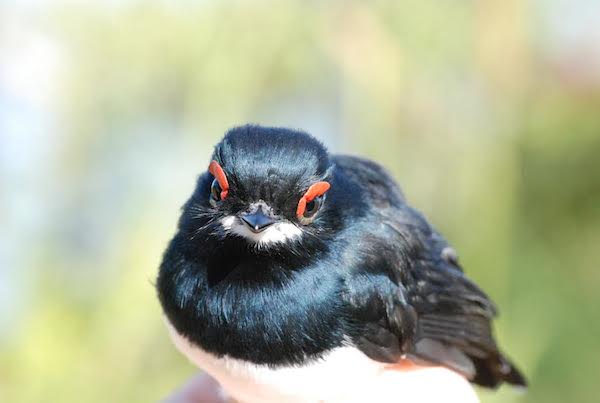 New study finds habitat fragmentation may lead to increased nest predation The tropical montane forests of the Cameroon mountain ranges boast fertile volcanic soils, high biodiversity of grasses and non-woody plants, as well as many endemic bird species that can be found only in this high-altitude region. Yet, many of these endemic bird species may […]
New study finds habitat fragmentation may lead to increased nest predation The tropical montane forests of the Cameroon mountain ranges boast fertile volcanic soils, high biodiversity of grasses and non-woody plants, as well as many endemic bird species that can be found only in this high-altitude region. Yet, many of these endemic bird species may […]
Forest fragmentation’s carbon bomb: 736 million tonnes C02 annually
 Scientists have long known that forest fragments are not the same ecologically as intact forest landscapes. When forests are slashed into fragments, winds dry out the edges leading to dying trees and rising temperatures. Biodiversity often drops, while local extinctions rise and big animals vanish. Now, a new study finds another worrisome impact of forest […]
Scientists have long known that forest fragments are not the same ecologically as intact forest landscapes. When forests are slashed into fragments, winds dry out the edges leading to dying trees and rising temperatures. Biodiversity often drops, while local extinctions rise and big animals vanish. Now, a new study finds another worrisome impact of forest […]
Fragmented forests hurt some bat species, may benefit others
 Development of roads and other structures disturb large, continuous patches of habitat for wildlife. This habitat fragmentation is one of the biggest contributors to species extinction, as the local ecology and species interactions are altered. A new study published in mongabay.com’s open-access journal Tropical Conservation Science finds that leaf-nosed bat abundances in Mexico are closely […]
Development of roads and other structures disturb large, continuous patches of habitat for wildlife. This habitat fragmentation is one of the biggest contributors to species extinction, as the local ecology and species interactions are altered. A new study published in mongabay.com’s open-access journal Tropical Conservation Science finds that leaf-nosed bat abundances in Mexico are closely […]
‘Natural Reserves’ no more: illegal colonists deforest huge portions of Nicaraguan protected areas
 Nearly a quarter of two reserves’ forest cover lost within the last 13 years In southeastern Nicaragua, abutting the coastal Caribbean town of Bluefields, lie two nature reserves – Cerro Silva and Punta Gorda – that are embroiled in a bitter battle for survival against the speedily encroaching agricultural frontier. The forest is all but […]
Nearly a quarter of two reserves’ forest cover lost within the last 13 years In southeastern Nicaragua, abutting the coastal Caribbean town of Bluefields, lie two nature reserves – Cerro Silva and Punta Gorda – that are embroiled in a bitter battle for survival against the speedily encroaching agricultural frontier. The forest is all but […]
Titanium vs. Millipedes: new species discovered in Madagascar threatened by mining
 Researchers urge increased conservation attention for invertebrates, fragmented habitats A team of scientists from the United States and Germany has recently described seven new species of Malagasy giant pill-millipede. All but one of these species are considered “microendemics,” in that they have only been found in small, isolated forest patches. The study was published in […]
Researchers urge increased conservation attention for invertebrates, fragmented habitats A team of scientists from the United States and Germany has recently described seven new species of Malagasy giant pill-millipede. All but one of these species are considered “microendemics,” in that they have only been found in small, isolated forest patches. The study was published in […]
The last best place no more: massive deforestation destroying prime chimp habitat in Uganda
 Chimp habitat disappearing as river basin loses forest cover Uganda’s Kafu River, which is about 180 kilometers (110 miles) long, is part of a vast chimpanzee habitat that includes Budongo and Bugoma Forest Reserves, as well as several unofficial protected areas. However, this region is losing a significant portion of valuable chimpanzee habitat, with Global […]
Chimp habitat disappearing as river basin loses forest cover Uganda’s Kafu River, which is about 180 kilometers (110 miles) long, is part of a vast chimpanzee habitat that includes Budongo and Bugoma Forest Reserves, as well as several unofficial protected areas. However, this region is losing a significant portion of valuable chimpanzee habitat, with Global […]
Size matters: small animals abundant in fragmented forests, large animals not
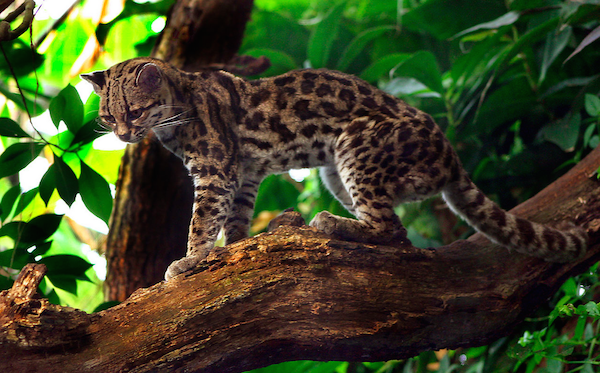 Study urges alteration of management practices Habitat fragmentation and hunting are both distinct critical issues facing forests today that require their own countermeasures. Yet, much research has chosen to conflate the two, potentially leading to ineffective ecosystem management. According to a new study recently published in mongabay.com’s open access journal, Tropical Conservation Science, the interaction […]
Study urges alteration of management practices Habitat fragmentation and hunting are both distinct critical issues facing forests today that require their own countermeasures. Yet, much research has chosen to conflate the two, potentially leading to ineffective ecosystem management. According to a new study recently published in mongabay.com’s open access journal, Tropical Conservation Science, the interaction […]
Feather forensics: scientist uses genes to track macaws, aid bird conservation
 Highway development may isolate bird populations in Brazil, Peru When a massive road project connected the ports of Brazil to the shipping docks of Peru in 2011, spanning the South American continent, conservationists predicted widespread impacts on wildlife living along the route that stretches almost 5,500 kilometers (about 3,400 miles). Roads are a well-documented source […]
Highway development may isolate bird populations in Brazil, Peru When a massive road project connected the ports of Brazil to the shipping docks of Peru in 2011, spanning the South American continent, conservationists predicted widespread impacts on wildlife living along the route that stretches almost 5,500 kilometers (about 3,400 miles). Roads are a well-documented source […]
Intact Amazon forests show possible signs of global warming impact
 Fragmentation in Rondonia, Brazil. Courtesy of Google Earth Climate change may be taking a hidden toll on intact rainforests in the heart of the Amazon, finds a new study based on 35 years of observations. The research, published in the journal Ecology, focused on the ecological impacts of fragmentation but unexpectedly found changes in the […]
Fragmentation in Rondonia, Brazil. Courtesy of Google Earth Climate change may be taking a hidden toll on intact rainforests in the heart of the Amazon, finds a new study based on 35 years of observations. The research, published in the journal Ecology, focused on the ecological impacts of fragmentation but unexpectedly found changes in the […]
Zebras for the win! Africa’s longest land migration discovered
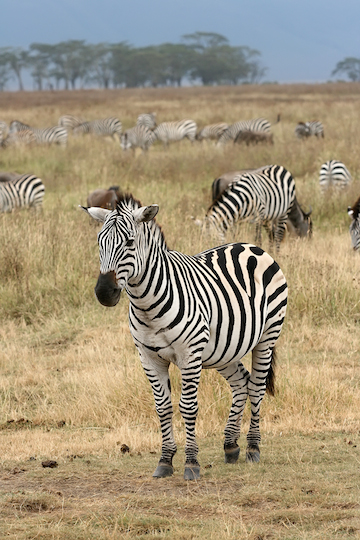 With food and water scarce in many parts of Africa, many species migrate long-distances in order to survive. A new study published in the journal, Oryx has found a new record-breaker for the continent’s longest tracked terrestrial migration: a huge group of zebras that traveled a total distance of 500 kilometers (300 miles). The journey […]
With food and water scarce in many parts of Africa, many species migrate long-distances in order to survive. A new study published in the journal, Oryx has found a new record-breaker for the continent’s longest tracked terrestrial migration: a huge group of zebras that traveled a total distance of 500 kilometers (300 miles). The journey […]
The matrix matters: scientists find surprising biodiversity between forests
 The Theory of Island Biogeography, coined by Robert MacArthur and E.O. Wilson, helps describe why species are distributed as they are. The larger and closer an island is to another (or to the mainland), the more biodiverse it should be. This can be used to describe actual islands in the ocean, like the Galapagos, or […]
The Theory of Island Biogeography, coined by Robert MacArthur and E.O. Wilson, helps describe why species are distributed as they are. The larger and closer an island is to another (or to the mainland), the more biodiverse it should be. This can be used to describe actual islands in the ocean, like the Galapagos, or […]
Almost 90 percent of Republic of the Congo’s lowland forests open to logging
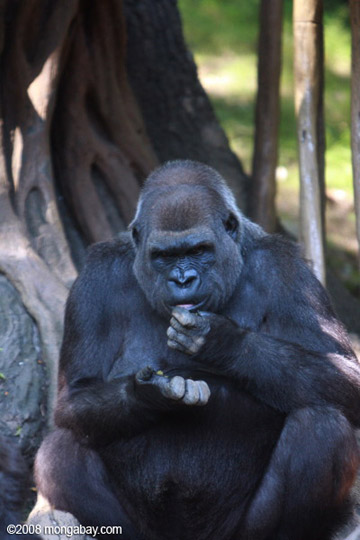 Although the Republic of the Congo has opened up nearly 90 percent of its lowland forests to logging, the majority of the logging occurring in the country is still illegal, according to a new report from the Chatham House. In fact the UK policy institute finds that illegal logging in the Republic of the Congo […]
Although the Republic of the Congo has opened up nearly 90 percent of its lowland forests to logging, the majority of the logging occurring in the country is still illegal, according to a new report from the Chatham House. In fact the UK policy institute finds that illegal logging in the Republic of the Congo […]
Next big idea in forest conservation? Quantifying the cost of forest degradation
 Innovation in Tropical Forest Conservation: Q&A with Dr. Phillip Fearnside Pasture meets gallery forest in the Brazilian Amazon. Photo by: Rhett A. Butler. How much is a forest really worth? And what is the cost of forest degradation? These values are difficult to estimate, but according to Dr. Phillip Fearnside, we need to do a […]
Innovation in Tropical Forest Conservation: Q&A with Dr. Phillip Fearnside Pasture meets gallery forest in the Brazilian Amazon. Photo by: Rhett A. Butler. How much is a forest really worth? And what is the cost of forest degradation? These values are difficult to estimate, but according to Dr. Phillip Fearnside, we need to do a […]
Bizarre, endangered bird discovered in high densities
 The turkey-sized, noisy, fruit-feasting guans are arguably one of the strangest wildlife sightings in the tropical forests of Central and South America. Ancient animals, these birds are members of the Cracidae family—which also include equally-odd currasows and chachalacas—and are actually distantly related to megapode, or mound-building, birds of Australiasia. A new study in mongabay.com’s open-access […]
The turkey-sized, noisy, fruit-feasting guans are arguably one of the strangest wildlife sightings in the tropical forests of Central and South America. Ancient animals, these birds are members of the Cracidae family—which also include equally-odd currasows and chachalacas—and are actually distantly related to megapode, or mound-building, birds of Australiasia. A new study in mongabay.com’s open-access […]
Scientists discover new gecko hanging-on in single forest fragment
 Scientists have identified a new species of day gecko that is the largest in its genus (Cnemaspis) to be found in Sri Lanka. To date, it has been observed only within the Rammalakanda Reserve in southern Sri Lanka, an area spanning just 1,700 hectares, raising questions about the viability of this population and hence the […]
Scientists have identified a new species of day gecko that is the largest in its genus (Cnemaspis) to be found in Sri Lanka. To date, it has been observed only within the Rammalakanda Reserve in southern Sri Lanka, an area spanning just 1,700 hectares, raising questions about the viability of this population and hence the […]
Next big idea in forest conservation? Connecting forest fragments
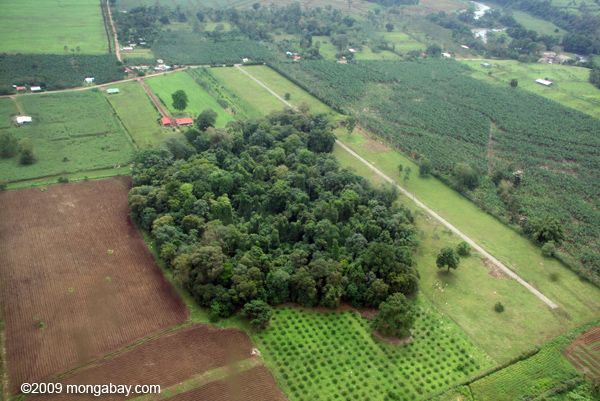 Innovation in Tropical Forest Conservation: Q&A with Stuart Pimm Aerial view of forest fragment in Costa Rica. Photo by Rhett A. Butler. Dr. Stuart Pimm is an expert in extinctions: why they happen, how fast they happen, and how they can be prevented. Reconnecting forest fragments and avoiding fragmentation, according to Pimm, are among the […]
Innovation in Tropical Forest Conservation: Q&A with Stuart Pimm Aerial view of forest fragment in Costa Rica. Photo by Rhett A. Butler. Dr. Stuart Pimm is an expert in extinctions: why they happen, how fast they happen, and how they can be prevented. Reconnecting forest fragments and avoiding fragmentation, according to Pimm, are among the […]
Bornean elephant meets palm oil: saving the world’s smallest pachyderm in a fractured landscape
 An interview with Nurzahafarina Othman, a part of our on-going Interviews with Young Scientists series. Bornean elephants tussling on the Kinabatangan River. Photo courtesy of: Nurzahafarina Othman. In the Malaysian state of Sabah, where most conservation students are still foreigners—either European or American—Nurzahafarina Othman stands out: not only is she Malaysian, a Muslim, and a […]
An interview with Nurzahafarina Othman, a part of our on-going Interviews with Young Scientists series. Bornean elephants tussling on the Kinabatangan River. Photo courtesy of: Nurzahafarina Othman. In the Malaysian state of Sabah, where most conservation students are still foreigners—either European or American—Nurzahafarina Othman stands out: not only is she Malaysian, a Muslim, and a […]
‘Ecological Armageddon’: mammals vanish entirely from forest fragments after 25 years
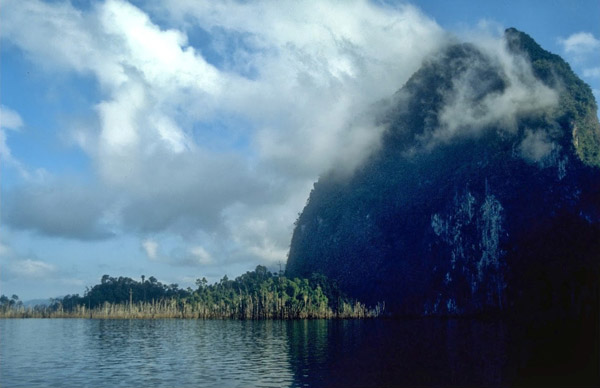 As tropical forests worldwide are increasingly cut into smaller and smaller fragments, mammal extinctions may not be far behind, according to a new study in Science. Tracking native smalls mammals in Chiew Larn Reservoir, Thailand for over 25 years, scientists found a stunning and rapid decline in mammal populations, until most forests were almost completely […]
As tropical forests worldwide are increasingly cut into smaller and smaller fragments, mammal extinctions may not be far behind, according to a new study in Science. Tracking native smalls mammals in Chiew Larn Reservoir, Thailand for over 25 years, scientists found a stunning and rapid decline in mammal populations, until most forests were almost completely […]
Scientists catch boa constrictor eating a howler monkey (photos)
 In a world first, scientists have captured images and video of a boa constrictor attacking and devouring whole a femle howler monkey, one of the largest new world primates weighing in at around 4 kilograms (8.8 pounds). The rare predation event was recorded in a tiny forest fragment (2.5 hectares) in the Brazilian state of […]
In a world first, scientists have captured images and video of a boa constrictor attacking and devouring whole a femle howler monkey, one of the largest new world primates weighing in at around 4 kilograms (8.8 pounds). The rare predation event was recorded in a tiny forest fragment (2.5 hectares) in the Brazilian state of […]
Forest fragmentation leading to higher extinction rates
 The world’s species are in worse trouble than widely-assumed, according to a new paper in the Proceedings of the National Academy of Sciences (PNAS), which reevaluates how scientists estimate extinction rates. The new model takes into account the impact of forest fragmentation on extinction rates for the first time, filling in a gap in past […]
The world’s species are in worse trouble than widely-assumed, according to a new paper in the Proceedings of the National Academy of Sciences (PNAS), which reevaluates how scientists estimate extinction rates. The new model takes into account the impact of forest fragmentation on extinction rates for the first time, filling in a gap in past […]
Loss of big fruit-eating birds impacting trees in endangered rainforests
 The extinction of large, fruit-eating birds in fragments of Brazil’s Atlantic rainforest has caused palm trees to produce smaller seeds over the past century, impacting forest ecology, finds a study published in the journal Science. The researchers — led by Mauro Galetti from Brazil’s Universidade Estadual Paulista — looked at Euterpe edulis palm seeds in […]
The extinction of large, fruit-eating birds in fragments of Brazil’s Atlantic rainforest has caused palm trees to produce smaller seeds over the past century, impacting forest ecology, finds a study published in the journal Science. The researchers — led by Mauro Galetti from Brazil’s Universidade Estadual Paulista — looked at Euterpe edulis palm seeds in […]
Still hope for tropical biodiversity in human modified landscapes
 As primary forests become increasingly rare and expensive to protect, many ecologists are looking to better management of Human Modified Landscapes (HMLs) to shepherd and shield biodiversity in the tropics. Secondary forests, selectively logged forests and lands devoted to sustainable agriculture already play an important role in conservation efforts. However, the idea that HMLs will […]
As primary forests become increasingly rare and expensive to protect, many ecologists are looking to better management of Human Modified Landscapes (HMLs) to shepherd and shield biodiversity in the tropics. Secondary forests, selectively logged forests and lands devoted to sustainable agriculture already play an important role in conservation efforts. However, the idea that HMLs will […]
Peruvian night monkey threatened by vanishing forests, lost corridors
 Adult Peruvian night monkey. Photo by: Jean Paul Perret/NPC. The Peruvian night monkey (Aotus miconax) is one of the world’s least known primates, having never been studied in the wild–until now. Found only in the cloud forests of northern Peru, a group of scientists with Neotropical Primate Conservation and the National University of Mayor San […]
Adult Peruvian night monkey. Photo by: Jean Paul Perret/NPC. The Peruvian night monkey (Aotus miconax) is one of the world’s least known primates, having never been studied in the wild–until now. Found only in the cloud forests of northern Peru, a group of scientists with Neotropical Primate Conservation and the National University of Mayor San […]
New giant flying frog discovered near city of 9 million
 Helen’s tree frog. Photo courtesy of Jodi Rowley. Jodi Rowley is no stranger to discovering new amphibians—she’s helped describe over 10 in her short career thus far—but she was shocked to discover a new species of flying frog less than 100 kilometers from a major, bustling Southeast Asian metropolis, Ho Chi Minh City. Unfortunately, the […]
Helen’s tree frog. Photo courtesy of Jodi Rowley. Jodi Rowley is no stranger to discovering new amphibians—she’s helped describe over 10 in her short career thus far—but she was shocked to discover a new species of flying frog less than 100 kilometers from a major, bustling Southeast Asian metropolis, Ho Chi Minh City. Unfortunately, the […]
Rehabilitated orangutans in danger if industrial project proceeds in Borneo
 Industrial area in Kalimantan. Photo courtesy of Stanislav Lhota. The proposed extension of an industrial area in East Kalimantan, Indonesia will likely mean the end of a population of rehabilitated orangutans who reside there, according to the Indonesian environmental group Peduli Teluk Balikpapan. The Kariangau Industrial Area (KIK) will comprise 5,130 hectares of land currently […]
Industrial area in Kalimantan. Photo courtesy of Stanislav Lhota. The proposed extension of an industrial area in East Kalimantan, Indonesia will likely mean the end of a population of rehabilitated orangutans who reside there, according to the Indonesian environmental group Peduli Teluk Balikpapan. The Kariangau Industrial Area (KIK) will comprise 5,130 hectares of land currently […]
Key mammals dying off in rainforest fragments
 New research shows that the lowland tapir is nearly extinct in the Atlantic Forest. Photo by: Jeremy Hance. When the Portuguese first arrived on the shores of what is now Brazil, a massive forest waited for them. Not the Amazon, but the Atlantic Forest, stretching for over 1.2 million kilometers. Here jaguars, the continent’s apex […]
New research shows that the lowland tapir is nearly extinct in the Atlantic Forest. Photo by: Jeremy Hance. When the Portuguese first arrived on the shores of what is now Brazil, a massive forest waited for them. Not the Amazon, but the Atlantic Forest, stretching for over 1.2 million kilometers. Here jaguars, the continent’s apex […]
Tigers vs. coal in India: when big energy meets vanishing cats
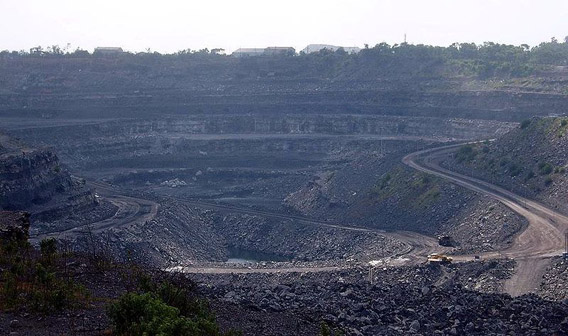 Surface coal mining in Bihar, India. Around 70-80 percent of India’s power is currently provided by coal. Burning coal fuels climate change, causes acid rain, and spreads toxic pollutants into the environment, but now a new Greenpeace report warns that coal may also imperil the world’s biggest feline: the tiger. Home to world’s largest population […]
Surface coal mining in Bihar, India. Around 70-80 percent of India’s power is currently provided by coal. Burning coal fuels climate change, causes acid rain, and spreads toxic pollutants into the environment, but now a new Greenpeace report warns that coal may also imperil the world’s biggest feline: the tiger. Home to world’s largest population […]
Experts: sustainable logging in rainforests impossible
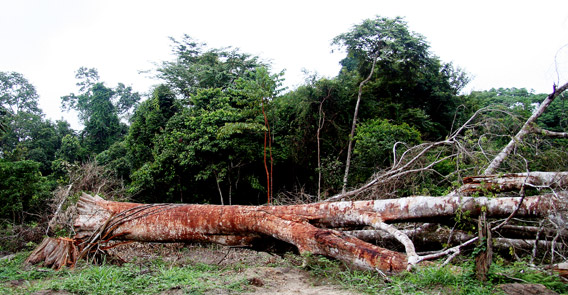 Logging in Gabon, Central Africa. Photo by Rhett A. Butler. Industrial logging in primary tropical forests that is both sustainable and profitable is impossible, argues a new study in Bioscience, which finds that the ecology of tropical hardwoods makes logging with truly sustainable practices not only impractical, but completely unprofitable. Given this, the researchers recommend […]
Logging in Gabon, Central Africa. Photo by Rhett A. Butler. Industrial logging in primary tropical forests that is both sustainable and profitable is impossible, argues a new study in Bioscience, which finds that the ecology of tropical hardwoods makes logging with truly sustainable practices not only impractical, but completely unprofitable. Given this, the researchers recommend […]
Historic birth for the Sumatran rhino
 Ratu (above) and the baby male are doing well. Photo by: International Rhino Foundation. After two miscarriages and a pregnancy that lasted 15 months, Ratu, a female Sumatra rhino, has given birth to a healthy male calf, conservationists happily announced this weekend. The birth at a rhino sanctuary in Way Kambas National Park in Sumatra […]
Ratu (above) and the baby male are doing well. Photo by: International Rhino Foundation. After two miscarriages and a pregnancy that lasted 15 months, Ratu, a female Sumatra rhino, has given birth to a healthy male calf, conservationists happily announced this weekend. The birth at a rhino sanctuary in Way Kambas National Park in Sumatra […]
Can loggers be conservationists?
 Sawmill in Indonesia. Photo by: Rhett A. Butler. Last year researchers took the first ever publicly-released video of an African golden cat (Profelis aurata) in a Gabon rainforest. This beautiful, but elusive, feline was filmed sitting docilely for the camera and chasing a bat. The least-known of Africa’s wild cat species, the African golden cat […]
Sawmill in Indonesia. Photo by: Rhett A. Butler. Last year researchers took the first ever publicly-released video of an African golden cat (Profelis aurata) in a Gabon rainforest. This beautiful, but elusive, feline was filmed sitting docilely for the camera and chasing a bat. The least-known of Africa’s wild cat species, the African golden cat […]
Chimp conservation requires protecting fragmented river forests in Uganda
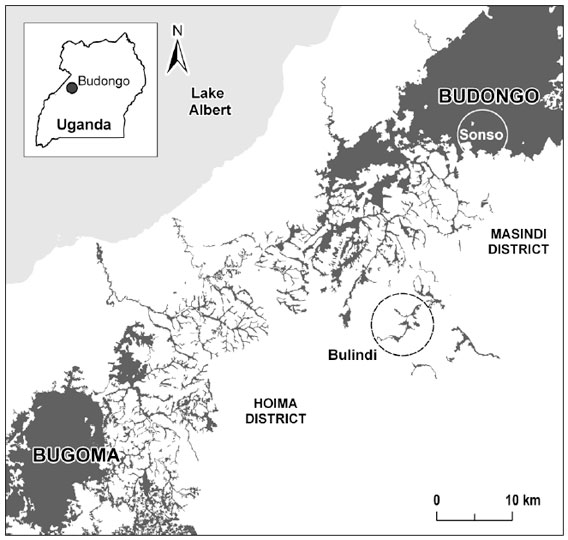 Forest fragments along riversides in Uganda may make good habitats for chimpanzees but remain unprotected, according to a new study in mongabay.com’s open access journal Tropical Conservation Society (TCS). Researchers surveyed a riverine forest known as Bulindi in Uganda, in-between Budongo and Bugoma Forest Reserves, to determine if it was suitable for the long-term survival […]
Forest fragments along riversides in Uganda may make good habitats for chimpanzees but remain unprotected, according to a new study in mongabay.com’s open access journal Tropical Conservation Society (TCS). Researchers surveyed a riverine forest known as Bulindi in Uganda, in-between Budongo and Bugoma Forest Reserves, to determine if it was suitable for the long-term survival […]
What a Bornean elephant wants: more protected forests and wildlife corridors
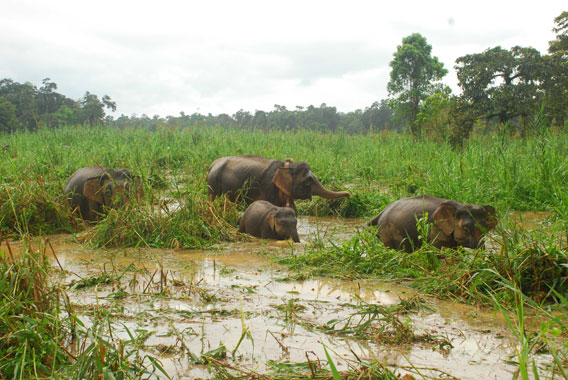 Putut (center) and her family, after being collared in October 2011. Photo courtesy of Benoit Goossens. Forest fragmentation and destruction is imperiling the Bornean elephant (Elephas maximus borneensis), according to a new paper published in PLoS ONE. Using satellite collars to track the pachyderms for the first time in the Malaysian state of Sabah, scientists […]
Putut (center) and her family, after being collared in October 2011. Photo courtesy of Benoit Goossens. Forest fragmentation and destruction is imperiling the Bornean elephant (Elephas maximus borneensis), according to a new paper published in PLoS ONE. Using satellite collars to track the pachyderms for the first time in the Malaysian state of Sabah, scientists […]
Tropical ecologist: Australia must follow U.S. and EU in banning illegally logged wood
 Illegally logged tree in Indonesia. Photo by: Rhett A. Butler. Australia should join the widening effort to stamp out illegal logging, according to testimony given this week by tropical ecologist William Laurance with James Cook University. Presenting before the Australian Senate’s rural affairs committee, Laurance argued that the massive environmental and economic costs of illegal […]
Illegally logged tree in Indonesia. Photo by: Rhett A. Butler. Australia should join the widening effort to stamp out illegal logging, according to testimony given this week by tropical ecologist William Laurance with James Cook University. Presenting before the Australian Senate’s rural affairs committee, Laurance argued that the massive environmental and economic costs of illegal […]
Rare apes saved in India
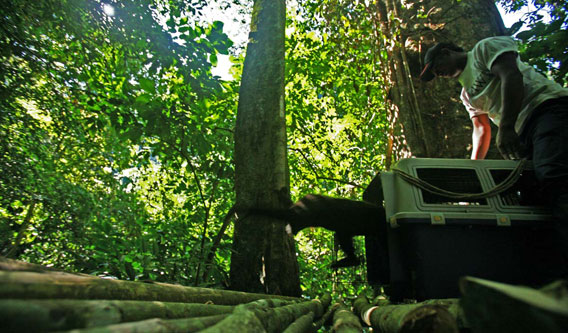 Gibbon released into new home. Photo by: Dipankar Bhagawati. Two Hoolock gibbons have been successfully translocated from a fragmented forest to Mehao Wildlife Sanctuary in the beginning of a desperate bid to save 18 family groups of India’s last apes. Living near the village of Dello in northeastern India, the apes were straining to survive […]
Gibbon released into new home. Photo by: Dipankar Bhagawati. Two Hoolock gibbons have been successfully translocated from a fragmented forest to Mehao Wildlife Sanctuary in the beginning of a desperate bid to save 18 family groups of India’s last apes. Living near the village of Dello in northeastern India, the apes were straining to survive […]
Giant rat plays big ecological role in dispersing seeds
 Kivu giant pouched rat caught on camera trap eating a seed of Carapa grandiflora. Photo by: Aisha Nyiramana. Rats are rarely thought of as heroes. In fact, in many parts of the world they are despised, while in others they serve largely as food. But, scientists are now discovering that many tropical forest rodents, including […]
Kivu giant pouched rat caught on camera trap eating a seed of Carapa grandiflora. Photo by: Aisha Nyiramana. Rats are rarely thought of as heroes. In fact, in many parts of the world they are despised, while in others they serve largely as food. But, scientists are now discovering that many tropical forest rodents, including […]
Atlantic Forest stores less carbon due to drastic fragmentation
The Atlantic Forest in Brazil is one of the most fragmented and damaged forests in the world. Currently around 12 percent of the forest survives, with much of it in small fragments, many less than 100 hectares. A new study in mongabay.com’s open-access journal Tropical Conservation Science finds that the bloodied nature of the Atlantic […]
Loving the tapir: pioneering conservation for South America’s biggest animal
- Compared to some of South America’s megafauna stand-out species – the jaguar, the anaconda, and the harpy eagle come to mind& – the tapir doesn’t get a lot of love.
- This is a shame. For one thing, they’re the largest terrestrial animal on the South American continent: pound-for-pound they beat both the jaguar and the llama.
- For another they play a very significant role in their ecosystem: they disperse seeds, modify habitats, and are periodic prey to big predators.
Cameratraps take global snapshot of declining tropical mammals
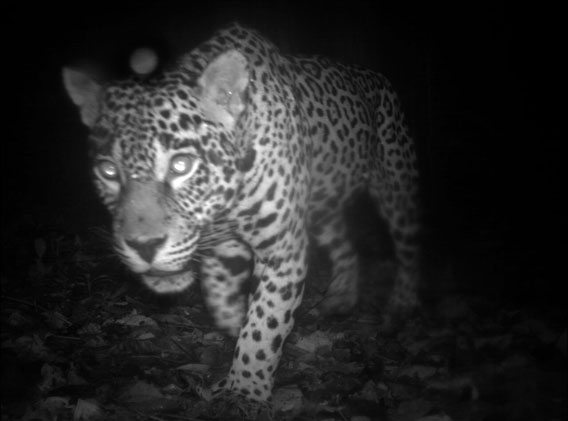 Central Suriname Nature Reserve, Suriname. A jaguar (Panthera Onca), a Near Threatened species. Of the sites researched, Suriname’s site presented the highest number of species diversity. Photo courtesy of Conservation International Suriname, a member of the TEAM network. A groundbreaking cameratrap study has mapped the abundance, or lack thereof, of tropical mammal populations across seven […]
Central Suriname Nature Reserve, Suriname. A jaguar (Panthera Onca), a Near Threatened species. Of the sites researched, Suriname’s site presented the highest number of species diversity. Photo courtesy of Conservation International Suriname, a member of the TEAM network. A groundbreaking cameratrap study has mapped the abundance, or lack thereof, of tropical mammal populations across seven […]
Lessons from the world’s longest study of rainforest fragments
 Forest fragments under research in the Biological Dynamics of Forest Fragments Project. Photo by: Richard Bierregaard. For over 30 years, hundreds of scientists have scoured eleven forest fragments in the Amazon seeking answers to big questions: how do forest fragments’ species and microclimate differ from their intact relatives? Will rainforest fragments provide a safe haven […]
Forest fragments under research in the Biological Dynamics of Forest Fragments Project. Photo by: Richard Bierregaard. For over 30 years, hundreds of scientists have scoured eleven forest fragments in the Amazon seeking answers to big questions: how do forest fragments’ species and microclimate differ from their intact relatives? Will rainforest fragments provide a safe haven […]
Balancing agriculture and rainforest biodiversity in India’s Western Ghats
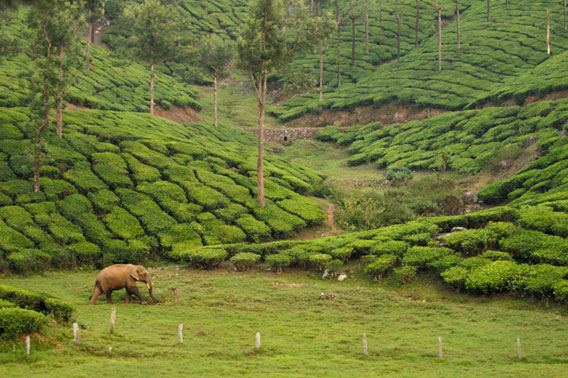 An Asian elephant wanders through tea fields in the Western Ghats. Photo © Kalyan Varma. When one thinks of the world’s great rainforests the Amazon, Congo, and the tropical forests of Southeast Asia and Indonesia usually come to mind. Rarely does India—home to over a billion people—make an appearance. But along India’s west coast lies […]
An Asian elephant wanders through tea fields in the Western Ghats. Photo © Kalyan Varma. When one thinks of the world’s great rainforests the Amazon, Congo, and the tropical forests of Southeast Asia and Indonesia usually come to mind. Rarely does India—home to over a billion people—make an appearance. But along India’s west coast lies […]
Elephants: the gardeners of Asia’s and Africa’s forests
 Forest elephant. Photo by: Carlton Ward Junior. An interview with Ahimsa Campos-Arceiz and Stephen Blake. Warning: graphic images below. It seems difficult to imagine elephants delicately tending a garden, but these pachyderms may well be the world’s weightiest horticulturalist. Elephants both in Asia and Africa eat abundant amounts of fruit when available; seeds pass through […]
Forest elephant. Photo by: Carlton Ward Junior. An interview with Ahimsa Campos-Arceiz and Stephen Blake. Warning: graphic images below. It seems difficult to imagine elephants delicately tending a garden, but these pachyderms may well be the world’s weightiest horticulturalist. Elephants both in Asia and Africa eat abundant amounts of fruit when available; seeds pass through […]
Cloud forest dung beetles in India point to ‘fossil ecosystem’
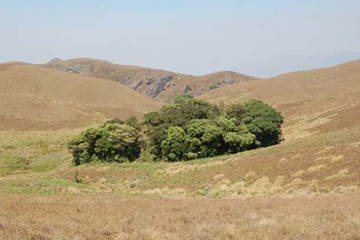 In the cloud forests and grasslands of India’s Western Ghats, known as sholas, researchers have for the first time comprehensively studied the inhabiting dung beetle populations. The resulting study in mongabay.com’s open access journal Tropical Conservation Science, has led scientists to hypothesize that the beetles in concordance with the sheep-like mammal, the nilgiri tahr (Nilgiritragus […]
In the cloud forests and grasslands of India’s Western Ghats, known as sholas, researchers have for the first time comprehensively studied the inhabiting dung beetle populations. The resulting study in mongabay.com’s open access journal Tropical Conservation Science, has led scientists to hypothesize that the beetles in concordance with the sheep-like mammal, the nilgiri tahr (Nilgiritragus […]
Critically endangered capuchins make tools to gather termites
 Less than 200 blond capuchins (Cebus falvius) survive in the highly-fragmented habitat of Brazil’s Atlantic Forest. But this tiny group of monkeys, only rediscovered in 2006, is surprising scientists with its adept tool-using abilities. Displaying similar behavior to that which made the chimpanzees of Gombe famous worldwide, the blond capuchins modify sticks to gather termites […]
Less than 200 blond capuchins (Cebus falvius) survive in the highly-fragmented habitat of Brazil’s Atlantic Forest. But this tiny group of monkeys, only rediscovered in 2006, is surprising scientists with its adept tool-using abilities. Displaying similar behavior to that which made the chimpanzees of Gombe famous worldwide, the blond capuchins modify sticks to gather termites […]
New species of zombie-creating fungi discovered
 As everyone knows, human zombies are created when an uninfected human is bitten by a member of the brain-craving undead. But what about ant zombies? Yes, that’s right: ant zombies. In the South American rainforest, ants have a mortal enemy: the parasitic fungi in the Ophiocordyceps (also known as Cordyceps) genus. These fungi infect ants […]
As everyone knows, human zombies are created when an uninfected human is bitten by a member of the brain-craving undead. But what about ant zombies? Yes, that’s right: ant zombies. In the South American rainforest, ants have a mortal enemy: the parasitic fungi in the Ophiocordyceps (also known as Cordyceps) genus. These fungi infect ants […]
Saving Madagascar’s largest carnivorous mammal: the fossa
 The fossa. Photo © Nick Garbutt . An interview with Mia-Lana Lührs, a part of our Interviews with Young Scientists series. Madagascar is a land of wonders: dancing lemurs, thumbnail-sized chameleons, the long-fingered aye-aye, great baobab trees, and the mighty fossa. Wait—what? What’s a fossa? It’s true that when people think of Madagascar rarely do […]
The fossa. Photo © Nick Garbutt . An interview with Mia-Lana Lührs, a part of our Interviews with Young Scientists series. Madagascar is a land of wonders: dancing lemurs, thumbnail-sized chameleons, the long-fingered aye-aye, great baobab trees, and the mighty fossa. Wait—what? What’s a fossa? It’s true that when people think of Madagascar rarely do […]
Camera trap photos: big mammals survive in fragmented forest in Borneo
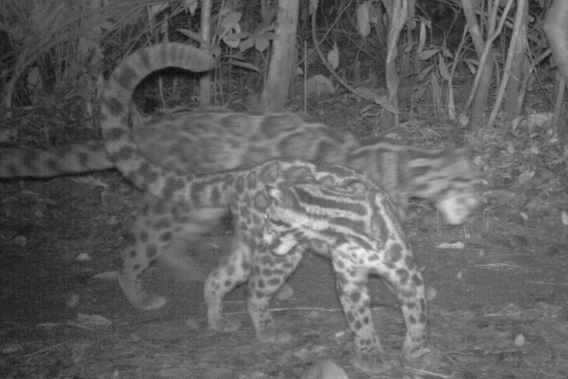 Clouded leopard female and her cub caught on camera trap in a corridor in the vicinity of DGFC. Photo courtesy of Sabah Wildlife Department, Danau Girang Field Centre and HUTAN. Camera trap photos taken in the fragmented forest along the Kinabatangan River in Borneo have revealed a number of key mammal species surviving despite forest […]
Clouded leopard female and her cub caught on camera trap in a corridor in the vicinity of DGFC. Photo courtesy of Sabah Wildlife Department, Danau Girang Field Centre and HUTAN. Camera trap photos taken in the fragmented forest along the Kinabatangan River in Borneo have revealed a number of key mammal species surviving despite forest […]
Scientists to document impact of converting rainforest into oil palm plantations
 Oil palm and rainforest Scientists have partnered with one of the world’s largest palm oil producers to measure the impact of converting tropical forest into an oil palm plantation, reports Nature News. The Stability of Altered Forest Ecosystems project will monitor ecological changes—including biodiversity, erosion, soil quality, carbon dioxide emissions, and water pollution—in roughly 7,000 […]
Oil palm and rainforest Scientists have partnered with one of the world’s largest palm oil producers to measure the impact of converting tropical forest into an oil palm plantation, reports Nature News. The Stability of Altered Forest Ecosystems project will monitor ecological changes—including biodiversity, erosion, soil quality, carbon dioxide emissions, and water pollution—in roughly 7,000 […]
Forest fragment climate not driven by edge-effect
Examining ten forest fragments in Brazil’s Atlantic Forest, researchers have undercut the theory that the climate of forest fragment’ is driven by the edge-effect. Writing in mongabay.com’s open source journal Tropical Conservation Science, researchers found that edge-effect was too simple to explain the microclimate of isolated forest fragments from 3 to 3,500 hectares large, each […]
Photos: surprises discovered in tiny forest fragment surrounded by palm oil
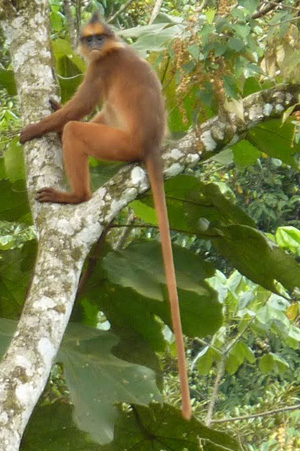 Researchers have uncovered an astounding number of species in a tiny protected forest fragment surrounded on all side by palm oil plantations in the Indonesian island of Sumatra. Researchers with the Zoological Society of London (ZSL), Queen Mary, University of London and the Durrell Institute of Conservation and Ecology (DICE – University of Kent) recorded […]
Researchers have uncovered an astounding number of species in a tiny protected forest fragment surrounded on all side by palm oil plantations in the Indonesian island of Sumatra. Researchers with the Zoological Society of London (ZSL), Queen Mary, University of London and the Durrell Institute of Conservation and Ecology (DICE – University of Kent) recorded […]
Environmentalists must recognize ‘biases and delusions’ to succeed
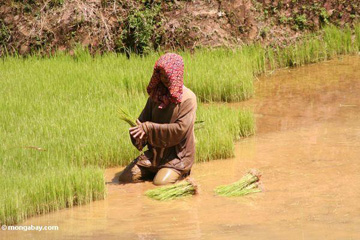 As nations from around the world meet at the Convention on Biological Diversity in Nagoya, Japan to discuss ways to stem the loss of biodiversity worldwide, two prominent researchers argue that environmentalists and conservationists need to consider paradigm shifts if biodiversity is to be preserved, especially in developing countries. Writing in the journal Biotropica, Douglas […]
As nations from around the world meet at the Convention on Biological Diversity in Nagoya, Japan to discuss ways to stem the loss of biodiversity worldwide, two prominent researchers argue that environmentalists and conservationists need to consider paradigm shifts if biodiversity is to be preserved, especially in developing countries. Writing in the journal Biotropica, Douglas […]
Satellites show fragmented rainforests significantly drier than intact forest
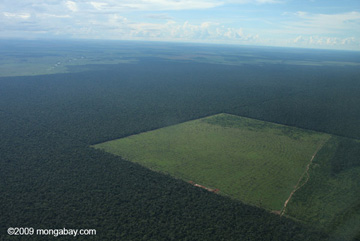 A new study in Biological Conservation has shown that edge forests and forest patches are more vulnerable to burning because they are drier than intact forests. Using eight years of satellite imagery over East Amazonia, the researchers found that desiccation (extreme dryness) penetrated anywhere from 1 to 3 kilometers into forests depending on the level […]
A new study in Biological Conservation has shown that edge forests and forest patches are more vulnerable to burning because they are drier than intact forests. Using eight years of satellite imagery over East Amazonia, the researchers found that desiccation (extreme dryness) penetrated anywhere from 1 to 3 kilometers into forests depending on the level […]
Ugandan forest being stripped for fuel wood
A new study in the open access journal of Tropical Conservation Science finds that the Kasagala forest reserve in central Uganda is losing important tree species and suffering from low diversity of species. Researchers believe that forest degradation for charcoal and firewood has put heavy pressure on this ecosystem. The Kasagala forest reserve, according to […]
Kera Menakjubkan Ditemukan di Amazon Kolombia
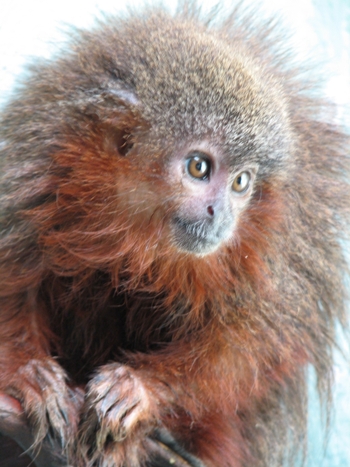 Sementara Amazon dihabisi pelan-pelan dari segala sisi oleh penebangan, pertanian, jalanan, peternakan, pertambangan, eksplorasi gas dan minyak, pengumuman spesies kera baru hari ini membuktikan bahwa hutan hujan tropis terbesar dunia masih memiliki banyak kejutan untuk dimunculkan. Ilmuwan dari National University of Colombia dan didukung oleh Conservation International (CI) dalam jurnal Primate Conservation telah mengumumkan penemuan […]
Sementara Amazon dihabisi pelan-pelan dari segala sisi oleh penebangan, pertanian, jalanan, peternakan, pertambangan, eksplorasi gas dan minyak, pengumuman spesies kera baru hari ini membuktikan bahwa hutan hujan tropis terbesar dunia masih memiliki banyak kejutan untuk dimunculkan. Ilmuwan dari National University of Colombia dan didukung oleh Conservation International (CI) dalam jurnal Primate Conservation telah mengumumkan penemuan […]
Stunning monkey discovered in the Colombian Amazon
 While the Amazon is being whittled away on all sides by logging, agriculture, roads, cattle ranching, mining, oil and gas exploration, today’s announcement of a new monkey species proves that the world’s greatest tropical rainforest still has many surprises to reveal. Scientists with the National University of Colombia and support from Conservation International (CI) have […]
While the Amazon is being whittled away on all sides by logging, agriculture, roads, cattle ranching, mining, oil and gas exploration, today’s announcement of a new monkey species proves that the world’s greatest tropical rainforest still has many surprises to reveal. Scientists with the National University of Colombia and support from Conservation International (CI) have […]
Rare primate photographed for the first time
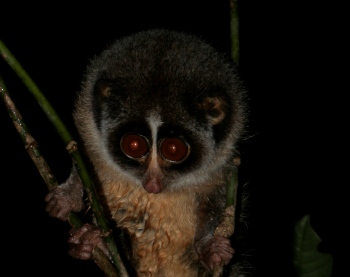 The Horton Plains slender loris (Loris tardigradus nycticeboides , thought extinct by researchers for over six decades, has finally posed for a photograph. This small nocturnal primate lives in the surviving montane tropical forest of Sri Lanka. The species was photographed during a recent expedition by the Zoological Society of London (ZSL)’s EDGE program in […]
The Horton Plains slender loris (Loris tardigradus nycticeboides , thought extinct by researchers for over six decades, has finally posed for a photograph. This small nocturnal primate lives in the surviving montane tropical forest of Sri Lanka. The species was photographed during a recent expedition by the Zoological Society of London (ZSL)’s EDGE program in […]
Forest loss in India likely worse than conventionally believed
Researchers have questioned 2009 findings by the Forest Survey of India (FSI) that found that India’s forests were, unlike many tropical Asian nations’, on the rebound. According to the FSI, Indian forests had grown by almost five percent from the 1990s. Yet, were these finding too good to be true? According to Jean-Philippe Puyravaud and […]
Forest loss occurring around Kibale National Park in Uganda
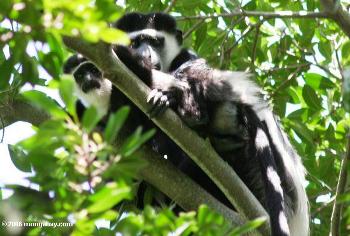 A new study in Tropical Conservation Science finds that Kibale National Park in Uganda has retained its tropical forest despite pressures of a dense human population and large-scale clearing activities just beyond the border of the park. Home to twelve primate species, including Chimpanzees, the park is known as a safe-haven for African primates. Although […]
A new study in Tropical Conservation Science finds that Kibale National Park in Uganda has retained its tropical forest despite pressures of a dense human population and large-scale clearing activities just beyond the border of the park. Home to twelve primate species, including Chimpanzees, the park is known as a safe-haven for African primates. Although […]
How do Asian elephants survive in fragmented and unprotected landscapes?
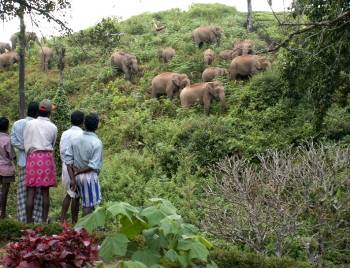 A new study in Tropical Conservation Science has found that Asian elephants living in a combination of fragmented forests and agricultural landscapes still depend on natural landscapes—rivers and forests—for survival. Following two herds of Asian elephants (Elephas maximus) in the Valparai plateau among the Anamalai Hills of India for three years, researchers found that the […]
A new study in Tropical Conservation Science has found that Asian elephants living in a combination of fragmented forests and agricultural landscapes still depend on natural landscapes—rivers and forests—for survival. Following two herds of Asian elephants (Elephas maximus) in the Valparai plateau among the Anamalai Hills of India for three years, researchers found that the […]
To save species, Malaysia implements daring plan to trap wild Bornean rhino
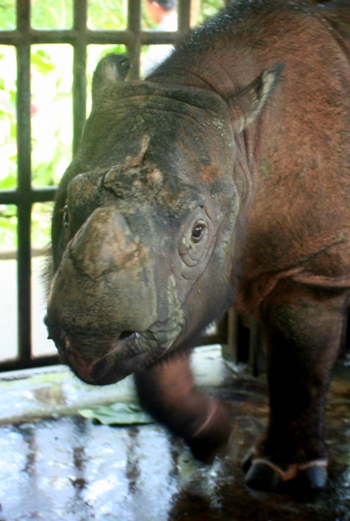 With less than 40 individuals left in the world, the Bornean rhino is a small step away from extinction. Yet conservationists and government officials in the Malaysian state of Sabah are not letting this subspecies of the Sumatran rhino go without a fight. Implementing a daring last-ditch plan to save the animal, officials are working […]
With less than 40 individuals left in the world, the Bornean rhino is a small step away from extinction. Yet conservationists and government officials in the Malaysian state of Sabah are not letting this subspecies of the Sumatran rhino go without a fight. Implementing a daring last-ditch plan to save the animal, officials are working […]
A total ban on primary forest logging needed to save the world, an interview with activist Glen Barry
 Radical, controversial, ahead-of-his-time, brilliant, or extremist: call Dr. Glen Barry, the head of Ecological Internet, what you will, but there is no question that his environmental advocacy group has achieved major successes in the past years, even if many of these are below the radar of big conservation groups and mainstream media. “We tend to […]
Radical, controversial, ahead-of-his-time, brilliant, or extremist: call Dr. Glen Barry, the head of Ecological Internet, what you will, but there is no question that his environmental advocacy group has achieved major successes in the past years, even if many of these are below the radar of big conservation groups and mainstream media. “We tend to […]
Long-distance seed dispersal and hunting, an interview with Kimberly Holbrook
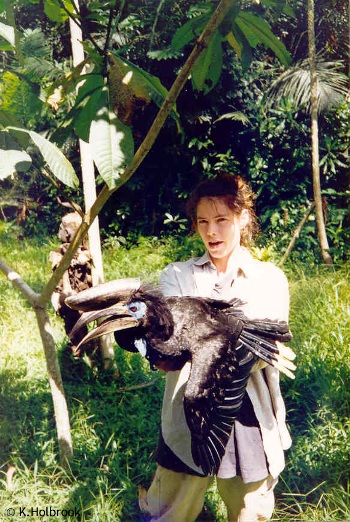 The fourth in an interview series with participants in the 5th Frugivore and Seed Dispersal International Symposium. Scientists are just beginning to uncover the complex relationship between healthy biodiverse tropical forests and seed dispersers—species that spread seeds from a parent tree to other parts of the forest including birds, rodents, primates, and even elephants. By […]
The fourth in an interview series with participants in the 5th Frugivore and Seed Dispersal International Symposium. Scientists are just beginning to uncover the complex relationship between healthy biodiverse tropical forests and seed dispersers—species that spread seeds from a parent tree to other parts of the forest including birds, rodents, primates, and even elephants. By […]
How hornbills keep Asian rainforests healthy and diverse, an interview with Shumpei Kitamura
 The third in an interview series with participants in the 5th Frugivore and Seed Dispersal International Symposium. Hornbills are one of Asia’s most attractive birds. Large, colorful, and easier to spot than most other birds, hornbills have become iconic animals in the tropical forests of Asia. Yet, most people probably don’t realize just how important […]
The third in an interview series with participants in the 5th Frugivore and Seed Dispersal International Symposium. Hornbills are one of Asia’s most attractive birds. Large, colorful, and easier to spot than most other birds, hornbills have become iconic animals in the tropical forests of Asia. Yet, most people probably don’t realize just how important […]
Turning to the matrix: a more accurate way to predict extinction
 According to most conservationists the globe is striding into the midst of the Sixth Mass Extinction. Species populations worldwide are dropping and in many cases species are vanishing all together due to pollution, climate change, poaching and hunting, overconsumption, invasive species, and exotic diseases, but no threat proves more pervasive and devastating for the world’s […]
According to most conservationists the globe is striding into the midst of the Sixth Mass Extinction. Species populations worldwide are dropping and in many cases species are vanishing all together due to pollution, climate change, poaching and hunting, overconsumption, invasive species, and exotic diseases, but no threat proves more pervasive and devastating for the world’s […]
Hope for survival as isolated orangutans joined by rope bridge
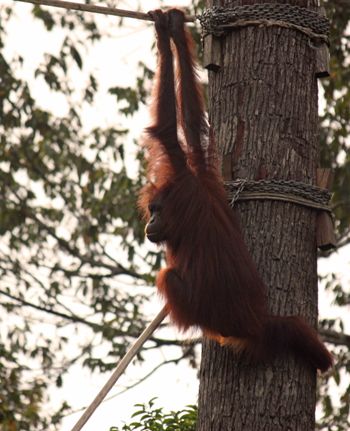 Researchers in the Malaysian state of Sabah in Borneo are joyful after receiving confirmation that a young male orangutan used a rope bridge to cross a river, which has separated one orangutan population from another. Due to logging and clearing forests for oil palm plantations, which cover 18 percent of land in Sabah, orangutans on […]
Researchers in the Malaysian state of Sabah in Borneo are joyful after receiving confirmation that a young male orangutan used a rope bridge to cross a river, which has separated one orangutan population from another. Due to logging and clearing forests for oil palm plantations, which cover 18 percent of land in Sabah, orangutans on […]
Seed dispersal in the face of climate change, an interview with Arndt Hampe
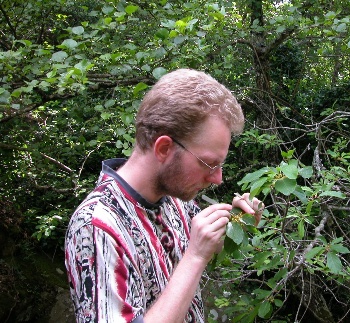 The second in an interview series with participants in the 5th Frugivore and Seed Dispersal International Symposium. Without seed dispersal plants could not survive. Seed dispersal—i.e. birds spreading seeds or wind carrying seeds—means the mechanism by which a seed is moved from its parent tree to a new area; if fortunate the seed will sprout […]
The second in an interview series with participants in the 5th Frugivore and Seed Dispersal International Symposium. Without seed dispersal plants could not survive. Seed dispersal—i.e. birds spreading seeds or wind carrying seeds—means the mechanism by which a seed is moved from its parent tree to a new area; if fortunate the seed will sprout […]
Diverse habitats needed for survival of small mammals in Mexico
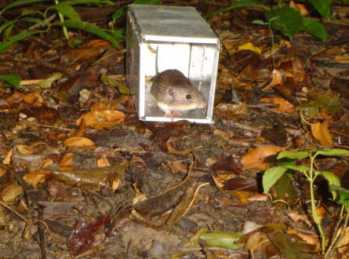 A new study in Tropical Conservation Science shows that small tropical mammals in Mexico—bats and rodents—require a variety of habitats to thrive. Surveying mammal populations in the Isthmus of Tehuantepec, Oaxaca, Mexico, researchers found that sites comprising the greatest habitat diversity carried also the greatest diversity of rodents. In turn bats lived in all variety […]
A new study in Tropical Conservation Science shows that small tropical mammals in Mexico—bats and rodents—require a variety of habitats to thrive. Surveying mammal populations in the Isthmus of Tehuantepec, Oaxaca, Mexico, researchers found that sites comprising the greatest habitat diversity carried also the greatest diversity of rodents. In turn bats lived in all variety […]
Finding forest for the endangered golden-headed lion tamarin
 Brazil’s golden-headed lion tamarin is a small primate with a black body and a bright mane of gold and orange. Listed as Endangered by the IUCN Red List, the golden-headed lion tamarin (Leontopithecus chrysomelas) survives in only a single protected reserve in the largely degraded Atlantic Forest in Brazil. Otherwise its habitat lies in unprotected […]
Brazil’s golden-headed lion tamarin is a small primate with a black body and a bright mane of gold and orange. Listed as Endangered by the IUCN Red List, the golden-headed lion tamarin (Leontopithecus chrysomelas) survives in only a single protected reserve in the largely degraded Atlantic Forest in Brazil. Otherwise its habitat lies in unprotected […]
Last chance to save Bangladeshi forest: 90 percent of the Sal ecosystem is gone
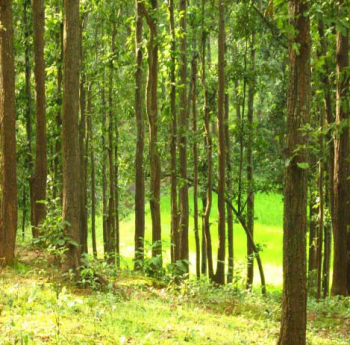 Considered the most threatened ecosystem in Bangladesh, the moist deciduous Sal forest (Shorea robusta) is on the verge of vanishing. In 1990 only 10 percent of the forest cover remained, down from 36 percent in 1985 according to statistics from the Food and Agricultural Organization (FAO). A new study in the online open-access journal Tropical […]
Considered the most threatened ecosystem in Bangladesh, the moist deciduous Sal forest (Shorea robusta) is on the verge of vanishing. In 1990 only 10 percent of the forest cover remained, down from 36 percent in 1985 according to statistics from the Food and Agricultural Organization (FAO). A new study in the online open-access journal Tropical […]
Photos: Madagascar’s wonderful and wild frogs, an interview with Sahonagasy
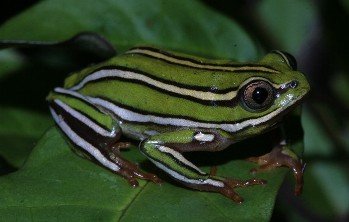 New website works to save Madagascar’s incredible diversity of frogs. To save Madagascar’s embattled and beautiful amphibians, scientists are turning to the web. A new site built by herpetologists, Sahonagasy, is dedicated to gathering and providing information about Madagascar’s unique amphibians in a bid to save them from the growing threat of extinction. “The past […]
New website works to save Madagascar’s incredible diversity of frogs. To save Madagascar’s embattled and beautiful amphibians, scientists are turning to the web. A new site built by herpetologists, Sahonagasy, is dedicated to gathering and providing information about Madagascar’s unique amphibians in a bid to save them from the growing threat of extinction. “The past […]
The Caribbean’s wonderfully weird (and threatened) mammals, an interview with Jose Nunez-Mino
 Not many people know the solenodon and the hutia, yet for the fortunate few that have encountered them, these strange little-studied mammals—just barely holding on in the Caribbean island of Hispaniola—deserve to be stars of the animal kingdom. “I could not quite believe it the first time I held a solenodon; I was in utter […]
Not many people know the solenodon and the hutia, yet for the fortunate few that have encountered them, these strange little-studied mammals—just barely holding on in the Caribbean island of Hispaniola—deserve to be stars of the animal kingdom. “I could not quite believe it the first time I held a solenodon; I was in utter […]
What types of primates are most prone to extinction in small forest fragments?
 According to the most recent IUCN assessment, 48 percent of primates are threatened with extinction. Major threats to primates include habitat loss and fragmentation, hunting, and the wildlife trade. A new paper published in Tropical Conservation Science looked at ones of these threats — fragmentation — in an effort to determine what traits put primates […]
According to the most recent IUCN assessment, 48 percent of primates are threatened with extinction. Major threats to primates include habitat loss and fragmentation, hunting, and the wildlife trade. A new paper published in Tropical Conservation Science looked at ones of these threats — fragmentation — in an effort to determine what traits put primates […]
Face-to-face with what may be the last of the world’s smallest rhino, the Bornean rhinoceros
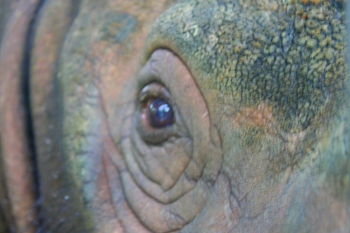 Meeting Tam in Borneo: our last chance to save Asia’s two horned rhino Nothing can really prepare a person for coming face-to-face with what may be the last of a species. I had known for a week that I would be fortunate enough to meet Tam. I’d heard stories of his gentle demeanor, discussed his […]
Meeting Tam in Borneo: our last chance to save Asia’s two horned rhino Nothing can really prepare a person for coming face-to-face with what may be the last of a species. I had known for a week that I would be fortunate enough to meet Tam. I’d heard stories of his gentle demeanor, discussed his […]
Emotional call for palm oil industry to address environmental problems
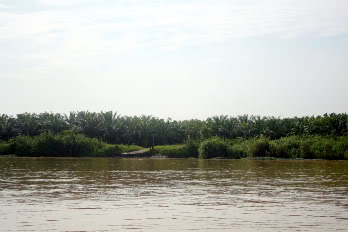 During what was at times an emotional speech, Sabah’s Minister of Tourism, Culture, and Environment, Datuk Masidi Manjun, called on the palm oil industry to stop polluting rivers and work with NGOs to save orangutans and other wildlife. He delivered the speech on the first day of an Orangutan Conservation Colloquium held in early October […]
During what was at times an emotional speech, Sabah’s Minister of Tourism, Culture, and Environment, Datuk Masidi Manjun, called on the palm oil industry to stop polluting rivers and work with NGOs to save orangutans and other wildlife. He delivered the speech on the first day of an Orangutan Conservation Colloquium held in early October […]
Palm oil industry pledges wildlife corridors to save orangutans
 In an unlikely—and perhaps tenuous—alliance, conservationists and the palm oil industry met this week to draw up plans to save Asia’s last great ape, the orangutan. As if to underscore the colloquium’s importance, delegates on arriving in the Malaysian State of Sabah found the capital covered in a thick and strange fog caused by the […]
In an unlikely—and perhaps tenuous—alliance, conservationists and the palm oil industry met this week to draw up plans to save Asia’s last great ape, the orangutan. As if to underscore the colloquium’s importance, delegates on arriving in the Malaysian State of Sabah found the capital covered in a thick and strange fog caused by the […]
Will tropical trees survive climate change?, an interview with Kenneth J. Feeley
 Fifth in a series of interviews with participants at the 2009 Association of Tropical Biology and Conservation (ATBC) conference. One of the most pressing issues in the conservation today is how climate change will affect tropical ecosystems. The short answer is: we don’t know. Because of this, more and more scientists are looking at the […]
Fifth in a series of interviews with participants at the 2009 Association of Tropical Biology and Conservation (ATBC) conference. One of the most pressing issues in the conservation today is how climate change will affect tropical ecosystems. The short answer is: we don’t know. Because of this, more and more scientists are looking at the […]
‘Greening’ logging concessions could help save great apes
 Promoting reduced impact logging in forest areas already under concession could help protect populations of endangered great apes, argues a new report published by WWF. Analyzing scientific studies on the consequences of different types of logging on great apes, Arnold van Kreveld and Ingrid Roerhorst found that logging concessions certified by the Forest Stewardship Council […]
Promoting reduced impact logging in forest areas already under concession could help protect populations of endangered great apes, argues a new report published by WWF. Analyzing scientific studies on the consequences of different types of logging on great apes, Arnold van Kreveld and Ingrid Roerhorst found that logging concessions certified by the Forest Stewardship Council […]
Crowned sifaka population on the verge of local extinction: dispatch from the field
 A small group of crowned sifaka lemurs Propithecus coronatus have been located in the corridor d’Amboloando-Dabolava, Miandrivazo district-Madagascar, but are immediately threatened with local extinction. The small, fragmented, and isolated forest shelters a group of only six adults and one baby. Interviews with local people revealed that once several groups of the species resided in […]
A small group of crowned sifaka lemurs Propithecus coronatus have been located in the corridor d’Amboloando-Dabolava, Miandrivazo district-Madagascar, but are immediately threatened with local extinction. The small, fragmented, and isolated forest shelters a group of only six adults and one baby. Interviews with local people revealed that once several groups of the species resided in […]
Saving one of the last tropical dry forests, an interview with Edwina von Gal

Revolutionary new theory overturns modern meteorology with claim that forests move rain
 Largely ignored by scientific community, new theory could change how future generations view forests Two Russian scientists, Victor Gorshkov and Anastassia Makarieva of the St. Petersburg Nuclear Physics, have published a revolutionary theory that turns modern meteorology on its head, positing that forests—and their capacity for condensation—are actually the main driver of winds rather than […]
Largely ignored by scientific community, new theory could change how future generations view forests Two Russian scientists, Victor Gorshkov and Anastassia Makarieva of the St. Petersburg Nuclear Physics, have published a revolutionary theory that turns modern meteorology on its head, positing that forests—and their capacity for condensation—are actually the main driver of winds rather than […]
Amazon scientists awarded ‘Nobel Prize’ of conservation
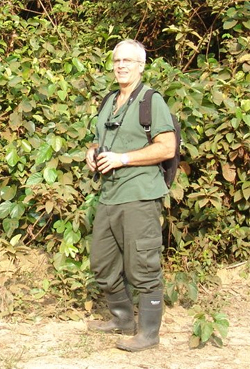
How to make forest fragments more hospitable to wildlife
 While deforestation garners more attention from environmentalists, fragmentation of forest habitats is of significant concern to ecologists. As forest is fragmented into islands by logging, roads, agriculture, and other disturbances, edge effects alter the structure, microclimate and species composition of the forest patches, usually reducing the overall number of species. Forest specialists are most likely […]
While deforestation garners more attention from environmentalists, fragmentation of forest habitats is of significant concern to ecologists. As forest is fragmented into islands by logging, roads, agriculture, and other disturbances, edge effects alter the structure, microclimate and species composition of the forest patches, usually reducing the overall number of species. Forest specialists are most likely […]
Selective logging occurs in 28 percent of world’s rainforests
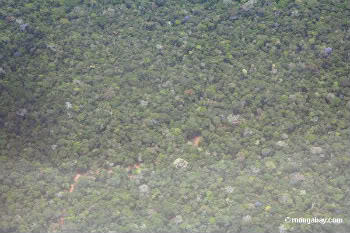 using satellite imagery. Satellites could detect clear-cutting of the rainforest with great accuracy, but detecting the subtle changes caused by selective logging, which Asner describes as “cryptic”, has only been achieved in recent years with more sophisticated satellite technology.. Asner noted that despite decades of attention from the conservation community, deforestation decade-by-decade has risen, not […]
using satellite imagery. Satellites could detect clear-cutting of the rainforest with great accuracy, but detecting the subtle changes caused by selective logging, which Asner describes as “cryptic”, has only been achieved in recent years with more sophisticated satellite technology.. Asner noted that despite decades of attention from the conservation community, deforestation decade-by-decade has risen, not […]
Forest corridors key to maintaining biodiversity in fragmented landscape
 Forest corridors key to maintaining biodiversity in fragmented landscape Forest corridors key to maintaining biodiversity in fragmented landscape: An interview with Brazilian carnivore researcher Fernanda Michalski Rhett A. Butler, mongabay.com October 7, 2008
Forest corridors key to maintaining biodiversity in fragmented landscape Forest corridors key to maintaining biodiversity in fragmented landscape: An interview with Brazilian carnivore researcher Fernanda Michalski Rhett A. Butler, mongabay.com October 7, 2008
Island biogeography theory doesn’t explain biodiversity changes in forest fragments
 Island biogeography theory has been surpassed when it comes to forest fragmentation Island biogeography theory doesn’t explain biodiversity changes in forest fragments mongabay.com July 28, 2008 Island biogeography theory, the idea that fragmented ecosystems have lower species richness per unit of area compared with contiguous habitats, has served as a useful conceptual model to understand […]
Island biogeography theory has been surpassed when it comes to forest fragmentation Island biogeography theory doesn’t explain biodiversity changes in forest fragments mongabay.com July 28, 2008 Island biogeography theory, the idea that fragmented ecosystems have lower species richness per unit of area compared with contiguous habitats, has served as a useful conceptual model to understand […]
Markets could save forests: An interview with Dr. Tom Lovejoy
 Market mechanisms are increasingly seen as a way to address environmental problems, including tropical deforestation. In particular, compensation for ecosystem services like carbon sequestration — a concept known by the acronym REDD for “reducing emissions from deforestation and degradation” — may someday make conservation a profitable enterprise in which carbon traders are effectively saving rainforests […]
Market mechanisms are increasingly seen as a way to address environmental problems, including tropical deforestation. In particular, compensation for ecosystem services like carbon sequestration — a concept known by the acronym REDD for “reducing emissions from deforestation and degradation” — may someday make conservation a profitable enterprise in which carbon traders are effectively saving rainforests […]
Fragmentation puts Mexican howlers at risk
Fragmentation puts Mexican howlers at risk Fragmentation puts Mexican howlers at risk mongabay.com March 3, 2008 Forest fragmentation is putting mantled howler monkeys in southern Mexico at risk, reports a new study, published in the inaugural issue of the open access e-journal Tropical Conservation Science. Using Population viability analysis (PVA) to forecast the probability of […]
Rainforest fragmentation affects reptiles and amphibians
 Rainforest fragmentation affects reptiles and amphibians Rainforest fragmentation affects reptiles and amphibians A technical paper by J. Nicolás Urbina-Cardona mongabay.com February 20, 2008 RAINFOREST HERPETOFAUNA AND FOREST FRAGMENTATION: EFFECTS ON DIVERSITY, COMPOSITION, ABUNDANCE AND MICROHABITAT RELATIONSHIPS Deforestation of tropical ecosystems is one of the major threats to biological diversity (Picture 1). Anthropogenic activities transform tropical […]
Rainforest fragmentation affects reptiles and amphibians Rainforest fragmentation affects reptiles and amphibians A technical paper by J. Nicolás Urbina-Cardona mongabay.com February 20, 2008 RAINFOREST HERPETOFAUNA AND FOREST FRAGMENTATION: EFFECTS ON DIVERSITY, COMPOSITION, ABUNDANCE AND MICROHABITAT RELATIONSHIPS Deforestation of tropical ecosystems is one of the major threats to biological diversity (Picture 1). Anthropogenic activities transform tropical […]
Amazon riparian zones need to be expanded to protect wildlife finds study
Amazon riparian zones need to be expanded to protect wildlife finds study Amazon riparian zones need to be expanded to protect wildlife finds study Rhett A. Butler, mongabay.com February 19, 2008 Strips of forest mandated by Brazilian law along rivers and streams in the Amazon rainforest are too narrow to effectively safeguard biodiversity, reports new […]
Parasites a key to the decline of red colobus monkeys in forest fragments
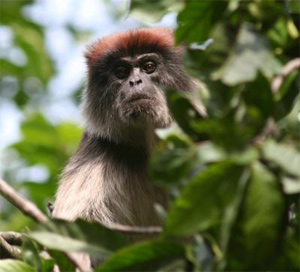 Parasites a key to the decline of red colobus monkeys in forest fragments Parasites a key to the decline of red colobus monkeys in forest fragments University of Illinois at Urbana-Champaign October 25, 2007 Forest fragmentation threatens biodiversity, often causing declines or local extinctions in a majority of species while enhancing the prospects of a […]
Parasites a key to the decline of red colobus monkeys in forest fragments Parasites a key to the decline of red colobus monkeys in forest fragments University of Illinois at Urbana-Champaign October 25, 2007 Forest fragmentation threatens biodiversity, often causing declines or local extinctions in a majority of species while enhancing the prospects of a […]
Experts: parks effectively protect rainforest in Peru
 Experts: parks effectively protect rainforest in Peru Experts: parks effectively protect rainforest in Peru mongabay.com August 9, 2007 High-resolution satellite monitoring of the Amazon rainforest in Peru shows that land-use and conservation policies have had a measurable impact on deforestation rates. The research is published in the August 9, 2007, on-line edition of Science Express. […]
Experts: parks effectively protect rainforest in Peru Experts: parks effectively protect rainforest in Peru mongabay.com August 9, 2007 High-resolution satellite monitoring of the Amazon rainforest in Peru shows that land-use and conservation policies have had a measurable impact on deforestation rates. The research is published in the August 9, 2007, on-line edition of Science Express. […]
Sedentary, not migratory birds, face higher extinction risk
 Sedentary, not migratory birds, face higher extinction risk Sedentary, not migratory birds, face higher extinction risk Rhett A. Butler, mongabay.com June 24, 2007 Sedentary birds face considerably higher risk of extinction than migratory birds, reports a new paper published in the journal Current Biology. The findings have implications for the conservation of increasingly endangered wildlife […]
Sedentary, not migratory birds, face higher extinction risk Sedentary, not migratory birds, face higher extinction risk Rhett A. Butler, mongabay.com June 24, 2007 Sedentary birds face considerably higher risk of extinction than migratory birds, reports a new paper published in the journal Current Biology. The findings have implications for the conservation of increasingly endangered wildlife […]
Logging roads rapidly expanding in Congo rainforest
 Logging roads rapidly expanding in Congo rainforest Logging roads rapidly expanding in Congo rainforest mongabay.com June 7, 2007 Logging roads are rapidly expanding in the Congo rainforest, report researchers who have constructed the first satellite-based maps of road construction in Central Africa. The authors say the work will help conservation agencies, governments, and scientists better […]
Logging roads rapidly expanding in Congo rainforest Logging roads rapidly expanding in Congo rainforest mongabay.com June 7, 2007 Logging roads are rapidly expanding in the Congo rainforest, report researchers who have constructed the first satellite-based maps of road construction in Central Africa. The authors say the work will help conservation agencies, governments, and scientists better […]
Congo forest elephants declining from logging roads, illegal ivory
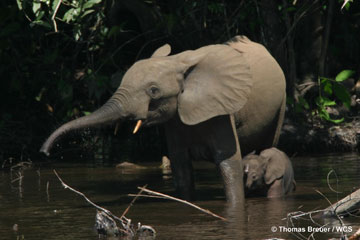 Congo forest elephants declining due to logging roads, illegal ivory trade Congo forest elephants declining from logging roads, illegal ivory Rhettt A. Butler, mongabay.com April 1, 2007 Fast-expanding logging roads in the Congo basin are becoming “highways of death” for the fierce but elusive forest elephant, according to a new study published in the journal […]
Congo forest elephants declining due to logging roads, illegal ivory trade Congo forest elephants declining from logging roads, illegal ivory Rhettt A. Butler, mongabay.com April 1, 2007 Fast-expanding logging roads in the Congo basin are becoming “highways of death” for the fierce but elusive forest elephant, according to a new study published in the journal […]
Extinction risk accelerated when interacting human threats interact
 A new study warns that the simultaneous effect of habitat fragmentation, overexploitation, and climate warming could increase the risk of a species’ extinction. Writing in the Proceedings of the Royal Society B, a team of scientists led by Camilo Mora at Dalhousie University, report that experiments with microscopic rotifers (a type of zooplankton) show that […]
A new study warns that the simultaneous effect of habitat fragmentation, overexploitation, and climate warming could increase the risk of a species’ extinction. Writing in the Proceedings of the Royal Society B, a team of scientists led by Camilo Mora at Dalhousie University, report that experiments with microscopic rotifers (a type of zooplankton) show that […]
Fragmentation killing species in the Amazon rainforest
 Fragmentation reduces biodiversity in the Amazon rainforest and worsens global warming Fragmentation reduces biodiversity in the Amazon rainforest and worsens global warming Rhett Butler, mongabay.com November 27, 2006 Forest fragmentation is rapidly eroding biodiversity in the Amazon rainforest and could worsen global warming according to research to be published this week in the journal Proceedings […]
Fragmentation reduces biodiversity in the Amazon rainforest and worsens global warming Fragmentation reduces biodiversity in the Amazon rainforest and worsens global warming Rhett Butler, mongabay.com November 27, 2006 Forest fragmentation is rapidly eroding biodiversity in the Amazon rainforest and could worsen global warming according to research to be published this week in the journal Proceedings […]
Rainforests face myriad of threats says leading Amazon scholar
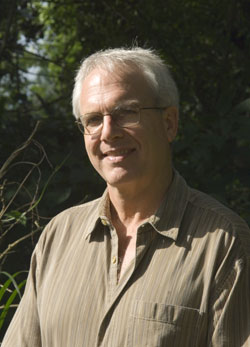 Rainforests face myriad of threats says leading Amazon scholar Rainforests face myriad of threats says leading Amazon scholar But there are reasons to be optimistic adds biologist William F. Laurance Rhett A. Butler, mongabay.com October 16, 2006 An interview with tropical biologist William F. Laurance William F. Laurance The world’s tropical rainforests are in trouble. […]
Rainforests face myriad of threats says leading Amazon scholar Rainforests face myriad of threats says leading Amazon scholar But there are reasons to be optimistic adds biologist William F. Laurance Rhett A. Butler, mongabay.com October 16, 2006 An interview with tropical biologist William F. Laurance William F. Laurance The world’s tropical rainforests are in trouble. […]
Does tropical biodiversity increase during global warming?
 Does tropical biodiversity increase during global warming?
Does tropical biodiversity increase during global warming?
Pandas threatened by roads and forest fragmentation in China
 Pandas threatened by roads and forest fragmentation in China Pandas threatened by roads and forest fragmentation in China mongabay.com December 5, 2005 China’s endangered giant panda is threatened by the rapid expansion of the national highway network, which causing fragmentation of its natural habitat, according to Chinese state media. The problem greatest in the country’s […]
Pandas threatened by roads and forest fragmentation in China Pandas threatened by roads and forest fragmentation in China mongabay.com December 5, 2005 China’s endangered giant panda is threatened by the rapid expansion of the national highway network, which causing fragmentation of its natural habitat, according to Chinese state media. The problem greatest in the country’s […]
Amazon rainforest biodiversity due to biology not climate change says study
 Amazon rainforest biodiversity due to biology not climate change says study Amazon rainforest biodiversity due to biology not climate change says study Rhett A. Butler, mongabay.com December 5, 2005 The biodiversity of the Amazon rainforest results from biological factors, not climate change as widely thought, says new research published in the journal Proceedings of the […]
Amazon rainforest biodiversity due to biology not climate change says study Amazon rainforest biodiversity due to biology not climate change says study Rhett A. Butler, mongabay.com December 5, 2005 The biodiversity of the Amazon rainforest results from biological factors, not climate change as widely thought, says new research published in the journal Proceedings of the […]
Feeds: news | india | latam | brasil | indonesia
 Energy has become a contentious and politicized topic, spurring activism, whether it be the fossil fuel divestment campaign, Keystone pipeline protests, or concern over wind turbine harm to birds. But whatever energy future we choose, two things are clear: an expanding human population will need more energy, and no matter what energy source we pick, […]
Energy has become a contentious and politicized topic, spurring activism, whether it be the fossil fuel divestment campaign, Keystone pipeline protests, or concern over wind turbine harm to birds. But whatever energy future we choose, two things are clear: an expanding human population will need more energy, and no matter what energy source we pick, […] Fragments of forest in the agricultural landscape around Sinop, Brazil, an area where soybean farming and cattle ranching have expanded at the expense of the Amazon rainforest. Image courtesy of Google Earth. The world’s forests are fragmented and deteriorating, states a new paper published in Science Advances. After analyzing satellite imagery and compiling data from […]
Fragments of forest in the agricultural landscape around Sinop, Brazil, an area where soybean farming and cattle ranching have expanded at the expense of the Amazon rainforest. Image courtesy of Google Earth. The world’s forests are fragmented and deteriorating, states a new paper published in Science Advances. After analyzing satellite imagery and compiling data from […] New study finds habitat fragmentation may lead to increased nest predation The tropical montane forests of the Cameroon mountain ranges boast fertile volcanic soils, high biodiversity of grasses and non-woody plants, as well as many endemic bird species that can be found only in this high-altitude region. Yet, many of these endemic bird species may […]
New study finds habitat fragmentation may lead to increased nest predation The tropical montane forests of the Cameroon mountain ranges boast fertile volcanic soils, high biodiversity of grasses and non-woody plants, as well as many endemic bird species that can be found only in this high-altitude region. Yet, many of these endemic bird species may […] Scientists have long known that forest fragments are not the same ecologically as intact forest landscapes. When forests are slashed into fragments, winds dry out the edges leading to dying trees and rising temperatures. Biodiversity often drops, while local extinctions rise and big animals vanish. Now, a new study finds another worrisome impact of forest […]
Scientists have long known that forest fragments are not the same ecologically as intact forest landscapes. When forests are slashed into fragments, winds dry out the edges leading to dying trees and rising temperatures. Biodiversity often drops, while local extinctions rise and big animals vanish. Now, a new study finds another worrisome impact of forest […] Development of roads and other structures disturb large, continuous patches of habitat for wildlife. This habitat fragmentation is one of the biggest contributors to species extinction, as the local ecology and species interactions are altered. A new study published in mongabay.com’s open-access journal Tropical Conservation Science finds that leaf-nosed bat abundances in Mexico are closely […]
Development of roads and other structures disturb large, continuous patches of habitat for wildlife. This habitat fragmentation is one of the biggest contributors to species extinction, as the local ecology and species interactions are altered. A new study published in mongabay.com’s open-access journal Tropical Conservation Science finds that leaf-nosed bat abundances in Mexico are closely […] Nearly a quarter of two reserves’ forest cover lost within the last 13 years In southeastern Nicaragua, abutting the coastal Caribbean town of Bluefields, lie two nature reserves – Cerro Silva and Punta Gorda – that are embroiled in a bitter battle for survival against the speedily encroaching agricultural frontier. The forest is all but […]
Nearly a quarter of two reserves’ forest cover lost within the last 13 years In southeastern Nicaragua, abutting the coastal Caribbean town of Bluefields, lie two nature reserves – Cerro Silva and Punta Gorda – that are embroiled in a bitter battle for survival against the speedily encroaching agricultural frontier. The forest is all but […] Researchers urge increased conservation attention for invertebrates, fragmented habitats A team of scientists from the United States and Germany has recently described seven new species of Malagasy giant pill-millipede. All but one of these species are considered “microendemics,” in that they have only been found in small, isolated forest patches. The study was published in […]
Researchers urge increased conservation attention for invertebrates, fragmented habitats A team of scientists from the United States and Germany has recently described seven new species of Malagasy giant pill-millipede. All but one of these species are considered “microendemics,” in that they have only been found in small, isolated forest patches. The study was published in […] Chimp habitat disappearing as river basin loses forest cover Uganda’s Kafu River, which is about 180 kilometers (110 miles) long, is part of a vast chimpanzee habitat that includes Budongo and Bugoma Forest Reserves, as well as several unofficial protected areas. However, this region is losing a significant portion of valuable chimpanzee habitat, with Global […]
Chimp habitat disappearing as river basin loses forest cover Uganda’s Kafu River, which is about 180 kilometers (110 miles) long, is part of a vast chimpanzee habitat that includes Budongo and Bugoma Forest Reserves, as well as several unofficial protected areas. However, this region is losing a significant portion of valuable chimpanzee habitat, with Global […] Study urges alteration of management practices Habitat fragmentation and hunting are both distinct critical issues facing forests today that require their own countermeasures. Yet, much research has chosen to conflate the two, potentially leading to ineffective ecosystem management. According to a new study recently published in mongabay.com’s open access journal, Tropical Conservation Science, the interaction […]
Study urges alteration of management practices Habitat fragmentation and hunting are both distinct critical issues facing forests today that require their own countermeasures. Yet, much research has chosen to conflate the two, potentially leading to ineffective ecosystem management. According to a new study recently published in mongabay.com’s open access journal, Tropical Conservation Science, the interaction […] Highway development may isolate bird populations in Brazil, Peru When a massive road project connected the ports of Brazil to the shipping docks of Peru in 2011, spanning the South American continent, conservationists predicted widespread impacts on wildlife living along the route that stretches almost 5,500 kilometers (about 3,400 miles). Roads are a well-documented source […]
Highway development may isolate bird populations in Brazil, Peru When a massive road project connected the ports of Brazil to the shipping docks of Peru in 2011, spanning the South American continent, conservationists predicted widespread impacts on wildlife living along the route that stretches almost 5,500 kilometers (about 3,400 miles). Roads are a well-documented source […] Fragmentation in Rondonia, Brazil. Courtesy of Google Earth Climate change may be taking a hidden toll on intact rainforests in the heart of the Amazon, finds a new study based on 35 years of observations. The research, published in the journal Ecology, focused on the ecological impacts of fragmentation but unexpectedly found changes in the […]
Fragmentation in Rondonia, Brazil. Courtesy of Google Earth Climate change may be taking a hidden toll on intact rainforests in the heart of the Amazon, finds a new study based on 35 years of observations. The research, published in the journal Ecology, focused on the ecological impacts of fragmentation but unexpectedly found changes in the […] With food and water scarce in many parts of Africa, many species migrate long-distances in order to survive. A new study published in the journal, Oryx has found a new record-breaker for the continent’s longest tracked terrestrial migration: a huge group of zebras that traveled a total distance of 500 kilometers (300 miles). The journey […]
With food and water scarce in many parts of Africa, many species migrate long-distances in order to survive. A new study published in the journal, Oryx has found a new record-breaker for the continent’s longest tracked terrestrial migration: a huge group of zebras that traveled a total distance of 500 kilometers (300 miles). The journey […] The Theory of Island Biogeography, coined by Robert MacArthur and E.O. Wilson, helps describe why species are distributed as they are. The larger and closer an island is to another (or to the mainland), the more biodiverse it should be. This can be used to describe actual islands in the ocean, like the Galapagos, or […]
The Theory of Island Biogeography, coined by Robert MacArthur and E.O. Wilson, helps describe why species are distributed as they are. The larger and closer an island is to another (or to the mainland), the more biodiverse it should be. This can be used to describe actual islands in the ocean, like the Galapagos, or […] Although the Republic of the Congo has opened up nearly 90 percent of its lowland forests to logging, the majority of the logging occurring in the country is still illegal, according to a new report from the Chatham House. In fact the UK policy institute finds that illegal logging in the Republic of the Congo […]
Although the Republic of the Congo has opened up nearly 90 percent of its lowland forests to logging, the majority of the logging occurring in the country is still illegal, according to a new report from the Chatham House. In fact the UK policy institute finds that illegal logging in the Republic of the Congo […] Innovation in Tropical Forest Conservation: Q&A with Dr. Phillip Fearnside Pasture meets gallery forest in the Brazilian Amazon. Photo by: Rhett A. Butler. How much is a forest really worth? And what is the cost of forest degradation? These values are difficult to estimate, but according to Dr. Phillip Fearnside, we need to do a […]
Innovation in Tropical Forest Conservation: Q&A with Dr. Phillip Fearnside Pasture meets gallery forest in the Brazilian Amazon. Photo by: Rhett A. Butler. How much is a forest really worth? And what is the cost of forest degradation? These values are difficult to estimate, but according to Dr. Phillip Fearnside, we need to do a […] The turkey-sized, noisy, fruit-feasting guans are arguably one of the strangest wildlife sightings in the tropical forests of Central and South America. Ancient animals, these birds are members of the Cracidae family—which also include equally-odd currasows and chachalacas—and are actually distantly related to megapode, or mound-building, birds of Australiasia. A new study in mongabay.com’s open-access […]
The turkey-sized, noisy, fruit-feasting guans are arguably one of the strangest wildlife sightings in the tropical forests of Central and South America. Ancient animals, these birds are members of the Cracidae family—which also include equally-odd currasows and chachalacas—and are actually distantly related to megapode, or mound-building, birds of Australiasia. A new study in mongabay.com’s open-access […] Scientists have identified a new species of day gecko that is the largest in its genus (Cnemaspis) to be found in Sri Lanka. To date, it has been observed only within the Rammalakanda Reserve in southern Sri Lanka, an area spanning just 1,700 hectares, raising questions about the viability of this population and hence the […]
Scientists have identified a new species of day gecko that is the largest in its genus (Cnemaspis) to be found in Sri Lanka. To date, it has been observed only within the Rammalakanda Reserve in southern Sri Lanka, an area spanning just 1,700 hectares, raising questions about the viability of this population and hence the […] Innovation in Tropical Forest Conservation: Q&A with Stuart Pimm Aerial view of forest fragment in Costa Rica. Photo by Rhett A. Butler. Dr. Stuart Pimm is an expert in extinctions: why they happen, how fast they happen, and how they can be prevented. Reconnecting forest fragments and avoiding fragmentation, according to Pimm, are among the […]
Innovation in Tropical Forest Conservation: Q&A with Stuart Pimm Aerial view of forest fragment in Costa Rica. Photo by Rhett A. Butler. Dr. Stuart Pimm is an expert in extinctions: why they happen, how fast they happen, and how they can be prevented. Reconnecting forest fragments and avoiding fragmentation, according to Pimm, are among the […] An interview with Nurzahafarina Othman, a part of our on-going Interviews with Young Scientists series. Bornean elephants tussling on the Kinabatangan River. Photo courtesy of: Nurzahafarina Othman. In the Malaysian state of Sabah, where most conservation students are still foreigners—either European or American—Nurzahafarina Othman stands out: not only is she Malaysian, a Muslim, and a […]
An interview with Nurzahafarina Othman, a part of our on-going Interviews with Young Scientists series. Bornean elephants tussling on the Kinabatangan River. Photo courtesy of: Nurzahafarina Othman. In the Malaysian state of Sabah, where most conservation students are still foreigners—either European or American—Nurzahafarina Othman stands out: not only is she Malaysian, a Muslim, and a […] As tropical forests worldwide are increasingly cut into smaller and smaller fragments, mammal extinctions may not be far behind, according to a new study in Science. Tracking native smalls mammals in Chiew Larn Reservoir, Thailand for over 25 years, scientists found a stunning and rapid decline in mammal populations, until most forests were almost completely […]
As tropical forests worldwide are increasingly cut into smaller and smaller fragments, mammal extinctions may not be far behind, according to a new study in Science. Tracking native smalls mammals in Chiew Larn Reservoir, Thailand for over 25 years, scientists found a stunning and rapid decline in mammal populations, until most forests were almost completely […] In a world first, scientists have captured images and video of a boa constrictor attacking and devouring whole a femle howler monkey, one of the largest new world primates weighing in at around 4 kilograms (8.8 pounds). The rare predation event was recorded in a tiny forest fragment (2.5 hectares) in the Brazilian state of […]
In a world first, scientists have captured images and video of a boa constrictor attacking and devouring whole a femle howler monkey, one of the largest new world primates weighing in at around 4 kilograms (8.8 pounds). The rare predation event was recorded in a tiny forest fragment (2.5 hectares) in the Brazilian state of […] The world’s species are in worse trouble than widely-assumed, according to a new paper in the Proceedings of the National Academy of Sciences (PNAS), which reevaluates how scientists estimate extinction rates. The new model takes into account the impact of forest fragmentation on extinction rates for the first time, filling in a gap in past […]
The world’s species are in worse trouble than widely-assumed, according to a new paper in the Proceedings of the National Academy of Sciences (PNAS), which reevaluates how scientists estimate extinction rates. The new model takes into account the impact of forest fragmentation on extinction rates for the first time, filling in a gap in past […] The extinction of large, fruit-eating birds in fragments of Brazil’s Atlantic rainforest has caused palm trees to produce smaller seeds over the past century, impacting forest ecology, finds a study published in the journal Science. The researchers — led by Mauro Galetti from Brazil’s Universidade Estadual Paulista — looked at Euterpe edulis palm seeds in […]
The extinction of large, fruit-eating birds in fragments of Brazil’s Atlantic rainforest has caused palm trees to produce smaller seeds over the past century, impacting forest ecology, finds a study published in the journal Science. The researchers — led by Mauro Galetti from Brazil’s Universidade Estadual Paulista — looked at Euterpe edulis palm seeds in […] As primary forests become increasingly rare and expensive to protect, many ecologists are looking to better management of Human Modified Landscapes (HMLs) to shepherd and shield biodiversity in the tropics. Secondary forests, selectively logged forests and lands devoted to sustainable agriculture already play an important role in conservation efforts. However, the idea that HMLs will […]
As primary forests become increasingly rare and expensive to protect, many ecologists are looking to better management of Human Modified Landscapes (HMLs) to shepherd and shield biodiversity in the tropics. Secondary forests, selectively logged forests and lands devoted to sustainable agriculture already play an important role in conservation efforts. However, the idea that HMLs will […] Adult Peruvian night monkey. Photo by: Jean Paul Perret/NPC. The Peruvian night monkey (Aotus miconax) is one of the world’s least known primates, having never been studied in the wild–until now. Found only in the cloud forests of northern Peru, a group of scientists with Neotropical Primate Conservation and the National University of Mayor San […]
Adult Peruvian night monkey. Photo by: Jean Paul Perret/NPC. The Peruvian night monkey (Aotus miconax) is one of the world’s least known primates, having never been studied in the wild–until now. Found only in the cloud forests of northern Peru, a group of scientists with Neotropical Primate Conservation and the National University of Mayor San […] Helen’s tree frog. Photo courtesy of Jodi Rowley. Jodi Rowley is no stranger to discovering new amphibians—she’s helped describe over 10 in her short career thus far—but she was shocked to discover a new species of flying frog less than 100 kilometers from a major, bustling Southeast Asian metropolis, Ho Chi Minh City. Unfortunately, the […]
Helen’s tree frog. Photo courtesy of Jodi Rowley. Jodi Rowley is no stranger to discovering new amphibians—she’s helped describe over 10 in her short career thus far—but she was shocked to discover a new species of flying frog less than 100 kilometers from a major, bustling Southeast Asian metropolis, Ho Chi Minh City. Unfortunately, the […] Industrial area in Kalimantan. Photo courtesy of Stanislav Lhota. The proposed extension of an industrial area in East Kalimantan, Indonesia will likely mean the end of a population of rehabilitated orangutans who reside there, according to the Indonesian environmental group Peduli Teluk Balikpapan. The Kariangau Industrial Area (KIK) will comprise 5,130 hectares of land currently […]
Industrial area in Kalimantan. Photo courtesy of Stanislav Lhota. The proposed extension of an industrial area in East Kalimantan, Indonesia will likely mean the end of a population of rehabilitated orangutans who reside there, according to the Indonesian environmental group Peduli Teluk Balikpapan. The Kariangau Industrial Area (KIK) will comprise 5,130 hectares of land currently […] New research shows that the lowland tapir is nearly extinct in the Atlantic Forest. Photo by: Jeremy Hance. When the Portuguese first arrived on the shores of what is now Brazil, a massive forest waited for them. Not the Amazon, but the Atlantic Forest, stretching for over 1.2 million kilometers. Here jaguars, the continent’s apex […]
New research shows that the lowland tapir is nearly extinct in the Atlantic Forest. Photo by: Jeremy Hance. When the Portuguese first arrived on the shores of what is now Brazil, a massive forest waited for them. Not the Amazon, but the Atlantic Forest, stretching for over 1.2 million kilometers. Here jaguars, the continent’s apex […] Surface coal mining in Bihar, India. Around 70-80 percent of India’s power is currently provided by coal. Burning coal fuels climate change, causes acid rain, and spreads toxic pollutants into the environment, but now a new Greenpeace report warns that coal may also imperil the world’s biggest feline: the tiger. Home to world’s largest population […]
Surface coal mining in Bihar, India. Around 70-80 percent of India’s power is currently provided by coal. Burning coal fuels climate change, causes acid rain, and spreads toxic pollutants into the environment, but now a new Greenpeace report warns that coal may also imperil the world’s biggest feline: the tiger. Home to world’s largest population […] Logging in Gabon, Central Africa. Photo by Rhett A. Butler. Industrial logging in primary tropical forests that is both sustainable and profitable is impossible, argues a new study in Bioscience, which finds that the ecology of tropical hardwoods makes logging with truly sustainable practices not only impractical, but completely unprofitable. Given this, the researchers recommend […]
Logging in Gabon, Central Africa. Photo by Rhett A. Butler. Industrial logging in primary tropical forests that is both sustainable and profitable is impossible, argues a new study in Bioscience, which finds that the ecology of tropical hardwoods makes logging with truly sustainable practices not only impractical, but completely unprofitable. Given this, the researchers recommend […] Ratu (above) and the baby male are doing well. Photo by: International Rhino Foundation. After two miscarriages and a pregnancy that lasted 15 months, Ratu, a female Sumatra rhino, has given birth to a healthy male calf, conservationists happily announced this weekend. The birth at a rhino sanctuary in Way Kambas National Park in Sumatra […]
Ratu (above) and the baby male are doing well. Photo by: International Rhino Foundation. After two miscarriages and a pregnancy that lasted 15 months, Ratu, a female Sumatra rhino, has given birth to a healthy male calf, conservationists happily announced this weekend. The birth at a rhino sanctuary in Way Kambas National Park in Sumatra […] Sawmill in Indonesia. Photo by: Rhett A. Butler. Last year researchers took the first ever publicly-released video of an African golden cat (Profelis aurata) in a Gabon rainforest. This beautiful, but elusive, feline was filmed sitting docilely for the camera and chasing a bat. The least-known of Africa’s wild cat species, the African golden cat […]
Sawmill in Indonesia. Photo by: Rhett A. Butler. Last year researchers took the first ever publicly-released video of an African golden cat (Profelis aurata) in a Gabon rainforest. This beautiful, but elusive, feline was filmed sitting docilely for the camera and chasing a bat. The least-known of Africa’s wild cat species, the African golden cat […] Forest fragments along riversides in Uganda may make good habitats for chimpanzees but remain unprotected, according to a new study in mongabay.com’s open access journal Tropical Conservation Society (TCS). Researchers surveyed a riverine forest known as Bulindi in Uganda, in-between Budongo and Bugoma Forest Reserves, to determine if it was suitable for the long-term survival […]
Forest fragments along riversides in Uganda may make good habitats for chimpanzees but remain unprotected, according to a new study in mongabay.com’s open access journal Tropical Conservation Society (TCS). Researchers surveyed a riverine forest known as Bulindi in Uganda, in-between Budongo and Bugoma Forest Reserves, to determine if it was suitable for the long-term survival […] Putut (center) and her family, after being collared in October 2011. Photo courtesy of Benoit Goossens. Forest fragmentation and destruction is imperiling the Bornean elephant (Elephas maximus borneensis), according to a new paper published in PLoS ONE. Using satellite collars to track the pachyderms for the first time in the Malaysian state of Sabah, scientists […]
Putut (center) and her family, after being collared in October 2011. Photo courtesy of Benoit Goossens. Forest fragmentation and destruction is imperiling the Bornean elephant (Elephas maximus borneensis), according to a new paper published in PLoS ONE. Using satellite collars to track the pachyderms for the first time in the Malaysian state of Sabah, scientists […] Illegally logged tree in Indonesia. Photo by: Rhett A. Butler. Australia should join the widening effort to stamp out illegal logging, according to testimony given this week by tropical ecologist William Laurance with James Cook University. Presenting before the Australian Senate’s rural affairs committee, Laurance argued that the massive environmental and economic costs of illegal […]
Illegally logged tree in Indonesia. Photo by: Rhett A. Butler. Australia should join the widening effort to stamp out illegal logging, according to testimony given this week by tropical ecologist William Laurance with James Cook University. Presenting before the Australian Senate’s rural affairs committee, Laurance argued that the massive environmental and economic costs of illegal […] Gibbon released into new home. Photo by: Dipankar Bhagawati. Two Hoolock gibbons have been successfully translocated from a fragmented forest to Mehao Wildlife Sanctuary in the beginning of a desperate bid to save 18 family groups of India’s last apes. Living near the village of Dello in northeastern India, the apes were straining to survive […]
Gibbon released into new home. Photo by: Dipankar Bhagawati. Two Hoolock gibbons have been successfully translocated from a fragmented forest to Mehao Wildlife Sanctuary in the beginning of a desperate bid to save 18 family groups of India’s last apes. Living near the village of Dello in northeastern India, the apes were straining to survive […] Kivu giant pouched rat caught on camera trap eating a seed of Carapa grandiflora. Photo by: Aisha Nyiramana. Rats are rarely thought of as heroes. In fact, in many parts of the world they are despised, while in others they serve largely as food. But, scientists are now discovering that many tropical forest rodents, including […]
Kivu giant pouched rat caught on camera trap eating a seed of Carapa grandiflora. Photo by: Aisha Nyiramana. Rats are rarely thought of as heroes. In fact, in many parts of the world they are despised, while in others they serve largely as food. But, scientists are now discovering that many tropical forest rodents, including […] Central Suriname Nature Reserve, Suriname. A jaguar (Panthera Onca), a Near Threatened species. Of the sites researched, Suriname’s site presented the highest number of species diversity. Photo courtesy of Conservation International Suriname, a member of the TEAM network. A groundbreaking cameratrap study has mapped the abundance, or lack thereof, of tropical mammal populations across seven […]
Central Suriname Nature Reserve, Suriname. A jaguar (Panthera Onca), a Near Threatened species. Of the sites researched, Suriname’s site presented the highest number of species diversity. Photo courtesy of Conservation International Suriname, a member of the TEAM network. A groundbreaking cameratrap study has mapped the abundance, or lack thereof, of tropical mammal populations across seven […] Forest fragments under research in the Biological Dynamics of Forest Fragments Project. Photo by: Richard Bierregaard. For over 30 years, hundreds of scientists have scoured eleven forest fragments in the Amazon seeking answers to big questions: how do forest fragments’ species and microclimate differ from their intact relatives? Will rainforest fragments provide a safe haven […]
Forest fragments under research in the Biological Dynamics of Forest Fragments Project. Photo by: Richard Bierregaard. For over 30 years, hundreds of scientists have scoured eleven forest fragments in the Amazon seeking answers to big questions: how do forest fragments’ species and microclimate differ from their intact relatives? Will rainforest fragments provide a safe haven […] An Asian elephant wanders through tea fields in the Western Ghats. Photo © Kalyan Varma. When one thinks of the world’s great rainforests the Amazon, Congo, and the tropical forests of Southeast Asia and Indonesia usually come to mind. Rarely does India—home to over a billion people—make an appearance. But along India’s west coast lies […]
An Asian elephant wanders through tea fields in the Western Ghats. Photo © Kalyan Varma. When one thinks of the world’s great rainforests the Amazon, Congo, and the tropical forests of Southeast Asia and Indonesia usually come to mind. Rarely does India—home to over a billion people—make an appearance. But along India’s west coast lies […] Forest elephant. Photo by: Carlton Ward Junior. An interview with Ahimsa Campos-Arceiz and Stephen Blake. Warning: graphic images below. It seems difficult to imagine elephants delicately tending a garden, but these pachyderms may well be the world’s weightiest horticulturalist. Elephants both in Asia and Africa eat abundant amounts of fruit when available; seeds pass through […]
Forest elephant. Photo by: Carlton Ward Junior. An interview with Ahimsa Campos-Arceiz and Stephen Blake. Warning: graphic images below. It seems difficult to imagine elephants delicately tending a garden, but these pachyderms may well be the world’s weightiest horticulturalist. Elephants both in Asia and Africa eat abundant amounts of fruit when available; seeds pass through […] In the cloud forests and grasslands of India’s Western Ghats, known as sholas, researchers have for the first time comprehensively studied the inhabiting dung beetle populations. The resulting study in mongabay.com’s open access journal Tropical Conservation Science, has led scientists to hypothesize that the beetles in concordance with the sheep-like mammal, the nilgiri tahr (Nilgiritragus […]
In the cloud forests and grasslands of India’s Western Ghats, known as sholas, researchers have for the first time comprehensively studied the inhabiting dung beetle populations. The resulting study in mongabay.com’s open access journal Tropical Conservation Science, has led scientists to hypothesize that the beetles in concordance with the sheep-like mammal, the nilgiri tahr (Nilgiritragus […] Less than 200 blond capuchins (Cebus falvius) survive in the highly-fragmented habitat of Brazil’s Atlantic Forest. But this tiny group of monkeys, only rediscovered in 2006, is surprising scientists with its adept tool-using abilities. Displaying similar behavior to that which made the chimpanzees of Gombe famous worldwide, the blond capuchins modify sticks to gather termites […]
Less than 200 blond capuchins (Cebus falvius) survive in the highly-fragmented habitat of Brazil’s Atlantic Forest. But this tiny group of monkeys, only rediscovered in 2006, is surprising scientists with its adept tool-using abilities. Displaying similar behavior to that which made the chimpanzees of Gombe famous worldwide, the blond capuchins modify sticks to gather termites […] As everyone knows, human zombies are created when an uninfected human is bitten by a member of the brain-craving undead. But what about ant zombies? Yes, that’s right: ant zombies. In the South American rainforest, ants have a mortal enemy: the parasitic fungi in the Ophiocordyceps (also known as Cordyceps) genus. These fungi infect ants […]
As everyone knows, human zombies are created when an uninfected human is bitten by a member of the brain-craving undead. But what about ant zombies? Yes, that’s right: ant zombies. In the South American rainforest, ants have a mortal enemy: the parasitic fungi in the Ophiocordyceps (also known as Cordyceps) genus. These fungi infect ants […] The fossa. Photo © Nick Garbutt . An interview with Mia-Lana Lührs, a part of our Interviews with Young Scientists series. Madagascar is a land of wonders: dancing lemurs, thumbnail-sized chameleons, the long-fingered aye-aye, great baobab trees, and the mighty fossa. Wait—what? What’s a fossa? It’s true that when people think of Madagascar rarely do […]
The fossa. Photo © Nick Garbutt . An interview with Mia-Lana Lührs, a part of our Interviews with Young Scientists series. Madagascar is a land of wonders: dancing lemurs, thumbnail-sized chameleons, the long-fingered aye-aye, great baobab trees, and the mighty fossa. Wait—what? What’s a fossa? It’s true that when people think of Madagascar rarely do […] Clouded leopard female and her cub caught on camera trap in a corridor in the vicinity of DGFC. Photo courtesy of Sabah Wildlife Department, Danau Girang Field Centre and HUTAN. Camera trap photos taken in the fragmented forest along the Kinabatangan River in Borneo have revealed a number of key mammal species surviving despite forest […]
Clouded leopard female and her cub caught on camera trap in a corridor in the vicinity of DGFC. Photo courtesy of Sabah Wildlife Department, Danau Girang Field Centre and HUTAN. Camera trap photos taken in the fragmented forest along the Kinabatangan River in Borneo have revealed a number of key mammal species surviving despite forest […] Oil palm and rainforest Scientists have partnered with one of the world’s largest palm oil producers to measure the impact of converting tropical forest into an oil palm plantation, reports Nature News. The Stability of Altered Forest Ecosystems project will monitor ecological changes—including biodiversity, erosion, soil quality, carbon dioxide emissions, and water pollution—in roughly 7,000 […]
Oil palm and rainforest Scientists have partnered with one of the world’s largest palm oil producers to measure the impact of converting tropical forest into an oil palm plantation, reports Nature News. The Stability of Altered Forest Ecosystems project will monitor ecological changes—including biodiversity, erosion, soil quality, carbon dioxide emissions, and water pollution—in roughly 7,000 […] Researchers have uncovered an astounding number of species in a tiny protected forest fragment surrounded on all side by palm oil plantations in the Indonesian island of Sumatra. Researchers with the Zoological Society of London (ZSL), Queen Mary, University of London and the Durrell Institute of Conservation and Ecology (DICE – University of Kent) recorded […]
Researchers have uncovered an astounding number of species in a tiny protected forest fragment surrounded on all side by palm oil plantations in the Indonesian island of Sumatra. Researchers with the Zoological Society of London (ZSL), Queen Mary, University of London and the Durrell Institute of Conservation and Ecology (DICE – University of Kent) recorded […] As nations from around the world meet at the Convention on Biological Diversity in Nagoya, Japan to discuss ways to stem the loss of biodiversity worldwide, two prominent researchers argue that environmentalists and conservationists need to consider paradigm shifts if biodiversity is to be preserved, especially in developing countries. Writing in the journal Biotropica, Douglas […]
As nations from around the world meet at the Convention on Biological Diversity in Nagoya, Japan to discuss ways to stem the loss of biodiversity worldwide, two prominent researchers argue that environmentalists and conservationists need to consider paradigm shifts if biodiversity is to be preserved, especially in developing countries. Writing in the journal Biotropica, Douglas […] A new study in Biological Conservation has shown that edge forests and forest patches are more vulnerable to burning because they are drier than intact forests. Using eight years of satellite imagery over East Amazonia, the researchers found that desiccation (extreme dryness) penetrated anywhere from 1 to 3 kilometers into forests depending on the level […]
A new study in Biological Conservation has shown that edge forests and forest patches are more vulnerable to burning because they are drier than intact forests. Using eight years of satellite imagery over East Amazonia, the researchers found that desiccation (extreme dryness) penetrated anywhere from 1 to 3 kilometers into forests depending on the level […] Sementara Amazon dihabisi pelan-pelan dari segala sisi oleh penebangan, pertanian, jalanan, peternakan, pertambangan, eksplorasi gas dan minyak, pengumuman spesies kera baru hari ini membuktikan bahwa hutan hujan tropis terbesar dunia masih memiliki banyak kejutan untuk dimunculkan. Ilmuwan dari National University of Colombia dan didukung oleh Conservation International (CI) dalam jurnal Primate Conservation telah mengumumkan penemuan […]
Sementara Amazon dihabisi pelan-pelan dari segala sisi oleh penebangan, pertanian, jalanan, peternakan, pertambangan, eksplorasi gas dan minyak, pengumuman spesies kera baru hari ini membuktikan bahwa hutan hujan tropis terbesar dunia masih memiliki banyak kejutan untuk dimunculkan. Ilmuwan dari National University of Colombia dan didukung oleh Conservation International (CI) dalam jurnal Primate Conservation telah mengumumkan penemuan […] While the Amazon is being whittled away on all sides by logging, agriculture, roads, cattle ranching, mining, oil and gas exploration, today’s announcement of a new monkey species proves that the world’s greatest tropical rainforest still has many surprises to reveal. Scientists with the National University of Colombia and support from Conservation International (CI) have […]
While the Amazon is being whittled away on all sides by logging, agriculture, roads, cattle ranching, mining, oil and gas exploration, today’s announcement of a new monkey species proves that the world’s greatest tropical rainforest still has many surprises to reveal. Scientists with the National University of Colombia and support from Conservation International (CI) have […] The Horton Plains slender loris (Loris tardigradus nycticeboides , thought extinct by researchers for over six decades, has finally posed for a photograph. This small nocturnal primate lives in the surviving montane tropical forest of Sri Lanka. The species was photographed during a recent expedition by the Zoological Society of London (ZSL)’s EDGE program in […]
The Horton Plains slender loris (Loris tardigradus nycticeboides , thought extinct by researchers for over six decades, has finally posed for a photograph. This small nocturnal primate lives in the surviving montane tropical forest of Sri Lanka. The species was photographed during a recent expedition by the Zoological Society of London (ZSL)’s EDGE program in […] A new study in Tropical Conservation Science finds that Kibale National Park in Uganda has retained its tropical forest despite pressures of a dense human population and large-scale clearing activities just beyond the border of the park. Home to twelve primate species, including Chimpanzees, the park is known as a safe-haven for African primates. Although […]
A new study in Tropical Conservation Science finds that Kibale National Park in Uganda has retained its tropical forest despite pressures of a dense human population and large-scale clearing activities just beyond the border of the park. Home to twelve primate species, including Chimpanzees, the park is known as a safe-haven for African primates. Although […] A new study in Tropical Conservation Science has found that Asian elephants living in a combination of fragmented forests and agricultural landscapes still depend on natural landscapes—rivers and forests—for survival. Following two herds of Asian elephants (Elephas maximus) in the Valparai plateau among the Anamalai Hills of India for three years, researchers found that the […]
A new study in Tropical Conservation Science has found that Asian elephants living in a combination of fragmented forests and agricultural landscapes still depend on natural landscapes—rivers and forests—for survival. Following two herds of Asian elephants (Elephas maximus) in the Valparai plateau among the Anamalai Hills of India for three years, researchers found that the […] With less than 40 individuals left in the world, the Bornean rhino is a small step away from extinction. Yet conservationists and government officials in the Malaysian state of Sabah are not letting this subspecies of the Sumatran rhino go without a fight. Implementing a daring last-ditch plan to save the animal, officials are working […]
With less than 40 individuals left in the world, the Bornean rhino is a small step away from extinction. Yet conservationists and government officials in the Malaysian state of Sabah are not letting this subspecies of the Sumatran rhino go without a fight. Implementing a daring last-ditch plan to save the animal, officials are working […] Radical, controversial, ahead-of-his-time, brilliant, or extremist: call Dr. Glen Barry, the head of Ecological Internet, what you will, but there is no question that his environmental advocacy group has achieved major successes in the past years, even if many of these are below the radar of big conservation groups and mainstream media. “We tend to […]
Radical, controversial, ahead-of-his-time, brilliant, or extremist: call Dr. Glen Barry, the head of Ecological Internet, what you will, but there is no question that his environmental advocacy group has achieved major successes in the past years, even if many of these are below the radar of big conservation groups and mainstream media. “We tend to […] The fourth in an interview series with participants in the 5th Frugivore and Seed Dispersal International Symposium. Scientists are just beginning to uncover the complex relationship between healthy biodiverse tropical forests and seed dispersers—species that spread seeds from a parent tree to other parts of the forest including birds, rodents, primates, and even elephants. By […]
The fourth in an interview series with participants in the 5th Frugivore and Seed Dispersal International Symposium. Scientists are just beginning to uncover the complex relationship between healthy biodiverse tropical forests and seed dispersers—species that spread seeds from a parent tree to other parts of the forest including birds, rodents, primates, and even elephants. By […] The third in an interview series with participants in the 5th Frugivore and Seed Dispersal International Symposium. Hornbills are one of Asia’s most attractive birds. Large, colorful, and easier to spot than most other birds, hornbills have become iconic animals in the tropical forests of Asia. Yet, most people probably don’t realize just how important […]
The third in an interview series with participants in the 5th Frugivore and Seed Dispersal International Symposium. Hornbills are one of Asia’s most attractive birds. Large, colorful, and easier to spot than most other birds, hornbills have become iconic animals in the tropical forests of Asia. Yet, most people probably don’t realize just how important […] According to most conservationists the globe is striding into the midst of the Sixth Mass Extinction. Species populations worldwide are dropping and in many cases species are vanishing all together due to pollution, climate change, poaching and hunting, overconsumption, invasive species, and exotic diseases, but no threat proves more pervasive and devastating for the world’s […]
According to most conservationists the globe is striding into the midst of the Sixth Mass Extinction. Species populations worldwide are dropping and in many cases species are vanishing all together due to pollution, climate change, poaching and hunting, overconsumption, invasive species, and exotic diseases, but no threat proves more pervasive and devastating for the world’s […] Researchers in the Malaysian state of Sabah in Borneo are joyful after receiving confirmation that a young male orangutan used a rope bridge to cross a river, which has separated one orangutan population from another. Due to logging and clearing forests for oil palm plantations, which cover 18 percent of land in Sabah, orangutans on […]
Researchers in the Malaysian state of Sabah in Borneo are joyful after receiving confirmation that a young male orangutan used a rope bridge to cross a river, which has separated one orangutan population from another. Due to logging and clearing forests for oil palm plantations, which cover 18 percent of land in Sabah, orangutans on […] The second in an interview series with participants in the 5th Frugivore and Seed Dispersal International Symposium. Without seed dispersal plants could not survive. Seed dispersal—i.e. birds spreading seeds or wind carrying seeds—means the mechanism by which a seed is moved from its parent tree to a new area; if fortunate the seed will sprout […]
The second in an interview series with participants in the 5th Frugivore and Seed Dispersal International Symposium. Without seed dispersal plants could not survive. Seed dispersal—i.e. birds spreading seeds or wind carrying seeds—means the mechanism by which a seed is moved from its parent tree to a new area; if fortunate the seed will sprout […] A new study in Tropical Conservation Science shows that small tropical mammals in Mexico—bats and rodents—require a variety of habitats to thrive. Surveying mammal populations in the Isthmus of Tehuantepec, Oaxaca, Mexico, researchers found that sites comprising the greatest habitat diversity carried also the greatest diversity of rodents. In turn bats lived in all variety […]
A new study in Tropical Conservation Science shows that small tropical mammals in Mexico—bats and rodents—require a variety of habitats to thrive. Surveying mammal populations in the Isthmus of Tehuantepec, Oaxaca, Mexico, researchers found that sites comprising the greatest habitat diversity carried also the greatest diversity of rodents. In turn bats lived in all variety […] Brazil’s golden-headed lion tamarin is a small primate with a black body and a bright mane of gold and orange. Listed as Endangered by the IUCN Red List, the golden-headed lion tamarin (Leontopithecus chrysomelas) survives in only a single protected reserve in the largely degraded Atlantic Forest in Brazil. Otherwise its habitat lies in unprotected […]
Brazil’s golden-headed lion tamarin is a small primate with a black body and a bright mane of gold and orange. Listed as Endangered by the IUCN Red List, the golden-headed lion tamarin (Leontopithecus chrysomelas) survives in only a single protected reserve in the largely degraded Atlantic Forest in Brazil. Otherwise its habitat lies in unprotected […] Considered the most threatened ecosystem in Bangladesh, the moist deciduous Sal forest (Shorea robusta) is on the verge of vanishing. In 1990 only 10 percent of the forest cover remained, down from 36 percent in 1985 according to statistics from the Food and Agricultural Organization (FAO). A new study in the online open-access journal Tropical […]
Considered the most threatened ecosystem in Bangladesh, the moist deciduous Sal forest (Shorea robusta) is on the verge of vanishing. In 1990 only 10 percent of the forest cover remained, down from 36 percent in 1985 according to statistics from the Food and Agricultural Organization (FAO). A new study in the online open-access journal Tropical […] New website works to save Madagascar’s incredible diversity of frogs. To save Madagascar’s embattled and beautiful amphibians, scientists are turning to the web. A new site built by herpetologists, Sahonagasy, is dedicated to gathering and providing information about Madagascar’s unique amphibians in a bid to save them from the growing threat of extinction. “The past […]
New website works to save Madagascar’s incredible diversity of frogs. To save Madagascar’s embattled and beautiful amphibians, scientists are turning to the web. A new site built by herpetologists, Sahonagasy, is dedicated to gathering and providing information about Madagascar’s unique amphibians in a bid to save them from the growing threat of extinction. “The past […] Not many people know the solenodon and the hutia, yet for the fortunate few that have encountered them, these strange little-studied mammals—just barely holding on in the Caribbean island of Hispaniola—deserve to be stars of the animal kingdom. “I could not quite believe it the first time I held a solenodon; I was in utter […]
Not many people know the solenodon and the hutia, yet for the fortunate few that have encountered them, these strange little-studied mammals—just barely holding on in the Caribbean island of Hispaniola—deserve to be stars of the animal kingdom. “I could not quite believe it the first time I held a solenodon; I was in utter […] According to the most recent IUCN assessment, 48 percent of primates are threatened with extinction. Major threats to primates include habitat loss and fragmentation, hunting, and the wildlife trade. A new paper published in Tropical Conservation Science looked at ones of these threats — fragmentation — in an effort to determine what traits put primates […]
According to the most recent IUCN assessment, 48 percent of primates are threatened with extinction. Major threats to primates include habitat loss and fragmentation, hunting, and the wildlife trade. A new paper published in Tropical Conservation Science looked at ones of these threats — fragmentation — in an effort to determine what traits put primates […] Meeting Tam in Borneo: our last chance to save Asia’s two horned rhino Nothing can really prepare a person for coming face-to-face with what may be the last of a species. I had known for a week that I would be fortunate enough to meet Tam. I’d heard stories of his gentle demeanor, discussed his […]
Meeting Tam in Borneo: our last chance to save Asia’s two horned rhino Nothing can really prepare a person for coming face-to-face with what may be the last of a species. I had known for a week that I would be fortunate enough to meet Tam. I’d heard stories of his gentle demeanor, discussed his […] During what was at times an emotional speech, Sabah’s Minister of Tourism, Culture, and Environment, Datuk Masidi Manjun, called on the palm oil industry to stop polluting rivers and work with NGOs to save orangutans and other wildlife. He delivered the speech on the first day of an Orangutan Conservation Colloquium held in early October […]
During what was at times an emotional speech, Sabah’s Minister of Tourism, Culture, and Environment, Datuk Masidi Manjun, called on the palm oil industry to stop polluting rivers and work with NGOs to save orangutans and other wildlife. He delivered the speech on the first day of an Orangutan Conservation Colloquium held in early October […] In an unlikely—and perhaps tenuous—alliance, conservationists and the palm oil industry met this week to draw up plans to save Asia’s last great ape, the orangutan. As if to underscore the colloquium’s importance, delegates on arriving in the Malaysian State of Sabah found the capital covered in a thick and strange fog caused by the […]
In an unlikely—and perhaps tenuous—alliance, conservationists and the palm oil industry met this week to draw up plans to save Asia’s last great ape, the orangutan. As if to underscore the colloquium’s importance, delegates on arriving in the Malaysian State of Sabah found the capital covered in a thick and strange fog caused by the […] Fifth in a series of interviews with participants at the 2009 Association of Tropical Biology and Conservation (ATBC) conference. One of the most pressing issues in the conservation today is how climate change will affect tropical ecosystems. The short answer is: we don’t know. Because of this, more and more scientists are looking at the […]
Fifth in a series of interviews with participants at the 2009 Association of Tropical Biology and Conservation (ATBC) conference. One of the most pressing issues in the conservation today is how climate change will affect tropical ecosystems. The short answer is: we don’t know. Because of this, more and more scientists are looking at the […] Promoting reduced impact logging in forest areas already under concession could help protect populations of endangered great apes, argues a new report published by WWF. Analyzing scientific studies on the consequences of different types of logging on great apes, Arnold van Kreveld and Ingrid Roerhorst found that logging concessions certified by the Forest Stewardship Council […]
Promoting reduced impact logging in forest areas already under concession could help protect populations of endangered great apes, argues a new report published by WWF. Analyzing scientific studies on the consequences of different types of logging on great apes, Arnold van Kreveld and Ingrid Roerhorst found that logging concessions certified by the Forest Stewardship Council […] A small group of crowned sifaka lemurs Propithecus coronatus have been located in the corridor d’Amboloando-Dabolava, Miandrivazo district-Madagascar, but are immediately threatened with local extinction. The small, fragmented, and isolated forest shelters a group of only six adults and one baby. Interviews with local people revealed that once several groups of the species resided in […]
A small group of crowned sifaka lemurs Propithecus coronatus have been located in the corridor d’Amboloando-Dabolava, Miandrivazo district-Madagascar, but are immediately threatened with local extinction. The small, fragmented, and isolated forest shelters a group of only six adults and one baby. Interviews with local people revealed that once several groups of the species resided in […]
 Largely ignored by scientific community, new theory could change how future generations view forests Two Russian scientists, Victor Gorshkov and Anastassia Makarieva of the St. Petersburg Nuclear Physics, have published a revolutionary theory that turns modern meteorology on its head, positing that forests—and their capacity for condensation—are actually the main driver of winds rather than […]
Largely ignored by scientific community, new theory could change how future generations view forests Two Russian scientists, Victor Gorshkov and Anastassia Makarieva of the St. Petersburg Nuclear Physics, have published a revolutionary theory that turns modern meteorology on its head, positing that forests—and their capacity for condensation—are actually the main driver of winds rather than […]
 While deforestation garners more attention from environmentalists, fragmentation of forest habitats is of significant concern to ecologists. As forest is fragmented into islands by logging, roads, agriculture, and other disturbances, edge effects alter the structure, microclimate and species composition of the forest patches, usually reducing the overall number of species. Forest specialists are most likely […]
While deforestation garners more attention from environmentalists, fragmentation of forest habitats is of significant concern to ecologists. As forest is fragmented into islands by logging, roads, agriculture, and other disturbances, edge effects alter the structure, microclimate and species composition of the forest patches, usually reducing the overall number of species. Forest specialists are most likely […] using satellite imagery. Satellites could detect clear-cutting of the rainforest with great accuracy, but detecting the subtle changes caused by selective logging, which Asner describes as “cryptic”, has only been achieved in recent years with more sophisticated satellite technology.. Asner noted that despite decades of attention from the conservation community, deforestation decade-by-decade has risen, not […]
using satellite imagery. Satellites could detect clear-cutting of the rainforest with great accuracy, but detecting the subtle changes caused by selective logging, which Asner describes as “cryptic”, has only been achieved in recent years with more sophisticated satellite technology.. Asner noted that despite decades of attention from the conservation community, deforestation decade-by-decade has risen, not […] Forest corridors key to maintaining biodiversity in fragmented landscape Forest corridors key to maintaining biodiversity in fragmented landscape: An interview with Brazilian carnivore researcher Fernanda Michalski Rhett A. Butler, mongabay.com October 7, 2008
Forest corridors key to maintaining biodiversity in fragmented landscape Forest corridors key to maintaining biodiversity in fragmented landscape: An interview with Brazilian carnivore researcher Fernanda Michalski Rhett A. Butler, mongabay.com October 7, 2008 Island biogeography theory has been surpassed when it comes to forest fragmentation Island biogeography theory doesn’t explain biodiversity changes in forest fragments mongabay.com July 28, 2008 Island biogeography theory, the idea that fragmented ecosystems have lower species richness per unit of area compared with contiguous habitats, has served as a useful conceptual model to understand […]
Island biogeography theory has been surpassed when it comes to forest fragmentation Island biogeography theory doesn’t explain biodiversity changes in forest fragments mongabay.com July 28, 2008 Island biogeography theory, the idea that fragmented ecosystems have lower species richness per unit of area compared with contiguous habitats, has served as a useful conceptual model to understand […] Market mechanisms are increasingly seen as a way to address environmental problems, including tropical deforestation. In particular, compensation for ecosystem services like carbon sequestration — a concept known by the acronym REDD for “reducing emissions from deforestation and degradation” — may someday make conservation a profitable enterprise in which carbon traders are effectively saving rainforests […]
Market mechanisms are increasingly seen as a way to address environmental problems, including tropical deforestation. In particular, compensation for ecosystem services like carbon sequestration — a concept known by the acronym REDD for “reducing emissions from deforestation and degradation” — may someday make conservation a profitable enterprise in which carbon traders are effectively saving rainforests […] Rainforest fragmentation affects reptiles and amphibians Rainforest fragmentation affects reptiles and amphibians A technical paper by J. Nicolás Urbina-Cardona mongabay.com February 20, 2008 RAINFOREST HERPETOFAUNA AND FOREST FRAGMENTATION: EFFECTS ON DIVERSITY, COMPOSITION, ABUNDANCE AND MICROHABITAT RELATIONSHIPS Deforestation of tropical ecosystems is one of the major threats to biological diversity (Picture 1). Anthropogenic activities transform tropical […]
Rainforest fragmentation affects reptiles and amphibians Rainforest fragmentation affects reptiles and amphibians A technical paper by J. Nicolás Urbina-Cardona mongabay.com February 20, 2008 RAINFOREST HERPETOFAUNA AND FOREST FRAGMENTATION: EFFECTS ON DIVERSITY, COMPOSITION, ABUNDANCE AND MICROHABITAT RELATIONSHIPS Deforestation of tropical ecosystems is one of the major threats to biological diversity (Picture 1). Anthropogenic activities transform tropical […] Parasites a key to the decline of red colobus monkeys in forest fragments Parasites a key to the decline of red colobus monkeys in forest fragments University of Illinois at Urbana-Champaign October 25, 2007 Forest fragmentation threatens biodiversity, often causing declines or local extinctions in a majority of species while enhancing the prospects of a […]
Parasites a key to the decline of red colobus monkeys in forest fragments Parasites a key to the decline of red colobus monkeys in forest fragments University of Illinois at Urbana-Champaign October 25, 2007 Forest fragmentation threatens biodiversity, often causing declines or local extinctions in a majority of species while enhancing the prospects of a […] Experts: parks effectively protect rainforest in Peru Experts: parks effectively protect rainforest in Peru mongabay.com August 9, 2007 High-resolution satellite monitoring of the Amazon rainforest in Peru shows that land-use and conservation policies have had a measurable impact on deforestation rates. The research is published in the August 9, 2007, on-line edition of Science Express. […]
Experts: parks effectively protect rainforest in Peru Experts: parks effectively protect rainforest in Peru mongabay.com August 9, 2007 High-resolution satellite monitoring of the Amazon rainforest in Peru shows that land-use and conservation policies have had a measurable impact on deforestation rates. The research is published in the August 9, 2007, on-line edition of Science Express. […] Sedentary, not migratory birds, face higher extinction risk Sedentary, not migratory birds, face higher extinction risk Rhett A. Butler, mongabay.com June 24, 2007 Sedentary birds face considerably higher risk of extinction than migratory birds, reports a new paper published in the journal Current Biology. The findings have implications for the conservation of increasingly endangered wildlife […]
Sedentary, not migratory birds, face higher extinction risk Sedentary, not migratory birds, face higher extinction risk Rhett A. Butler, mongabay.com June 24, 2007 Sedentary birds face considerably higher risk of extinction than migratory birds, reports a new paper published in the journal Current Biology. The findings have implications for the conservation of increasingly endangered wildlife […] Logging roads rapidly expanding in Congo rainforest Logging roads rapidly expanding in Congo rainforest mongabay.com June 7, 2007 Logging roads are rapidly expanding in the Congo rainforest, report researchers who have constructed the first satellite-based maps of road construction in Central Africa. The authors say the work will help conservation agencies, governments, and scientists better […]
Logging roads rapidly expanding in Congo rainforest Logging roads rapidly expanding in Congo rainforest mongabay.com June 7, 2007 Logging roads are rapidly expanding in the Congo rainforest, report researchers who have constructed the first satellite-based maps of road construction in Central Africa. The authors say the work will help conservation agencies, governments, and scientists better […] Congo forest elephants declining due to logging roads, illegal ivory trade Congo forest elephants declining from logging roads, illegal ivory Rhettt A. Butler, mongabay.com April 1, 2007 Fast-expanding logging roads in the Congo basin are becoming “highways of death” for the fierce but elusive forest elephant, according to a new study published in the journal […]
Congo forest elephants declining due to logging roads, illegal ivory trade Congo forest elephants declining from logging roads, illegal ivory Rhettt A. Butler, mongabay.com April 1, 2007 Fast-expanding logging roads in the Congo basin are becoming “highways of death” for the fierce but elusive forest elephant, according to a new study published in the journal […] A new study warns that the simultaneous effect of habitat fragmentation, overexploitation, and climate warming could increase the risk of a species’ extinction. Writing in the Proceedings of the Royal Society B, a team of scientists led by Camilo Mora at Dalhousie University, report that experiments with microscopic rotifers (a type of zooplankton) show that […]
A new study warns that the simultaneous effect of habitat fragmentation, overexploitation, and climate warming could increase the risk of a species’ extinction. Writing in the Proceedings of the Royal Society B, a team of scientists led by Camilo Mora at Dalhousie University, report that experiments with microscopic rotifers (a type of zooplankton) show that […] Fragmentation reduces biodiversity in the Amazon rainforest and worsens global warming Fragmentation reduces biodiversity in the Amazon rainforest and worsens global warming Rhett Butler, mongabay.com November 27, 2006 Forest fragmentation is rapidly eroding biodiversity in the Amazon rainforest and could worsen global warming according to research to be published this week in the journal Proceedings […]
Fragmentation reduces biodiversity in the Amazon rainforest and worsens global warming Fragmentation reduces biodiversity in the Amazon rainforest and worsens global warming Rhett Butler, mongabay.com November 27, 2006 Forest fragmentation is rapidly eroding biodiversity in the Amazon rainforest and could worsen global warming according to research to be published this week in the journal Proceedings […] Rainforests face myriad of threats says leading Amazon scholar Rainforests face myriad of threats says leading Amazon scholar But there are reasons to be optimistic adds biologist William F. Laurance Rhett A. Butler, mongabay.com October 16, 2006 An interview with tropical biologist William F. Laurance William F. Laurance The world’s tropical rainforests are in trouble. […]
Rainforests face myriad of threats says leading Amazon scholar Rainforests face myriad of threats says leading Amazon scholar But there are reasons to be optimistic adds biologist William F. Laurance Rhett A. Butler, mongabay.com October 16, 2006 An interview with tropical biologist William F. Laurance William F. Laurance The world’s tropical rainforests are in trouble. […] Does tropical biodiversity increase during global warming?
Does tropical biodiversity increase during global warming? Pandas threatened by roads and forest fragmentation in China Pandas threatened by roads and forest fragmentation in China mongabay.com December 5, 2005 China’s endangered giant panda is threatened by the rapid expansion of the national highway network, which causing fragmentation of its natural habitat, according to Chinese state media. The problem greatest in the country’s […]
Pandas threatened by roads and forest fragmentation in China Pandas threatened by roads and forest fragmentation in China mongabay.com December 5, 2005 China’s endangered giant panda is threatened by the rapid expansion of the national highway network, which causing fragmentation of its natural habitat, according to Chinese state media. The problem greatest in the country’s […] Amazon rainforest biodiversity due to biology not climate change says study Amazon rainforest biodiversity due to biology not climate change says study Rhett A. Butler, mongabay.com December 5, 2005 The biodiversity of the Amazon rainforest results from biological factors, not climate change as widely thought, says new research published in the journal Proceedings of the […]
Amazon rainforest biodiversity due to biology not climate change says study Amazon rainforest biodiversity due to biology not climate change says study Rhett A. Butler, mongabay.com December 5, 2005 The biodiversity of the Amazon rainforest results from biological factors, not climate change as widely thought, says new research published in the journal Proceedings of the […]